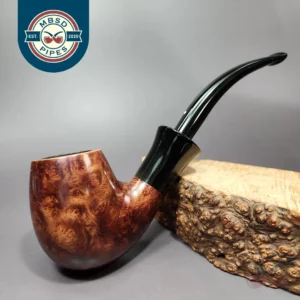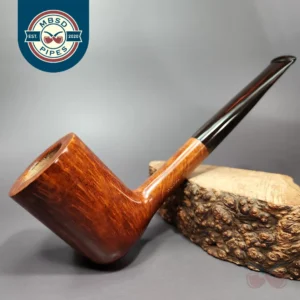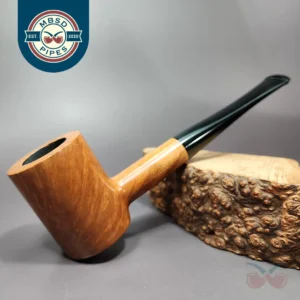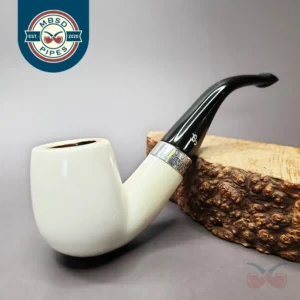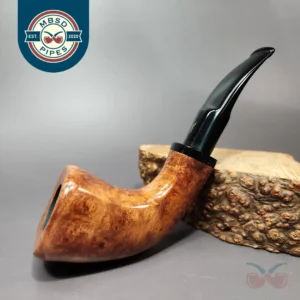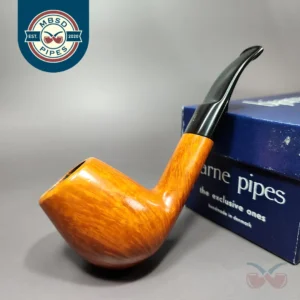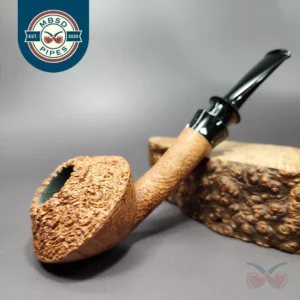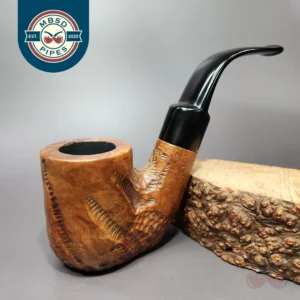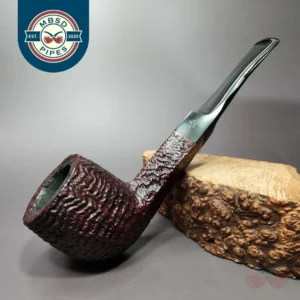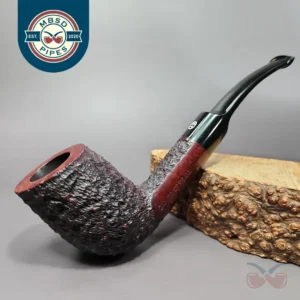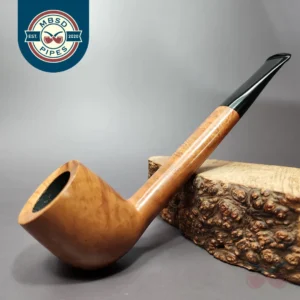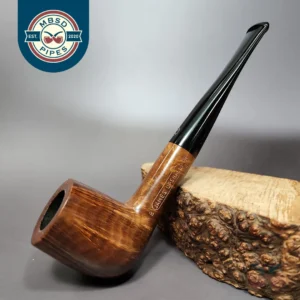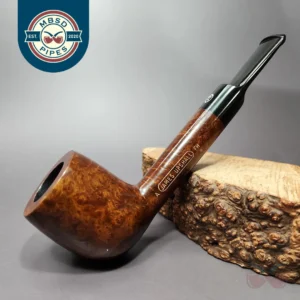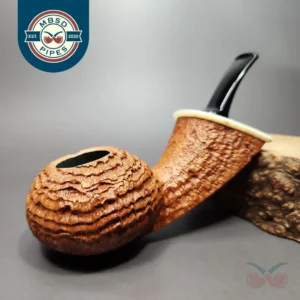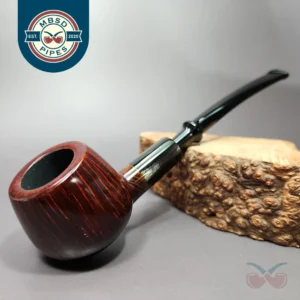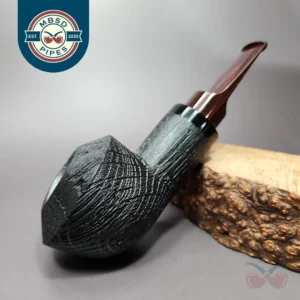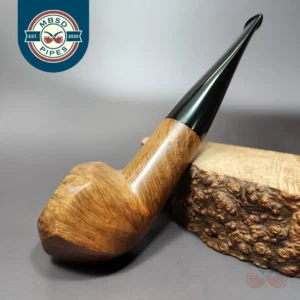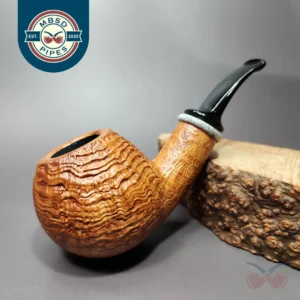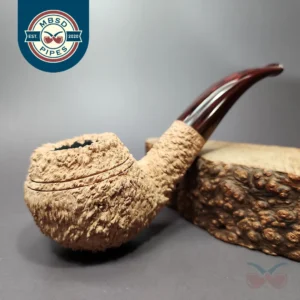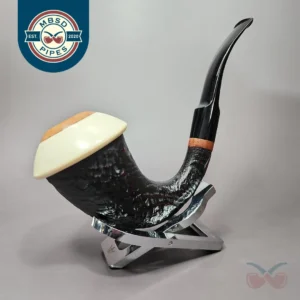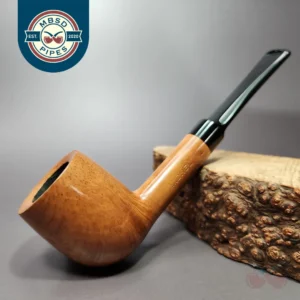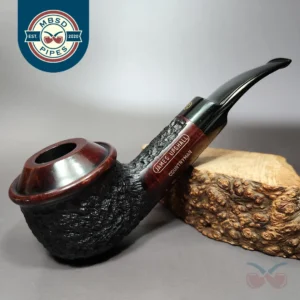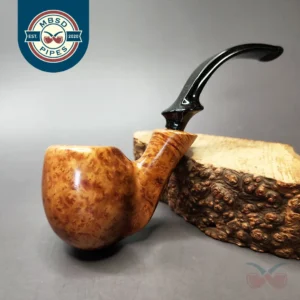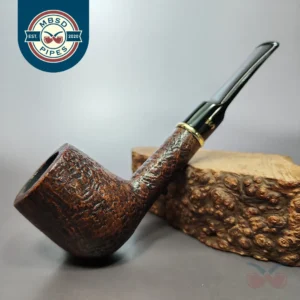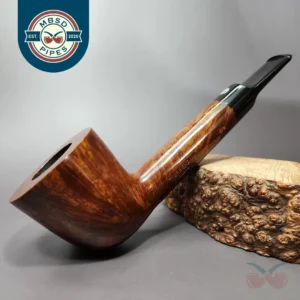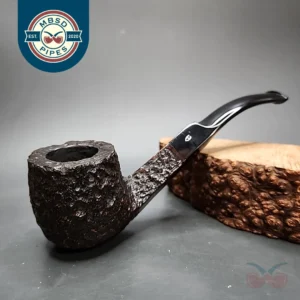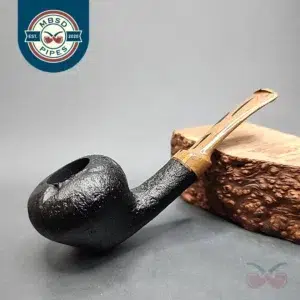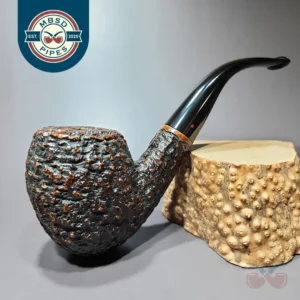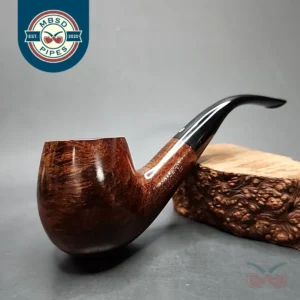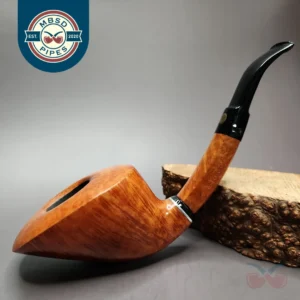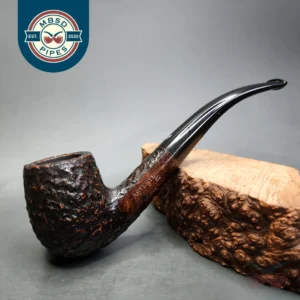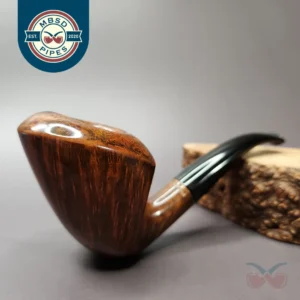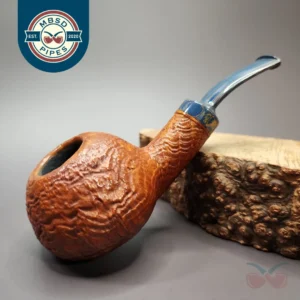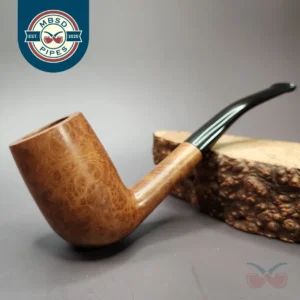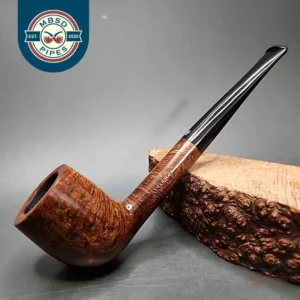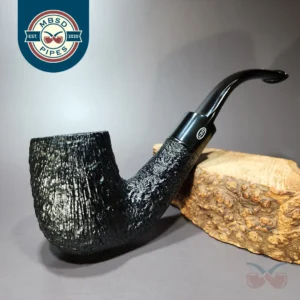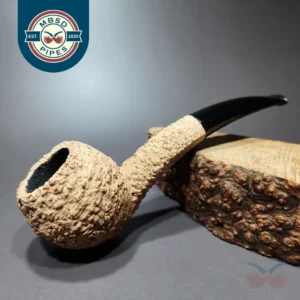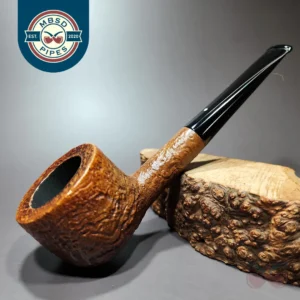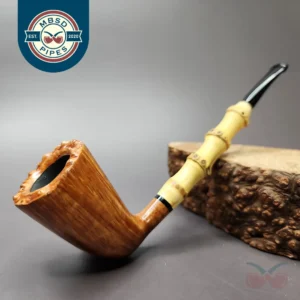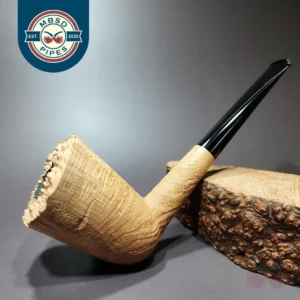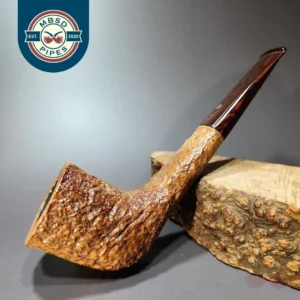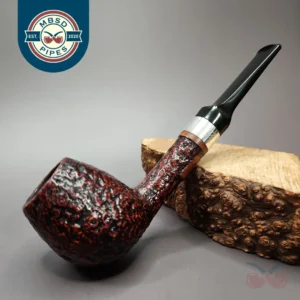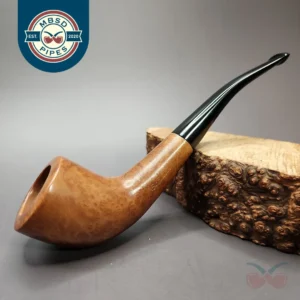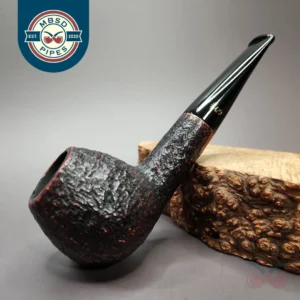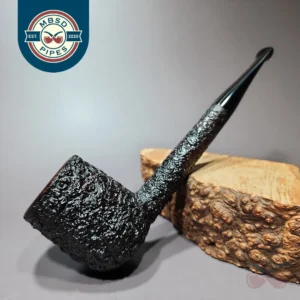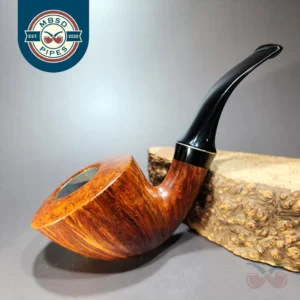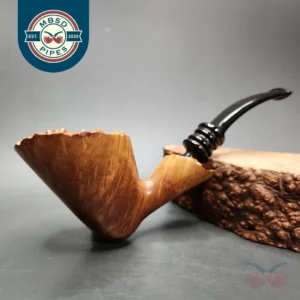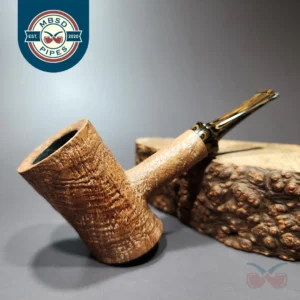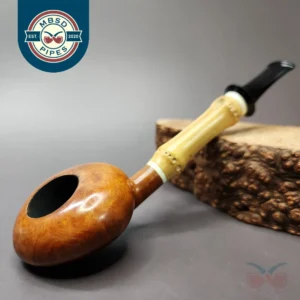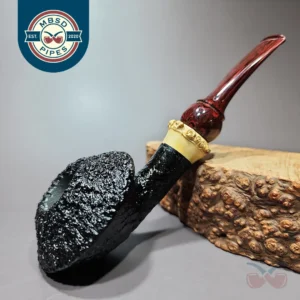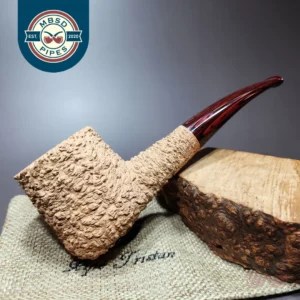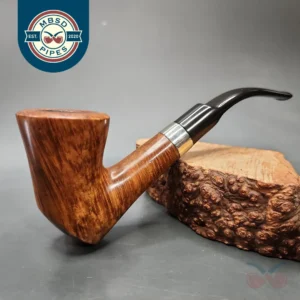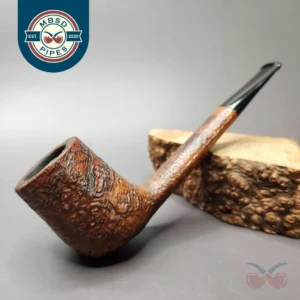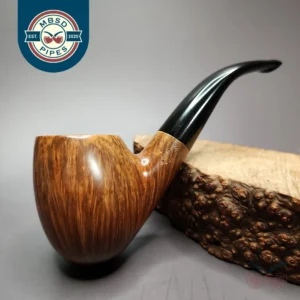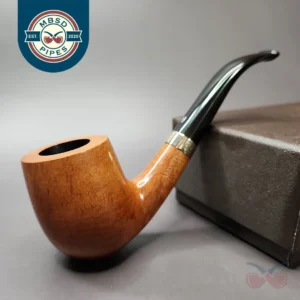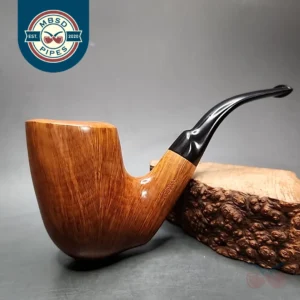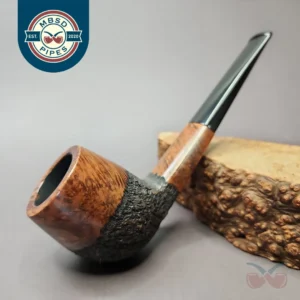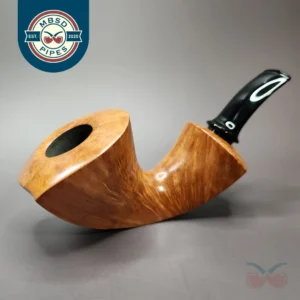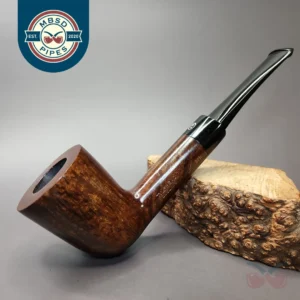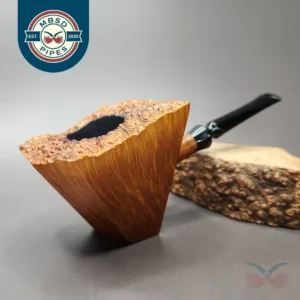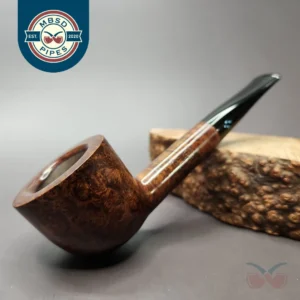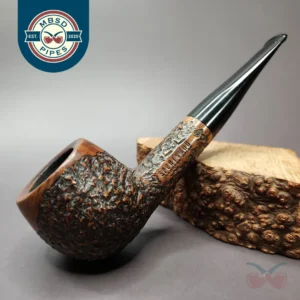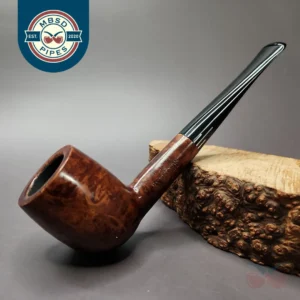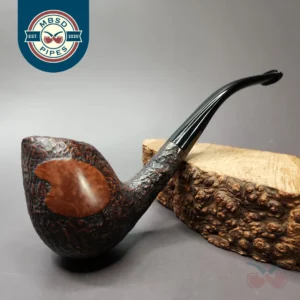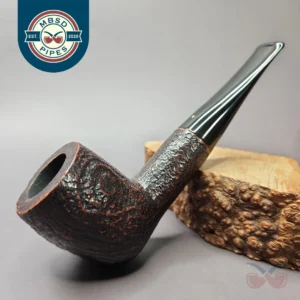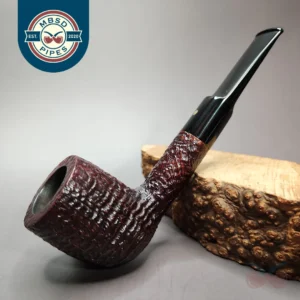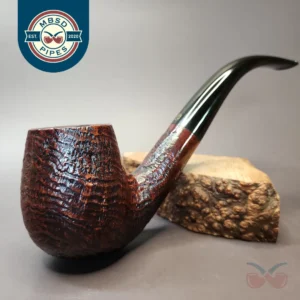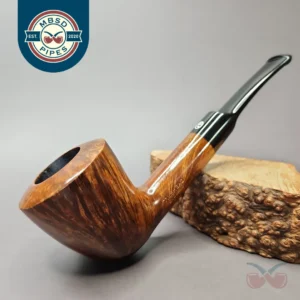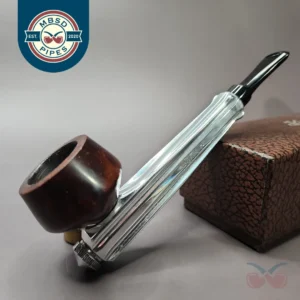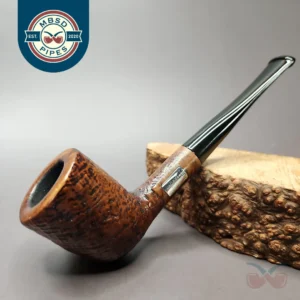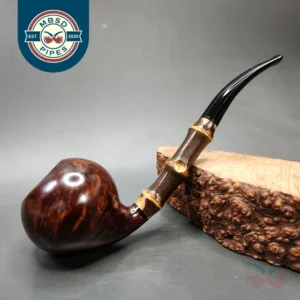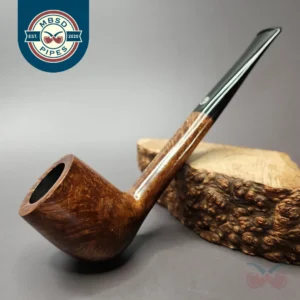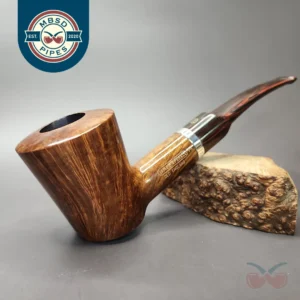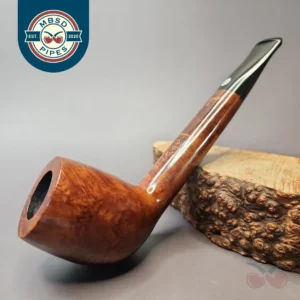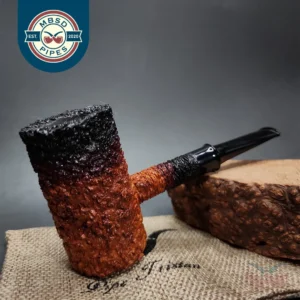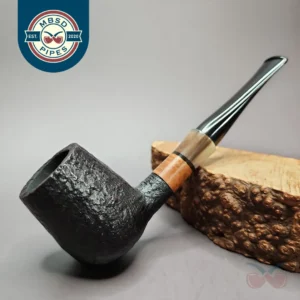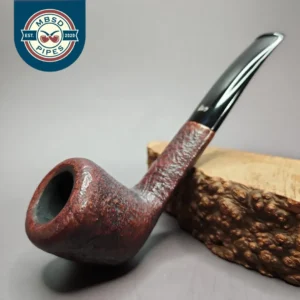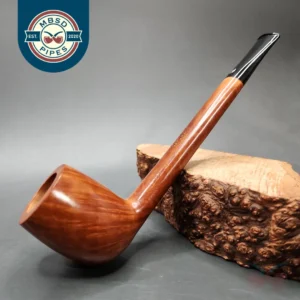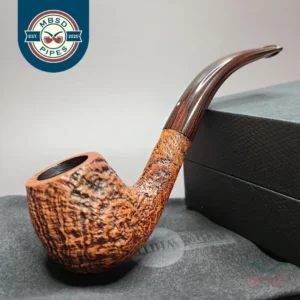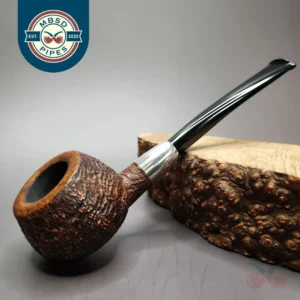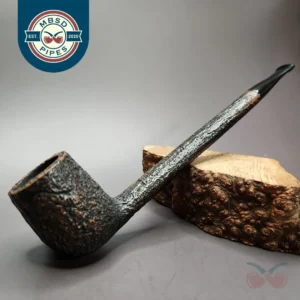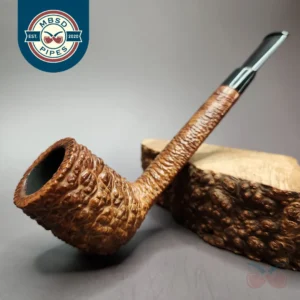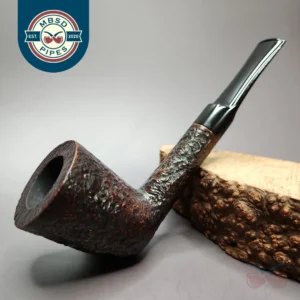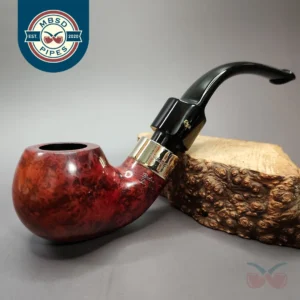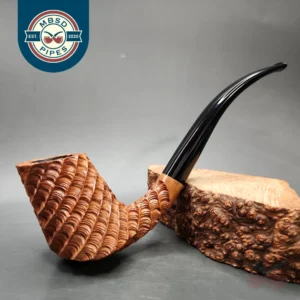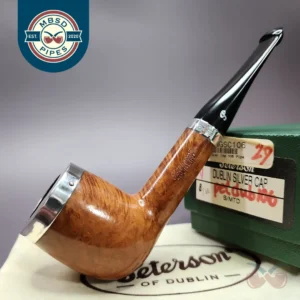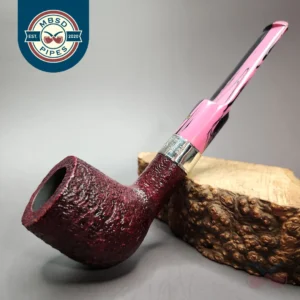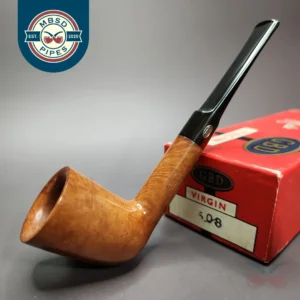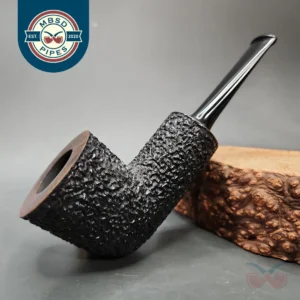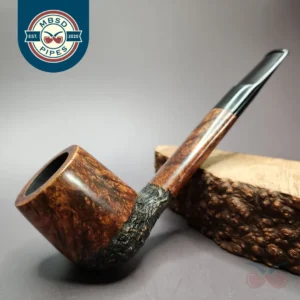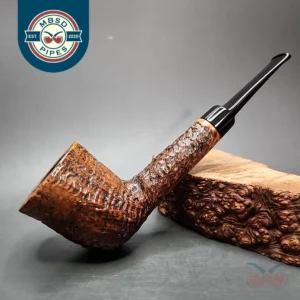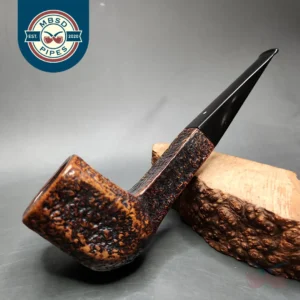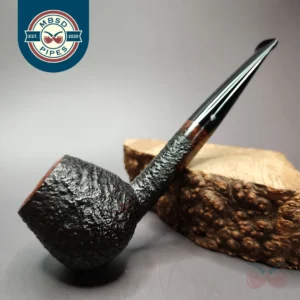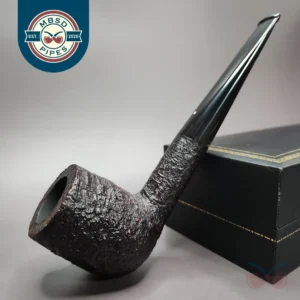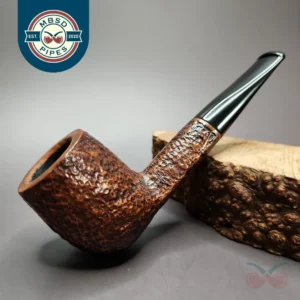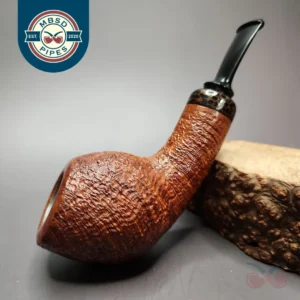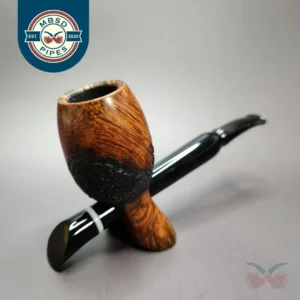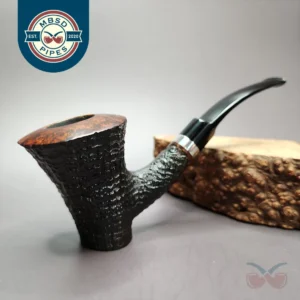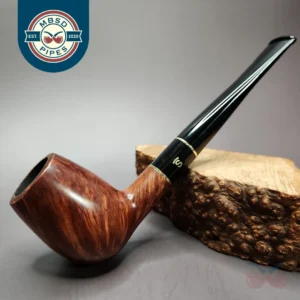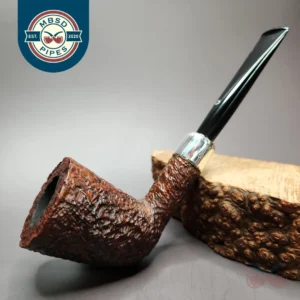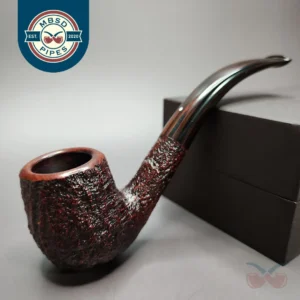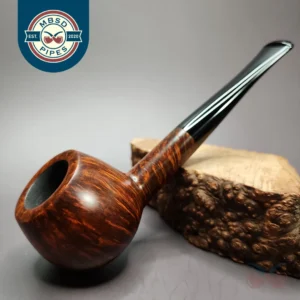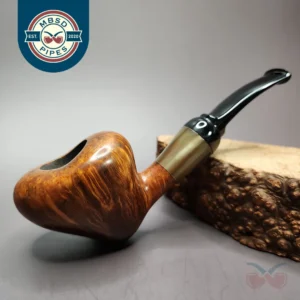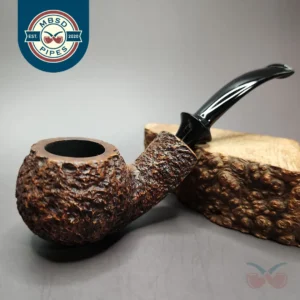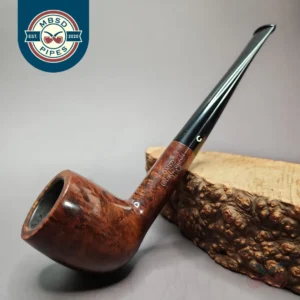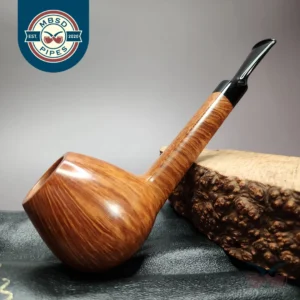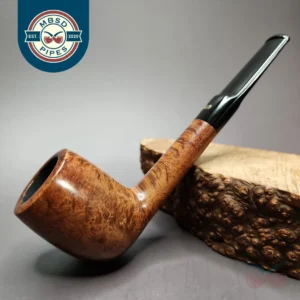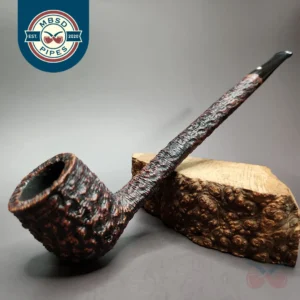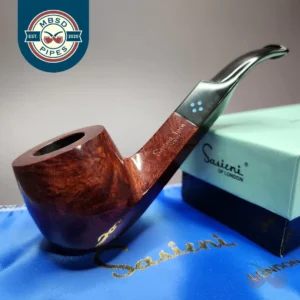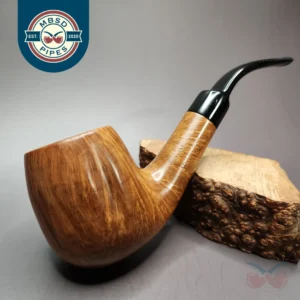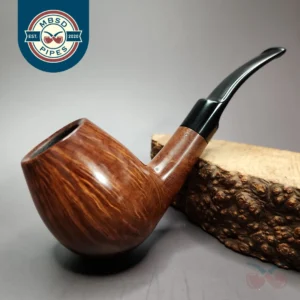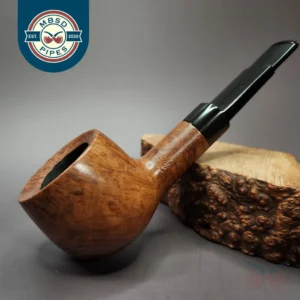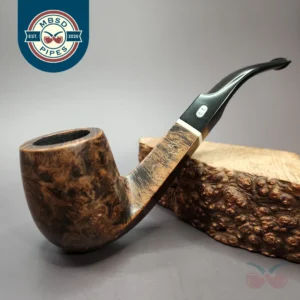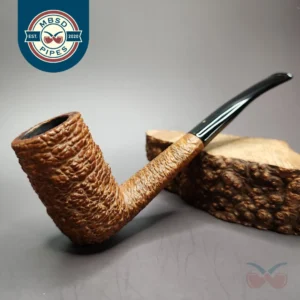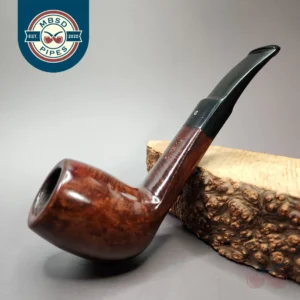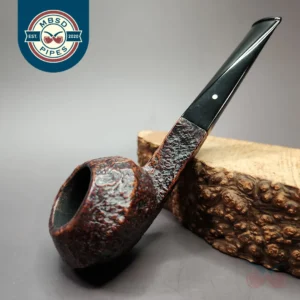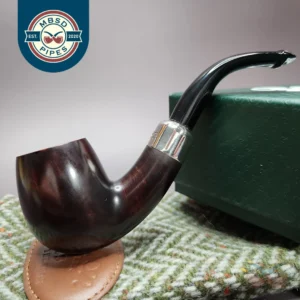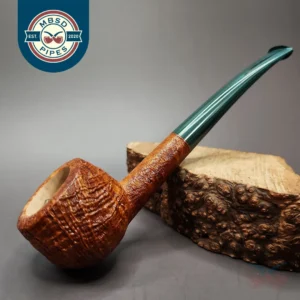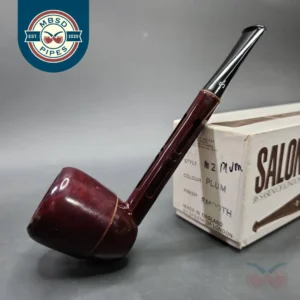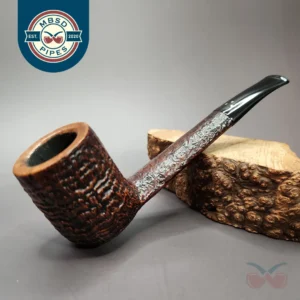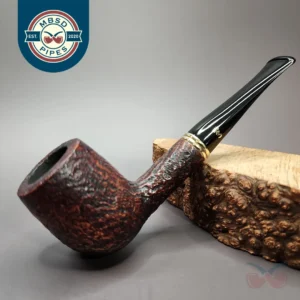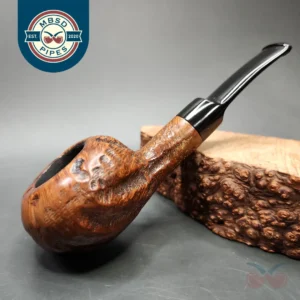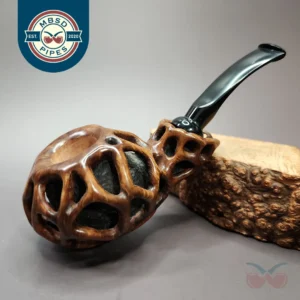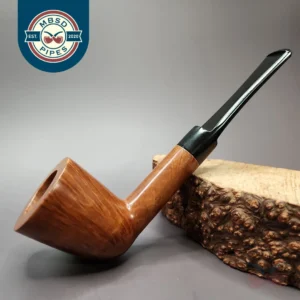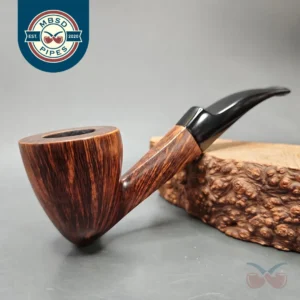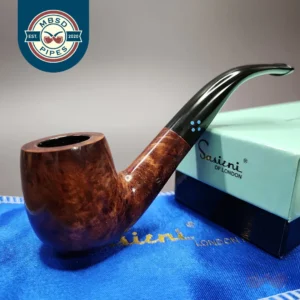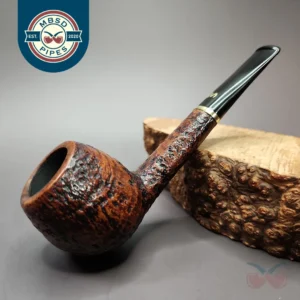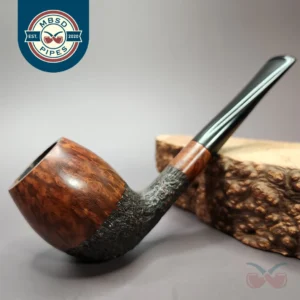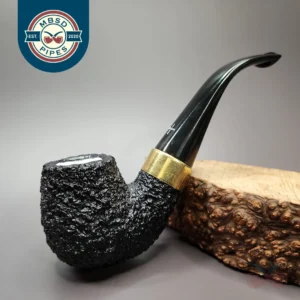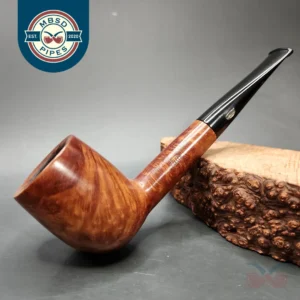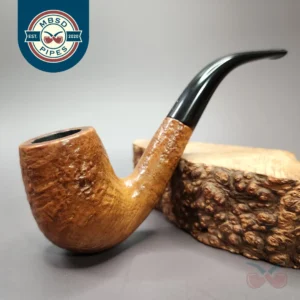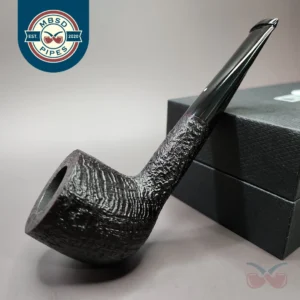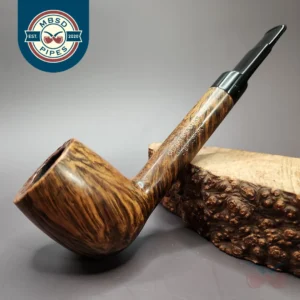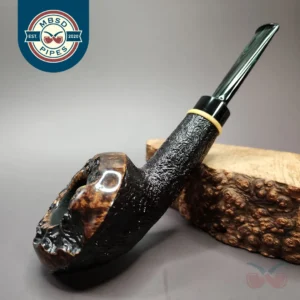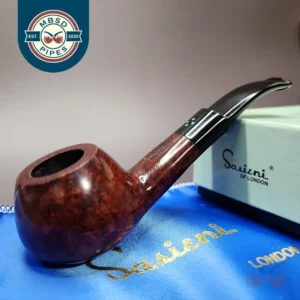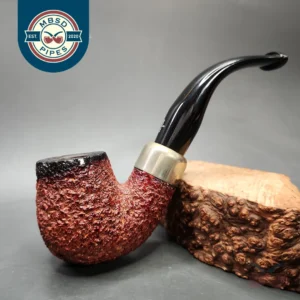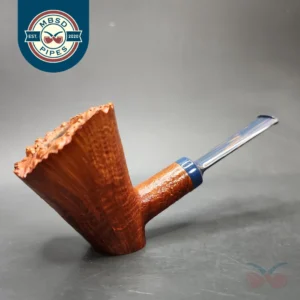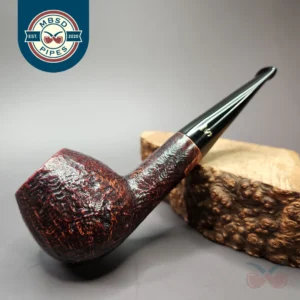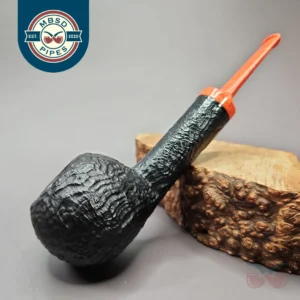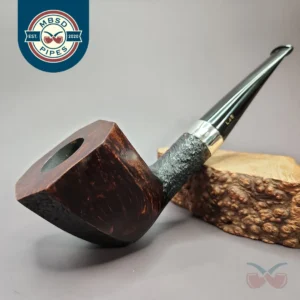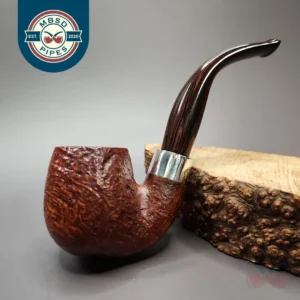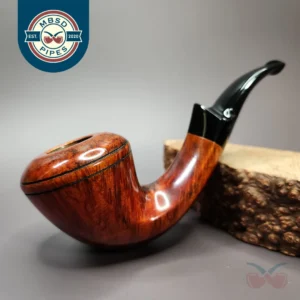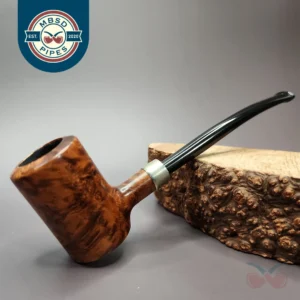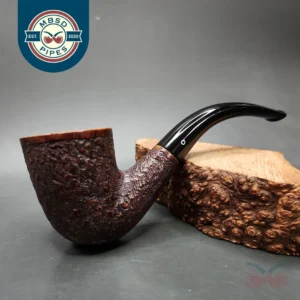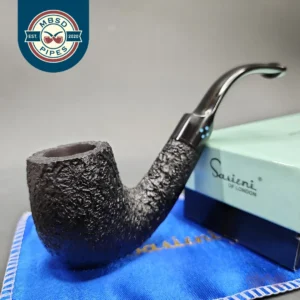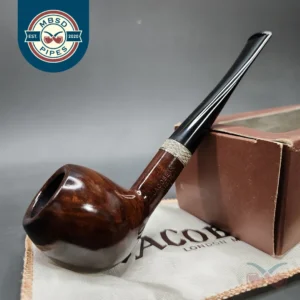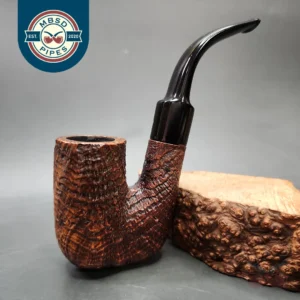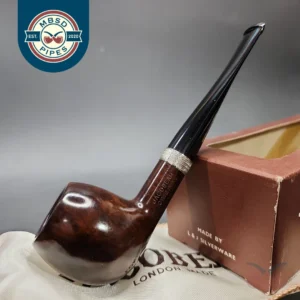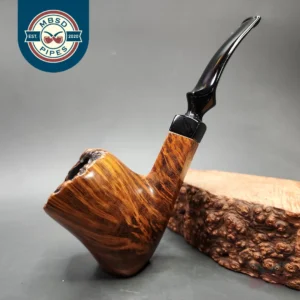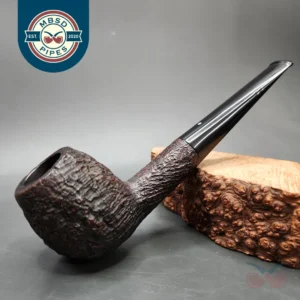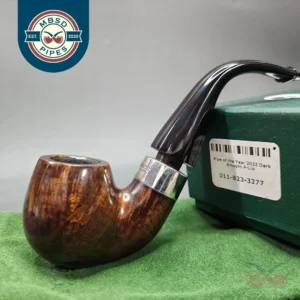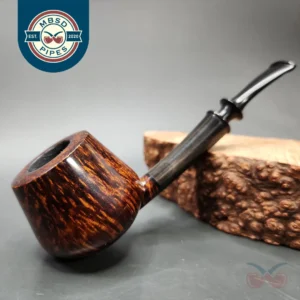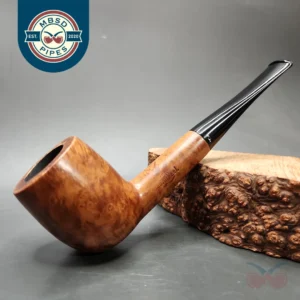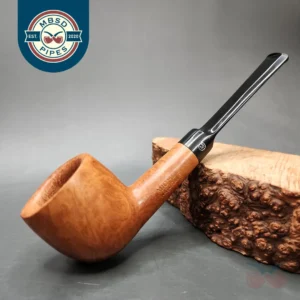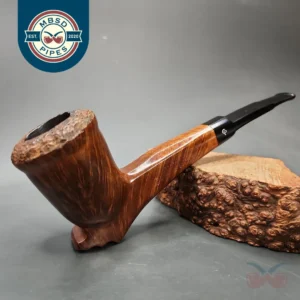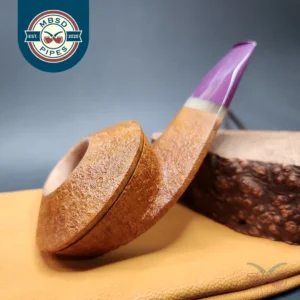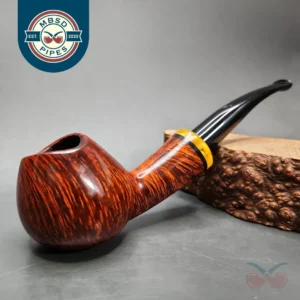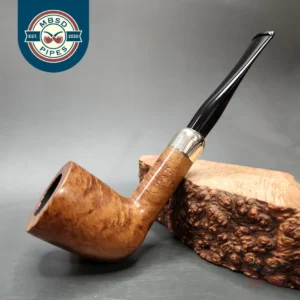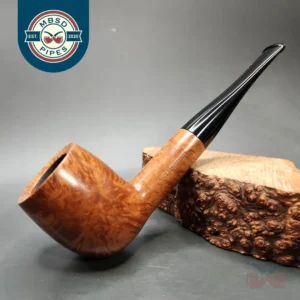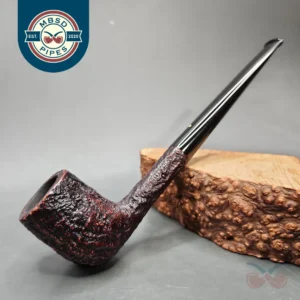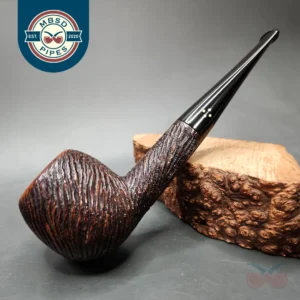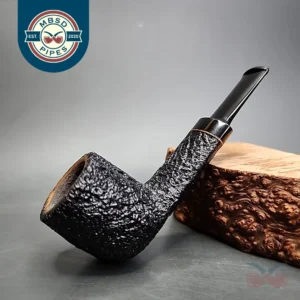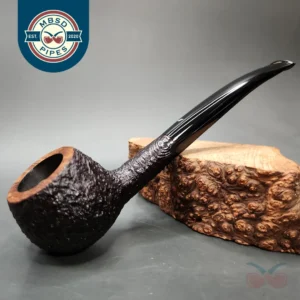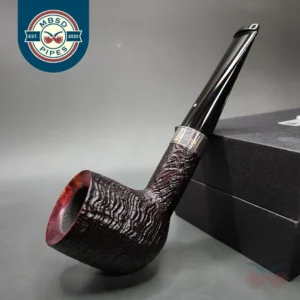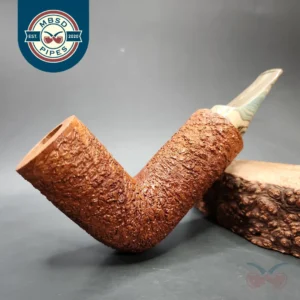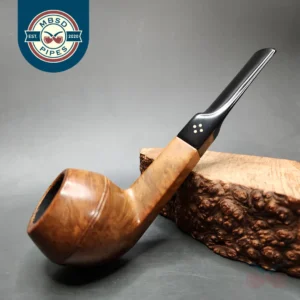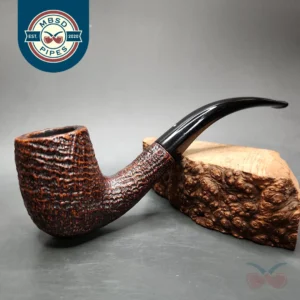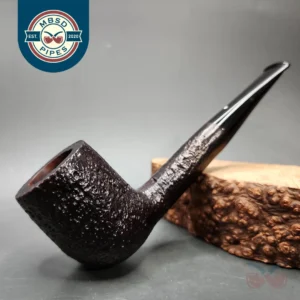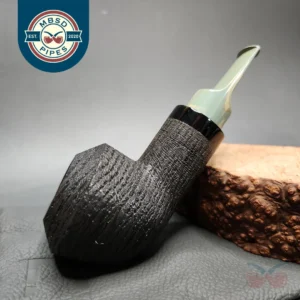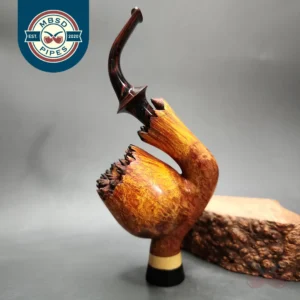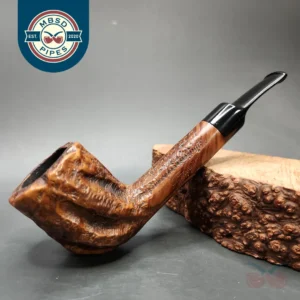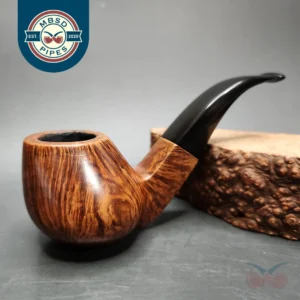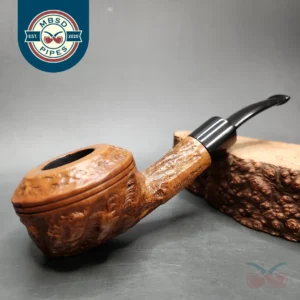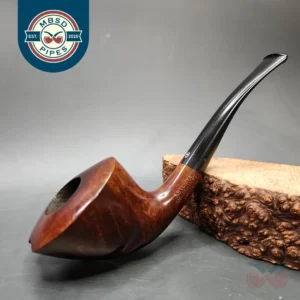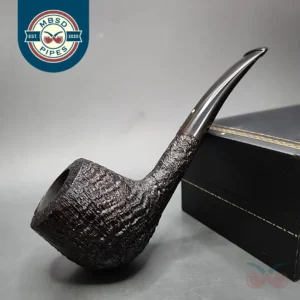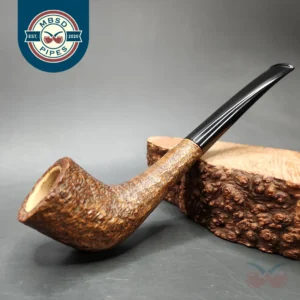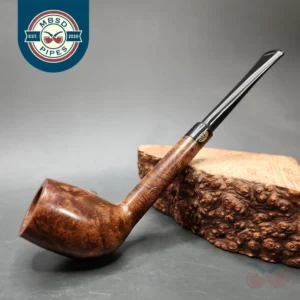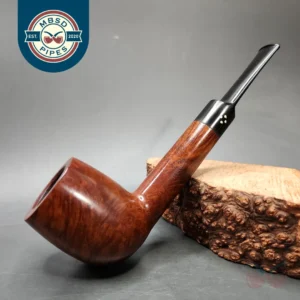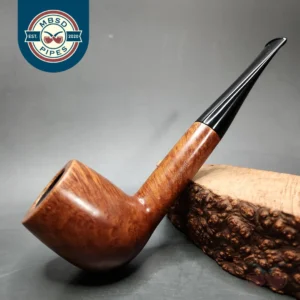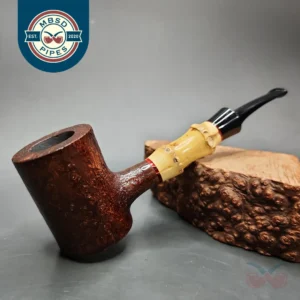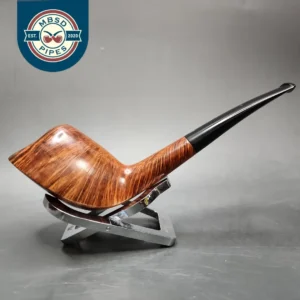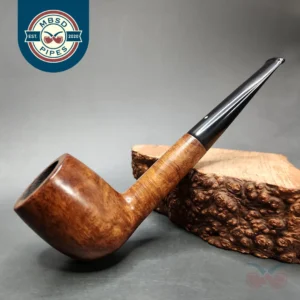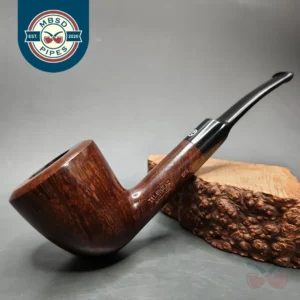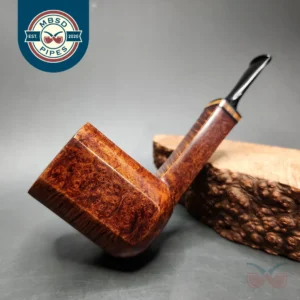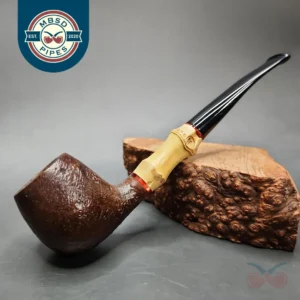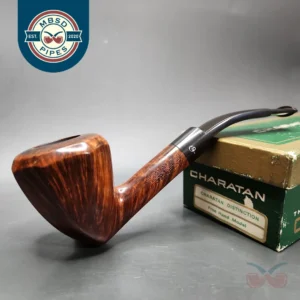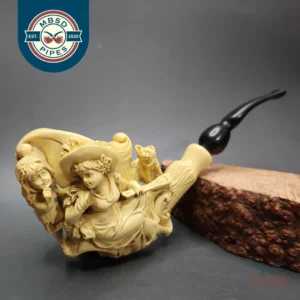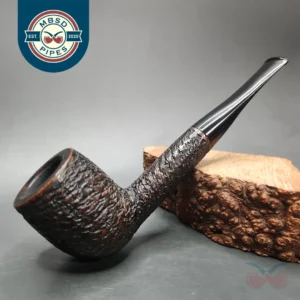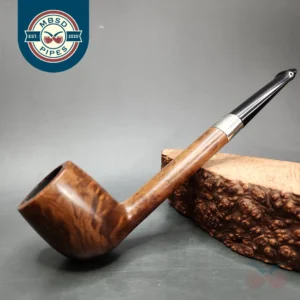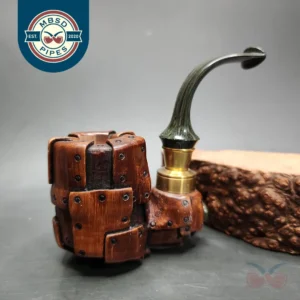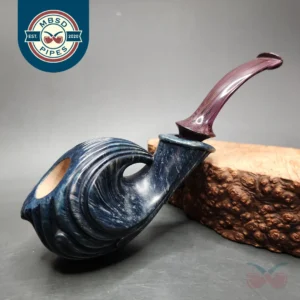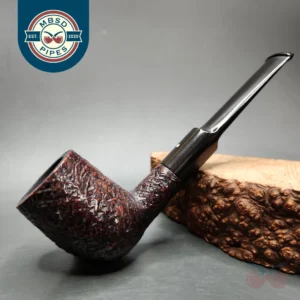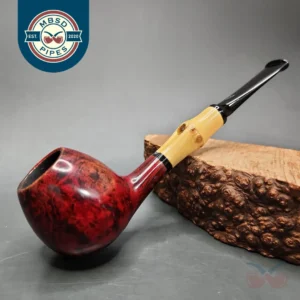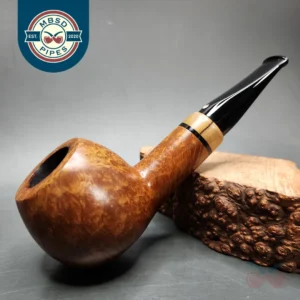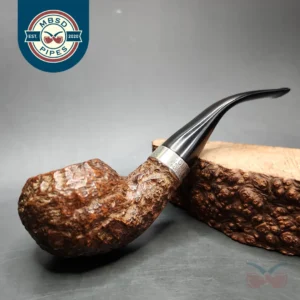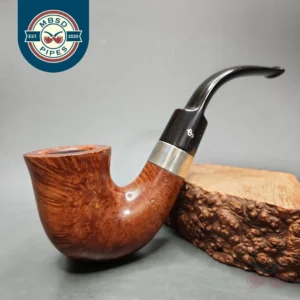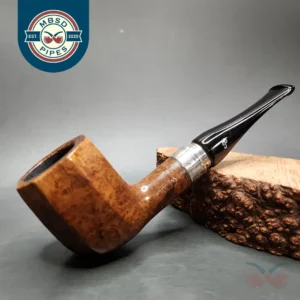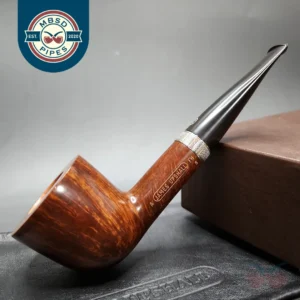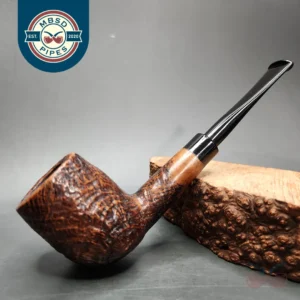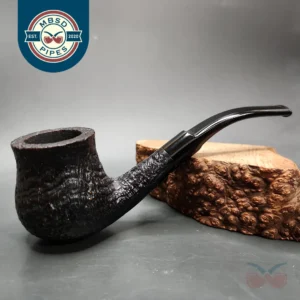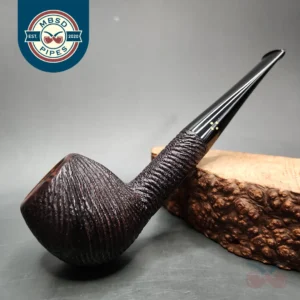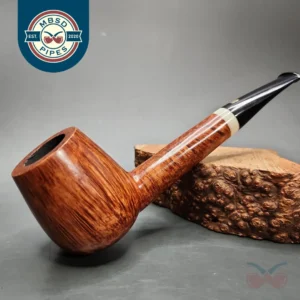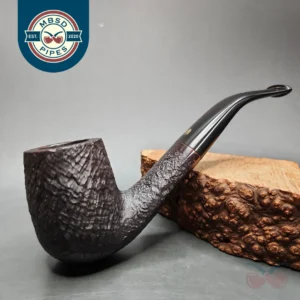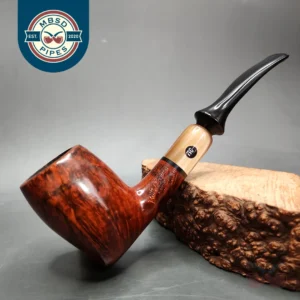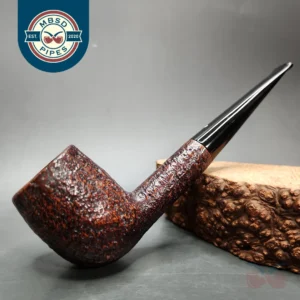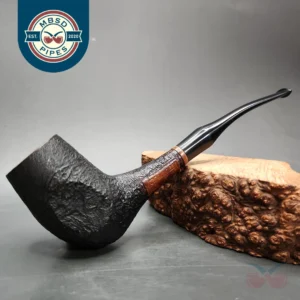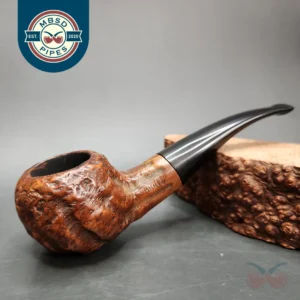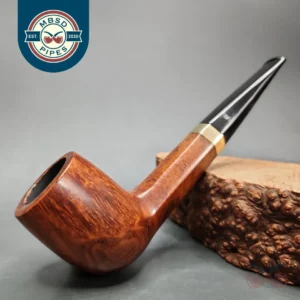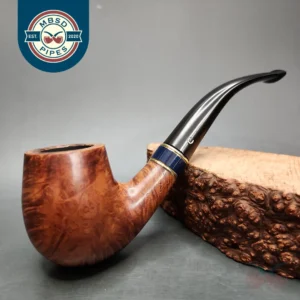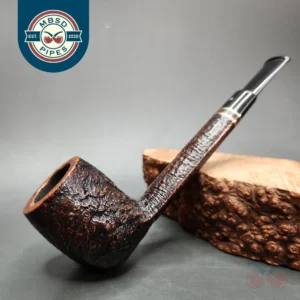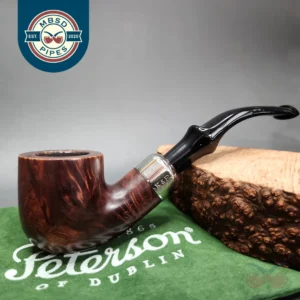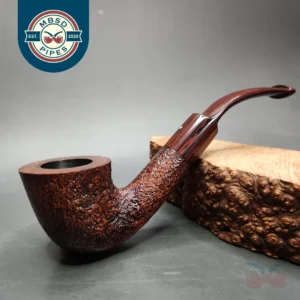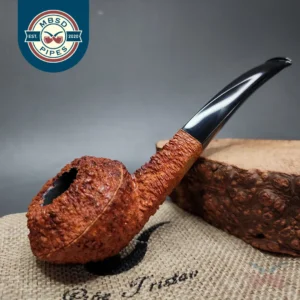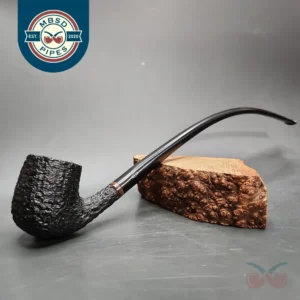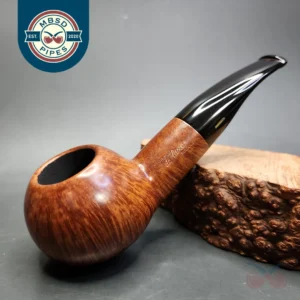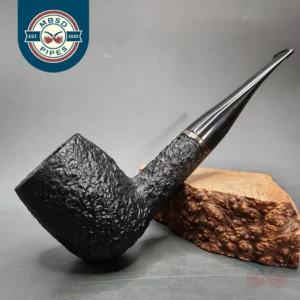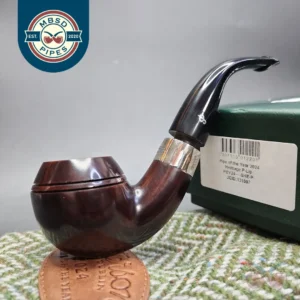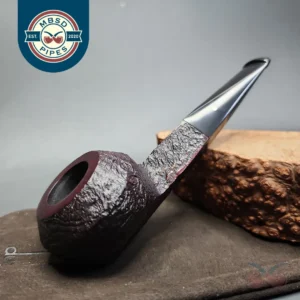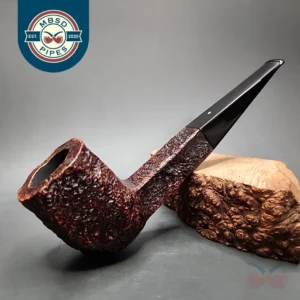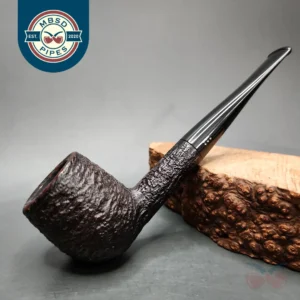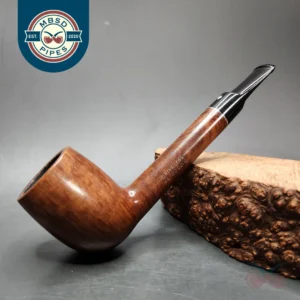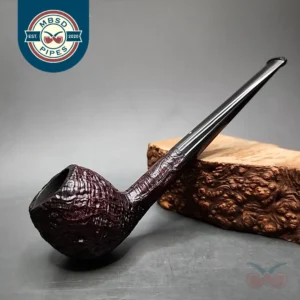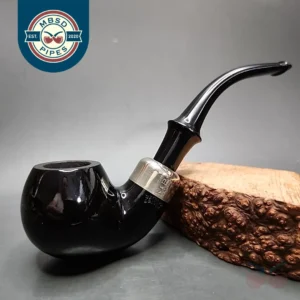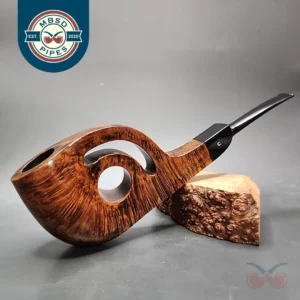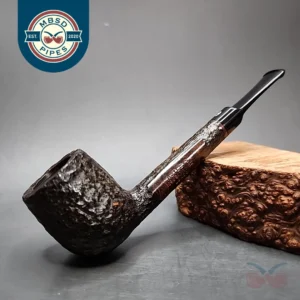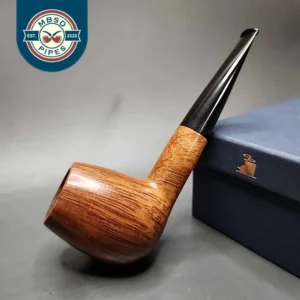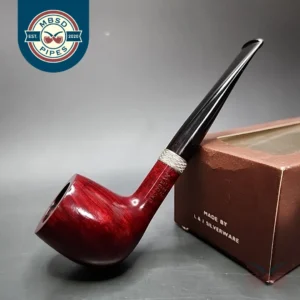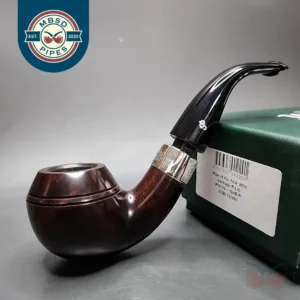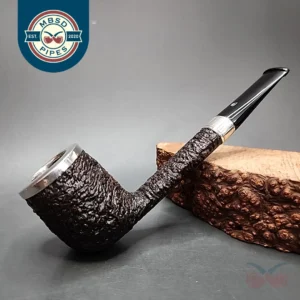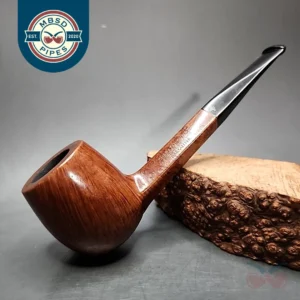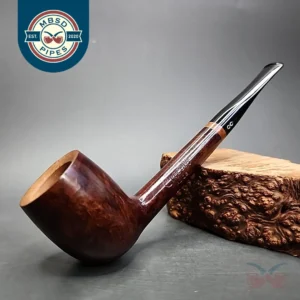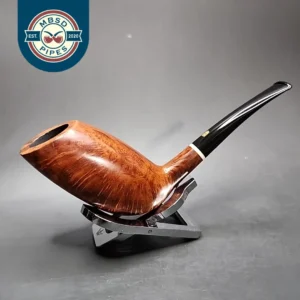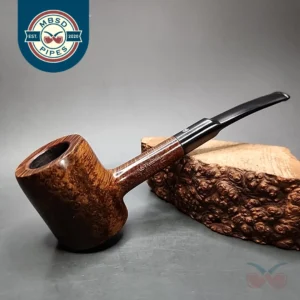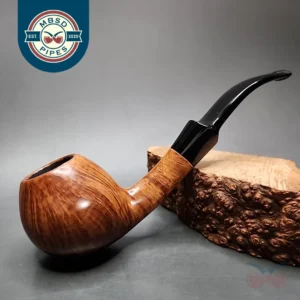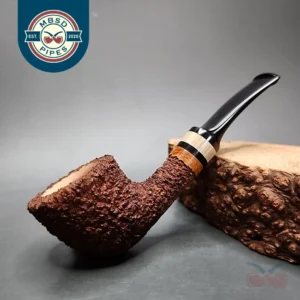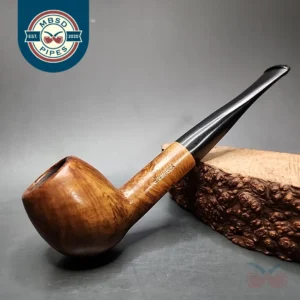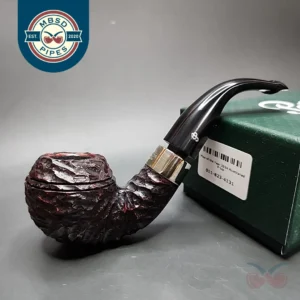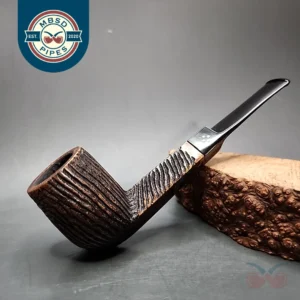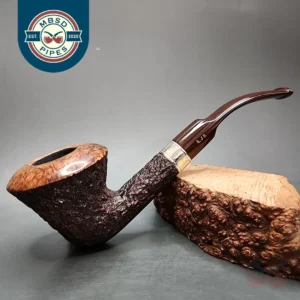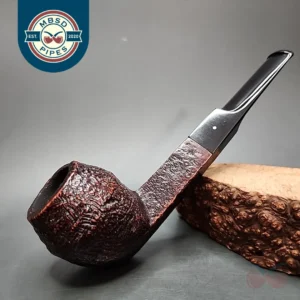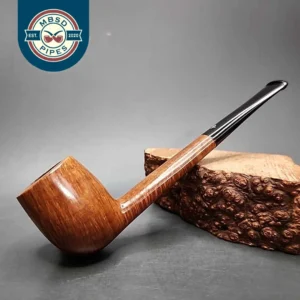Showing 501–1000 of 1245 resultsSorted by latest
-
To veteran pipe smokers, Dunhill needs no introduction. Beginning in 1907, Alfred Dunhill began selling Dunhill pipes at the tobacconist shop he owned on London’s Duke Street. Very quickly, these pipes gained the reputation of being the ‘Rolls-Royce’ of pipes due to how expertly crafted they were. Today, Dunhill is likely Britain’s most famous pipe…
-
Dave Neeb spent the first part of his life as an attorney. Upon retiring, however, he turned his hand to an altogether different vocation: pipes. First, Neeb was a pipe seller; he then learned the art of pipe restoration; finally, under the tutelage of Lee Von Erck and Rad Davis, he took up making artisan…
-
Michel pipes were store-brand pipes made for Maison Michel, a North Carolina (USA) tobacconist run by Michel J. Mitchell between 1951 and 1980. Over the years, several prominent pipe-makers made pipes for Maison Michel. Of all of the pipes that have come through over the years, Michel is one brand that has surprised me the…
-
Peterson pipes generally need no introduction, but just in case you’re unfamiliar: in 1876, a Latvian named Charles Peterson immigrated to Ireland and was hired making pipes in a workshop owned by Frederick and George Kapp. After rising through the ranks to become head craftsman, Peterson bought into the Kapp’s business, which was renamed, Kapp…
-
Nørding was founded by Erik Nørding in the 1960s, and is one of the oldest remaining companies to come out of the Scandinavian pipe-making renaissance that began in the mid-20th century. Now in his 80s, Erik Nørding is one of the most experienced and skilled pipe-makers in the world, and over the decades he has…
-
Bjarne Nielsen was one of the towering figures of Danish pipe-making until his passing in 2008. As the founder of Bjarne, Nielsen employed talented pipe-makers from Denmark to produce distinctly Danish pipes and sold them to a devoted international audience. Among those in his employ were figures such as Mogens Johansen (also known as Johs),…
-
Pipe Tristan is the name used by French artisan Tristan Lefebvre. Lefebvre is part of a new wave of hand made pipe carvers from the birthplace of briar, following in the footsteps of figures such as Alain Albuisson, Paul Lanier, and Pierre Morel Sr and Jr. Lefebvre credits a wide range of influences upon his…
-
Custom-Bilt (later, as in this case, Custombilt) pipes were originally created in the early 20th century by Tracy Mincer, an American pipe-maker. Later adopting the slogan, ‘As Individual as a Thumbprint,’ Custom-Bilts were each rusticated by hand, giving them their signature rugged look, and ensuring that no two Custom-Bilts were exactly alike. Today, these pipes…
-
‘BBB’ originally stood for ‘Blumfeld’s Best Briars’, so named after Louis Blumfeld after he took over the historic Alfred Frankenau Company in 1856. Later, the pipes came to be known as ‘Britain’s Best Briars’. Though the name might have changed, the quality of the pipes did not – they really were fantastic pipes, made in…
-
James Upshall was, along with Ferndown and Ashton, part of a new wave of British hand-made, high-grade pipes in the late 20th century, with their founders largely coming from previous positions in the factories of companies such as Dunhill and Charatan. James Upshall was founded in 1978 by Barry Jones and Ken Barnes, both of…
-
Michel pipes were store-brand pipes made for Maison Michel, a North Carolina (USA) tobacconist run by Michel J. Mitchell between 1951 and 1980. Over the years, several prominent pipe-makers made pipes for Maison Michel, such as Charatan, Barling, and others. Now this is what I’d call a clencher. A good size and bowl capacity, yet…
-
James Upshall was, along with Ferndown and Ashton, part of a new wave of British hand-made, high-grade pipes in the late 20th century, with their founders largely coming from previous positions in the factories of companies such as Dunhill and Charatan. James Upshall was founded in 1978 by Barry Jones and Ken Barnes, both of…
-
James Upshall was, along with Ferndown and Ashton, part of a new wave of British hand-made, high-grade pipes in the late 20th century, with their founders largely coming from previous positions in the factories of companies such as Dunhill and Charatan. James Upshall was founded in 1978 by Barry Jones and Ken Barnes, both of…
-
Born and raised in the small town of Gueydan, Louisana, Jay Mouton is an American artisan who works under the moniker of J. Mouton. Having crafted duck calls since he was a teenager, Mouton’s first forays into pipe-making began with carving tampers. Mouton’s unexpected successes with these handmade tampers allowed him to purchase the equipment…
-
Born and raised in the small town of Gueydan, Louisana, Jay Mouton is an American artisan who works under the moniker of J. Mouton. Having crafted duck calls since he was a teenager, Mouton’s first forays into pipe-making began with carving tampers. Mouton’s unexpected successes with these handmade tampers allowed him to purchase the equipment…
-
If you were to ask me how to best describe the pipes of Czech artisan Martin Čermák, I’d probably point to one of his Rhodesian shapes as a good indication. He’s got a real knack for playing with proportions, with this one showing off his predilection for shorter, stubbier designs that nonetheless carry a great…
-
Now here is a brand that I haven’t seen in a long time: Sébastien Beo. For those who were not keeping abreast of pipe developments in the early 2010s, Sébastien Beo was a project undertaken by Sébastien Beaud, a French pipe-maker otherwise responsible for the Genod brand. Amidst an ascendant Danish-American hegemony, Sébastien Beo pipes…
-
Born and raised in the small town of Gueydan, Louisana, Jay Mouton is an American artisan who works under the moniker of J. Mouton. Having crafted duck calls since he was a teenager, Mouton’s first forays into pipe-making began with carving tampers. Mouton’s unexpected successes with these handmade tampers allowed him to purchase the equipment…
-
Pipe Tristan is the name used by French artisan Tristan Lefebvre. Lefebvre is part of a new wave of up-and-coming hand made pipe carvers from the birthplace of briar, following in the footsteps of figures such as Alain Albuisson, Paul Lanier, and Pierre Morel Sr and Jr. Lefebvre credits a wide range of influences upon…
-
While China has long been associated with cheaper factory pipes, a new generation of artisans and workshops have emerged over the past decade, producing some genuinely excellent pipes. HS Studio is an example of the latter, being a Hong Kong workshop dedicated to crafting handmade briars, typically in shapes and styles reminiscent of the post-war…
-
Michel pipes were store-brand pipes made for Maison Michel, a North Carolina (USA) tobacconist run by Michel J. Mitchell between 1951 and 1980. Over the years, several prominent pipe-makers made pipes for Maison Michel. Of all of the pipes that have come through over the years, Michel is one brand that has surprised me the…
-
James Upshall was, along with Ferndown and Ashton, part of a new wave of British hand-made, high-grade pipes in the late 20th century, with their founders largely coming from previous positions in the factories of companies such as Dunhill and Charatan. James Upshall was founded in 1978 by Barry Jones and Ken Barnes, both of…
-
Though he would tragically pass away at the age of 42, Preben Holm was one of the pioneering figures in the ‘Danish design’ movement in 20th century pipe-making – a movement that still dominates the high-grade pipe scene. By hand-shaping his pipes on a belt sander, Holm was able to make the most of the…
-
Stanwell is one of Denmark’s most celebrated and enduring pipe companies, having been founded by Poul Nielsen shortly after the second world war. Over the last six decades, Stanwell has established itself as both a leader in innovative Danish design and for producing well-priced pipes with precision construction and engineering. Many of its designs were…
-
James Upshall was, along with Ferndown and Ashton, part of a new wave of British hand-made, high-grade pipes in the late 20th century, with their founders largely coming from previous positions in the factories of companies such as Dunhill and Charatan. James Upshall was founded in 1978 by Barry Jones and Ken Barnes, both of…
-
Astleys was one of London’s historic pipe and tobacco shops. Like many pipe tobacconists, its owners had pipes made specially to be sold under the shop’s name. Astleys pipes, however, were made by some of the premier pipe manufacturers and artisans in the UK, such as Dunhill, Charatan, Les Wood and Dolly Wood of Ferndown,…
-
Over the last decade, Sean Reum has emerged as one of North America’s most admired and in-demand pipe-makers, with his fans including, among many others, the one and only G.L. Pease. Having followed Reum’s career for many years, including catching a few glimpses of the artisan in his Montana workshop, I’m happy to say that…
-
Alongside Julius Vesz, Phillip Trypis, and John Calich, Blatter is one of the pre-eminent names within the history of Canadian handmade pipes. But it is the Blatter name that has thus far endured for the longest time within that history. This is because the Blatter family have been in the business of making and selling…
-
Astleys was one of London’s most historic pipe and tobacco shops. Like many pipe tobacconists, its owners had pipes made specially to be sold under the shop’s name. Astleys pipes, however, were made by some of the premier pipe manufacturers and artisans in the UK, such as Dunhill, Charatan, Les Wood, and Ken Barnes and…
-
Like Castello, Mastro de Paja holds a special place in the world of Italian high-grade pipe workshops. Founded in 1972 by Giancarlo Guidi, the MdP team was soon joined by Giannino Spadoni and Bruto Sordini with the Guidi and Spadoni at the helm of the company until 1981. Guidi then left with Sordini to found…
-
Astleys was one of London’s most historic pipe and tobacco shops. Like many pipe tobacconists, its owners had pipes made specially to be sold under the shop’s name. Astleys pipes, however, were made by some of the premier pipe manufacturers and artisans in the UK, such as Dunhill, Charatan, Les Wood and Dolly Wood of…
-
WO Larsen was a tobacconist in Copenhagen Denmark. In the 1960s, when Danish-style pipes were becoming highly sought after, thanks to revolutionary pipe-makers such as Sixten Ivarsson, a workshop was set up on the Larsen premises to produce enough high-grade Danish pipes to meet demand. This workshop was staffed by the emerging masters of Danish…
-
Sebastian Heck is part of younger generation of highly skilled artisans to have emerged from Germany in recent years. Based in Heidelberg, Heck took up pipe smoking—and, ultimately, pipe-making—as part of a conscious effort toward slowing down in an otherwise constantly accelerating modern world. Like many pipe-makers, Heck took his first steps into the craft as a…
-
Schulte’s was an American pipe tobacconist, located in New Jersey in the second half of the 20th century. Like many pipe stores, Schulte’s sold house brand pipes, but unlike most pipe stores, many of these house brand pipes were made by the store’s owner, Max Schulte. Similarly to a few other American pipe tobacconists, like…
-
Astleys was one of London’s most historic pipe and tobacco shops. Like many pipe tobacconists, its owners had pipes made specially to be sold under the shop’s name. Astleys pipes, however, were made by some of the premier pipe manufacturers and artisans in the UK, such as Dunhill, Charatan, Les Wood and Dolly Wood of…
-
GBD was one of several prominent examples of a French pipe brand that, due to certain circumstances, became a maker most associated with classic ‘British’ pipes. Founded in 1850 by the French trio Ganneval, Bondier & Donninger, the brand was bought by English company Oppenheimer at the beginning of the 20th century, who opened factories…
-
Pipe Tristan is the name used by French artisan Tristan Lefebvre. Lefebvre is part of a new wave of up-and-coming hand made pipe carvers from the birthplace of briar, following in the footsteps of figures such as Alain Albuisson, Paul Lanier, and Pierre Morel Sr and Jr. Lefebvre credits a wide range of influences upon…
-
To veteran pipe smokers, Dunhill needs no introduction. Beginning in 1907, Alfred Dunhill began selling Dunhill pipes at the tobacconist shop he owned on London’s Duke Street. Very quickly, these pipes gained the reputation of being the ‘Rolls-Royce’ of pipes due to how expertly crafted they were. Today, Dunhill is likely Britain’s most famous pipe…
-
While China has long been associated with cheaper factory pipes, a new generation of artisans and workshops have emerged over the past decade, producing some genuinely excellent pipes. HS Studio is an example of the latter, being a Hong Kong workshop dedicated to crafting handmade briars, typically in shapes and styles reminiscent of the post-war…
-
Pipe Tristan is the name used by French artisan Tristan Lefebvre. Lefebvre is part of a new wave of up-and-coming hand made pipe carvers from the birthplace of briar, following in the footsteps of figures such as Alain Albuisson, Paul Lanier, and Pierre Morel Sr and Jr. Lefebvre credits a wide range of influences upon…
-
Ashton is an English pipe brand created by William Ashton Taylor, a former Dunhill pipe-maker who left Dunhill in the 1980s to make pipes under his own name. Along with other pipe-makers such as Ken Barnes and Barry Jones of James Upshall and Les Wood of Ferndown, Ashton emerged as part of a new wave…
-
WO Larsen was a tobacconist in Copenhagen Denmark. In the 1960s, when Danish-style pipes were becoming highly sought after, thanks to revolutionary pipe-makers such as Sixten Ivarsson, a workshop was set up on the Larsen premises to produce enough high-grade Danish pipes to meet demand. This workshop was staffed by the emerging masters of Danish…
-
Schulte’s was an American pipe tobacconist, located in New Jersey in the second half of the 20th century. Like many pipe stores, Schulte’s sold house brand pipes, but unlike most pipe stores, many of these house brand pipes were made by the store’s owner, Max Schulte. Similarly to a few other American pipe tobacconists, like…
-
Stanwell is one of Denmark’s most celebrated and enduring pipe companies, having been founded by Poul Nielsen shortly after the second world war. Over the last six decades, Stanwell has established itself as both a leader in innovative Danish design and for producing well-priced pipes with precision construction and engineering. Many of its designs were…
-
Born and raised in the small town of Gueydan, Louisana, Jay Mouton is an American artisan who works under the moniker of J. Mouton. Having crafted duck calls since he was a teenager, Mouton’s first forays into pipe-making began with carving tampers. Mouton’s unexpected successes with these handmade tampers allowed him to purchase the equipment…
-
Born and raised in the small town of Gueydan, Louisana, Jay Mouton is an American artisan who works under the moniker of J. Mouton. Having crafted duck calls since he was a teenager, Mouton’s first forays into pipe-making began with carving tampers. Mouton’s unexpected successes with these handmade tampers allowed him to purchase the equipment…
-
Tsuge is Japan’s largest and most internationally renowned pipe company, having been founded in 1936 by Kyoichiro Tsuge. In the 1970s, however, Tsuge himself was so impressed by the pipes coming out of Denmark, that he sent two of Tsuge’s own master pipe-makers, Kazuhiro Fukuda and Smio Satou, to hone their craft under the likes…
-
James Upshall was, along with Ferndown and Ashton, part of a new wave of British hand-made, high-grade pipes in the late 20th century, with their founders largely coming from previous positions in the factories of companies such as Dunhill and Charatan. James Upshall was founded in 1978 by Barry Jones and Ken Barnes, both of…
-
Schulte’s was an American pipe tobacconist, located in New Jersey in the second half of the 20th century. Like many pipe stores, Schulte’s sold house brand pipes, but unlike most pipe stores, many of these house brand pipes were made by the store’s owner, Max Schulte. Similarly to a few other American pipe tobacconists, like…
-
I’ve been wondering when we might get one of these come through. For those not in the know, Smith House Pipes are made by American artisan Rich Rosselli, in his workshop in Long Island, New York. His designs tend to lean toward the functionalist school, but are distinguished by their explorations of novel color palettes….
-
To veteran pipe smokers, Dunhill needs no introduction. Beginning in 1907, Alfred Dunhill began selling Dunhill pipes at the tobacconist shop he owned on London’s Duke Street. Very quickly, these pipes gained the reputation of being the ‘Rolls-Royce’ of pipes due to how expertly crafted they were. Today, Dunhill is likely Britain’s most famous pipe…
-
Ichi Kitahara is a Japanese pipe-maker, but he’s also something of a renaissance man. He is classically trained in fine art; he has spent time as a high-end jeweler and silversmith; he has also worked as an Itame, the Japanese name for a particularly skilled sushi chef; and last, but not least, he is an artisan…
-
Pipe Tristan is the name used by French artisan Tristan Lefebvre. Lefebvre is part of a new wave of up-and-coming hand made pipe carvers from the birthplace of briar, following in the footsteps of figures such as Alain Albuisson, Paul Lanier, and Pierre Morel Sr and Jr. Lefebvre credits a wide range of influences upon…
-
Pipe Tristan is the name used by French artisan Tristan Lefebvre. Lefebvre is part of a new wave of up-and-coming hand made pipe carvers from the birthplace of briar, following in the footsteps of figures such as Alain Albuisson, Paul Lanier, and Pierre Morel Sr and Jr. Lefebvre credits a wide range of influences upon…
-
GBD was one of several prominent examples of a French pipe brand that, due to certain circumstances, became a maker most associated with classic ‘British’ pipes. Founded in 1850 by the French trio Ganneval, Bondier & Donninger, the brand was bought by English company Oppenheimer at the beginning of the 20th century, who opened factories…
-
WO Larsen was a tobacconist in Copenhagen Denmark. In the 1960s, when Danish-style pipes were becoming highly sought after, thanks to revolutionary pipe-makers such as Sixten Ivarsson, a workshop was set up on the Larsen premises to produce enough high-grade Danish pipes to meet demand. This workshop was staffed by the emerging masters of Danish…
-
Age (or rather, Åge) Bogelund is a somewhat less known carver from the 20th century Danish pipe-making tradition – though he was no less a master than his contemporaries. Originally, he worked for Viggo Nielsen’s Bari pipe company, being charged with making some of its higher-grade freehands. Later, Bogelund made pipes under his own name,…
-
Astleys was one of London’s most historic pipe and tobacco shops. Like many pipe tobacconists, its owners had pipes made specially to be sold under the shop’s name. Astleys pipes, however, were made by some of the premier pipe manufacturers and artisans in the UK, such as Dunhill, Charatan, Les Wood, and Ken Barnes and…
-
It is probably fair to say that Savinelli is Italy’s most famous pipe brand. Founded in Milan in 1876 by Achille Savinelli, the brand has continuously offered high quality pipes for nearly 150 years. Though various Savinelli lines have come and gone over the years, the brand has always been notable for putting out classically…
-
A graduate of industrial design and art history, Xin Li came to pipe-making by chance, after a mutual friend introduced him to the notable Chinese artisan Yang Zhimin. Xin and Yang quickly developed a rapport, in part because both had attended the prestigious China Academy of Art, and because both had an affinity for woodworking….
-
WO Larsen was a tobacconist in Copenhagen Denmark. In the 1960s, when Danish-style pipes were becoming highly sought after, thanks to revolutionary pipe-makers such as Sixten Ivarsson, a workshop was set up on the Larsen premises to produce enough high-grade Danish pipes to meet demand. This workshop was staffed by the emerging masters of Danish…
-
While China has long been associated with cheaper factory pipes, a new generation of artisans and workshops have emerged over the past decade, producing some genuinely excellent pipes. HS Studio is an example of the latter, being a Hong Kong workshop dedicated to crafting handmade briars, typically in shapes and styles reminiscent of the post-war…
-
James Upshall was, along with Ferndown and Ashton, part of a new wave of British hand-made, high-grade pipes in the late 20th century, with their founders largely coming from previous positions in the factories of companies such as Dunhill and Charatan. James Upshall was founded in 1978 by Barry Jones and Ken Barnes, both of…
-
WO Larsen was a historic tobacconist in Copenhagen Denmark. In the 1960s, when Danish-style pipes were becoming highly sought after, thanks to revolutionary pipe-makers such as Sixten Ivarsson, a workshop was set up on the Larsen premises to produce enough high-grade Danish pipes to meet demand. This workshop was staffed by the emerging masters of…
-
Along with names like Barling, Charatan, and Dunhill Sasieni holds a special place in the history of English smoking pipes – one near to its very beginnings. So the story goes, Sasieni himself worked for Dunhill during its early days. But eventually he left Dunhill, having his own ideas about how pipes should be made,…
-
The Sportsman is a make that has largely been lost to time—as is the fate of many makes. These pipes were produced around the mid-20th century and distributed by John Hudson Moore, Inc., an American company that distributed other classic 20th century makes, such as Sasieni. This particular Sportsman is a classic apple shape, which…
-
Comoy’s is a historic brand in pipe making, and possibly the most historic brand in the making of briar pipes. Though originally founded in 1825 by a French family from Saint Claude, France, production of Comoy’s pipes was soon moved to London, England, where it established itself as one of the quintessential English pipe companies….
-
James Upshall was, along with Ferndown and Ashton, part of a new wave of British hand-made, high-grade pipes in the late 20th century, with their founders largely coming from previous positions in the factories of companies such as Dunhill and Charatan. James Upshall was founded in 1978 by Barry Jones and Ken Barnes, both of…
-
Royal Danish was a sub-brand of Denmark’s Stanwell company. Using the same shapes as the main Stanwell line, Royal Danish is now a great way for customers to get their hands on iconic Danish pipes that are no longer manufactured by Stanwell or by any of its sub-brands. What’s more, Stanwell sub-brands were of a…
-
It is probably fair to say that Savinelli is Italy’s most famous pipe brand. Founded in Milan in 1876 by Achille Savinelli, the brand has continuously offered high quality pipes for nearly 150 years. Though various Savinelli lines have come and gone over the years, the brand has always been notable for putting out classically…
-
Nørding was founded by Erik Nørding in the 1960s, and is one of the oldest remaining companies to come out of the Scandinavian pipe-making renaissance that began in the mid-20th century. Now in his 80s, Erik Nørding is one of the most experienced and skilled pipe-makers in the world, and over the decades he has…
-
Ashton is an English pipe brand created by William Ashton Taylor, a former Dunhill pipe-maker who left Dunhill in the 1980s to make pipes under his own name. Along with other pipe-makers such as Ken Barnes and Barry Jones of James Upshall and Les Wood of Ferndown, Ashton emerged as part of a new wave…
-
James Upshall was, along with Ferndown and Ashton, part of a new wave of British hand-made, high-grade pipes in the late 20th century, with their founders largely coming from previous positions in the factories of companies such as Dunhill and Charatan. James Upshall was founded in 1978 by Barry Jones and Ken Barnes, both of…
-
James Upshall was, along with Ferndown and Ashton, part of a new wave of British hand-made, high-grade pipes in the late 20th century, with their founders largely coming from previous positions in the factories of companies such as Dunhill and Charatan. James Upshall was founded in 1978 by Barry Jones and Ken Barnes, both of…
-
Kirsten pipes were originally the creation of Frederik K. Kirsten. A man who immigrated to America at the turn of the century and became a professor of aeronautical engineering, Kirsten’s invention, debuting in 1936, belongs to a category of pipes now known as “metal” pipes, or “metal frame” pipes. As the term suggests, these pipes,…
-
Stanwell is one of Denmark’s most celebrated and enduring pipe companies, having been founded by Poul Nielsen shortly after the second world war. Over the last six decades, Stanwell has established itself as both a leader in innovative Danish design and for producing well-priced pipes with precision construction and engineering. Many of its designs were…
-
While China has long been associated with cheaper factory pipes, a new generation of artisans and workshops have emerged over the past decade, producing some genuinely excellent pipes. HS Studio is an example of the latter, being a Hong Kong workshop dedicated to crafting handmade briars, typically in shapes and styles reminiscent of the post-war…
-
James Upshall was, along with Ferndown and Ashton, part of a new wave of British hand-made, high-grade pipes in the late 20th century, with their founders largely coming from previous positions in the factories of companies such as Dunhill and Charatan. James Upshall was founded in 1978 by Barry Jones and Ken Barnes, both of…
-
James Upshall was, along with Ferndown and Ashton, part of a new wave of British hand-made, high-grade pipes in the late 20th century, with their founders largely coming from previous positions in the factories of companies such as Dunhill and Charatan. James Upshall was founded in 1978 by Barry Jones and Ken Barnes, both of…
-
James Upshall was, along with Ferndown and Ashton, part of a new wave of British hand-made, high-grade pipes in the late 20th century, with their founders largely coming from previous positions in the factories of companies such as Dunhill and Charatan. James Upshall was founded in 1978 by Barry Jones and Ken Barnes, both of…
-
Peterson pipes generally need no introduction, but just in case you’re unfamiliar: in 1876, a Latvian named Charles Peterson immigrated to Ireland and was hired making pipes in a workshop owned by Frederick and George Kapp. After rising through the ranks to become head craftsman, Peterson bought into the Kapp’s business, which was renamed, Kapp…
-
WO Larsen was a tobacconist in Copenhagen Denmark. In the 1960s, when Danish-style pipes were becoming highly sought after, thanks to revolutionary pipe-makers such as Sixten Ivarsson, a workshop was set up on the Larsen premises to produce enough high-grade Danish pipes to meet demand. This workshop was staffed by the emerging masters of Danish…
-
Stanwell is one of Denmark’s most celebrated and enduring pipe companies, having been founded by Poul Nielsen shortly after the second world war. Over the last six decades, Stanwell has established itself as both a leader in innovative Danish design and for producing well-priced pipes with precision construction and engineering. Many of its designs were…
-
Michel pipes were store-brand pipes made for Maison Michel, a North Carolina (USA) tobacconist run by Michel J. Mitchell between 1951 and 1980. Over the years, several prominent pipe-makers made pipes for Maison Michel, such as Charatan, Barling, and others. Now this is what I’d call a clencher. A good size and bowl capacity, yet…
-
Sale!
To veteran pipe smokers, Dunhill needs no introduction. Beginning in 1907, Alfred Dunhill began selling Dunhill pipes at the tobacconist shop he owned on London’s Duke Street. Very quickly, these pipes gained the reputation of being the ‘Rolls-Royce’ of pipes due to how expertly crafted they were. Today, Dunhill is likely Britain’s most famous pipe…
-
Trey Rice’s journey into becoming a pipe-maker began in 2009, progressing in parallel to his undergraduate and graduate studies in architecture. As a result, Rice has an acute sense of form and function, which he has himself partly credited to his studies and work as an architect. He has a broad range of influences, from…
-
Sasieni always had particularly exacting standards for its pipes, even within the English pipe scene, so when a bowl was found to have even the tiniest, superficial imperfection, the bowl would be used for one of Sasieni’s many sub-brands. This pipe is one such example. While with many Sasieni sub-brands it is relatively easy to…
-
It is probably fair to say that Savinelli is Italy’s most famous pipe brand. Founded in Milan in 1876 by Achille Savinelli, the brand has continuously offered high quality pipes for nearly 150 years. Though various Savinelli lines have come and gone over the years, the brand has always been notable for putting out classically…
-
Orlik was an English pipe manufacturer founded in 1899 by Louis Orlik. While originally the company’s mission was to produce low-cost pipes, the make would ultimately be known for the distinctly high quality of their products. Consequently, Orlik pipes are today a favorite among pipe smokers and collectors, especially those who prefer the hobby’s Great…
-
Schulte’s was an American pipe tobacconist, located in New Jersey in the second half of the 20th century. Like many pipe stores, Schulte’s sold house brand pipes, but unlike most pipe stores, many of these house brand pipes were made by the store’s owner, Max Schulte. Similarly to a few other American pipe tobacconists, like…
-
Peterson pipes generally need no introduction, but just in case you’re unfamiliar: in 1876, a Latvian named Charles Peterson immigrated to Ireland and was hired making pipes in a workshop owned by Frederick and George Kapp. After rising through the ranks to become head craftsman, Peterson bought into the Kapp’s business, which was renamed, Kapp…
-
While China has long been associated with cheaper factory pipes, a new generation of artisans and workshops have emerged over the past decade, producing some genuinely excellent pipes. HS Studio is an example of the latter, being a Hong Kong workshop dedicated to crafting handmade briars, typically in shapes and styles reminiscent of the post-war…
-
Peterson pipes generally need no introduction, but just in case you’re unfamiliar: in 1876, a Latvian named Charles Peterson immigrated to Ireland and was hired making pipes in a workshop owned by Frederick and George Kapp. After rising through the ranks to become head craftsman, Peterson bought into the Kapp’s business, which was renamed, Kapp…
-
Ashton is an English pipe brand created by William Ashton Taylor, a former Dunhill pipe-maker who left Dunhill in the 1980s to make pipes under his own name. Along with other pipe-makers such as Ken Barnes and Barry Jones of James Upshall and Les Wood of Ferndown, Ashton emerged as part of a new wave…
-
GBD was one of several prominent examples of a French pipe brand that, due to certain circumstances, became a maker most associated with classic ‘British’ pipes. Founded in 1850 by the French trio Ganneval, Bondier & Donninger, the brand was bought by English company Oppenheimer at the beginning of the 20th century, who opened factories…
-
Pipe Tristan is the name used by French artisan Tristan Lefebvre. Lefebvre is part of a new wave of up-and-coming hand made pipe carvers from the birthplace of briar, following in the footsteps of figures such as Alain Albuisson, Paul Lanier, and Pierre Morel Sr and Jr. Lefebvre credits a wide range of influences upon…
-
Greek artisan Kostas Anastasopoulos was first drawn to pipe-making by a desire to modernize its forms, and thereby to create something more fitting for pipe smokers of his own generation. He first trained with fellow Greek master Kostas Gourvelos, before making a pilgrimage to Denmark, where he spent time further honing his skills under Tom…
-
WO Larsen was a tobacconist in Copenhagen Denmark. In the 1960s, when Danish-style pipes were becoming highly sought after, thanks to revolutionary pipe-makers such as Sixten Ivarsson, a workshop was set up on the Larsen premises to produce enough high-grade Danish pipes to meet demand. This workshop was staffed by the emerging masters of Danish…
-
While Dunhill may be Britain’s most famous pipe brand, Charatan is not only older, but has the honor of being the first to have made its pipes entirely in-house. ‘Charatan’s Make’ referred to the fact that, at a time when other pipe companies were sourcing stummels and stems carved from other companies before assembling them…
-
To veteran pipe smokers, Dunhill needs no introduction. Beginning in 1907, Alfred Dunhill began selling Dunhill pipes at the tobacconist shop he owned on London’s Duke Street. Very quickly, these pipes gained the reputation of being the ‘Rolls-Royce’ of pipes due to how expertly crafted they were. Today, Dunhill is likely Britain’s most famous pipe…
-
Astleys was one of London’s most historic pipe and tobacco shops. Like many pipe tobacconists, its owners had pipes made specially to be sold under the shop’s name. Astleys pipes, however, were made by some of the premier pipe manufacturers and artisans in the UK, such as Dunhill, Charatan, Les Wood, and Ken Barnes and…
-
Along with figures such as Hans ‘Former’ Nielsen, Anne Julie, and Tom Eltang, Kurt Balleby Hansen is one of the living legends of Danish pipe-making. Balleby celebrated his 40th year in the craft in 2023, having first started as an apprentice to Kai Nielsen and Preben Holm. Owing to a highly selective approach to the…
-
To veteran pipe smokers, Dunhill needs no introduction. Beginning in 1907, Alfred Dunhill began selling Dunhill pipes at the tobacconist shop he owned on London’s Duke Street. Very quickly, these pipes gained the reputation of being the ‘Rolls-Royce’ of pipes due to how expertly crafted they were. Today, Dunhill is likely Britain’s most famous pipe…
-
It is probably fair to say that Savinelli is Italy’s most famous pipe brand. Founded in Milan in 1876 by Achille Savinelli, the brand has continuously offered high quality pipes for nearly 150 years. Though various Savinelli lines have come and gone over the years, the brand has always been notable for putting out classically…
-
Sale!
Beginning his career as an apprentice to master Vladimir Grechukhin in the early 2000s, Alexander Tupitsyn quickly rose to becoming one of the preeminent members of the “St Petersburg school” of pipe-making. Along with Sergey Dyomin (another former Grechukhin apprentice), Tupitsyn and Grechukhin are responsible for PS Studio, a laboratory where the three experiment and…
-
Bennie Joe Pipes are made by Bennie Joe, an Indonesian artisan based in Jakarta. A trained architect and part-time pipe-maker for much of his life, he took on the latter full-time after a downturn in the property market during the dark days of 2020 and after. An interesting aspect of Bennie Joe pipes is that…
-
In the world of pipes, Tom Eltang needs no introduction. I will, however, give one anyway, if just as a reminder. Eltang made his first pipe from a Pipe-Dan hobby kit at the age of 11. At age 16, he apprenticed under the legendary Anne Julie, before moving on to work for Pipe-Dan three years…
-
Stanwell is one of Denmark’s most celebrated and enduring pipe companies, having been founded by Poul Nielsen shortly after the second world war. Over the last six decades, Stanwell has established itself as both a leader in innovative Danish design and for producing well-priced pipes with precision construction and engineering. Many of its designs were…
-
Ashton is an English pipe brand created by William Ashton Taylor, a former Dunhill pipe-maker who left Dunhill in the 1980s to make pipes under his own name. Along with other pipe-makers such as Ken Barnes and Barry Jones of James Upshall and Les Wood of Ferndown, Ashton emerged as part of a new wave…
-
To veteran pipe smokers, Dunhill needs no introduction. Beginning in 1907, Alfred Dunhill began selling Dunhill pipes at the tobacconist shop he owned on London’s Duke Street. Very quickly, these pipes gained the reputation of being the ‘Rolls-Royce’ of pipes due to how expertly crafted they were. Today, Dunhill is likely Britain’s most famous pipe…
-
Jørn Larsen was a fascinating figure within Danish pipe-making. Trained in mechanical engineering and locksmithing, Larsen came to pipe-making relatively late in his life, at least in comparison to many of his peers. He had smoked a pipe since he was 15, and he had dabbled with pipe-making during his teenage years and his twenties,…
-
Bennie Joe Pipes are made by Bennie Joe, an Indonesian artisan based in Jakarta. A trained architect and part-time pipe-maker for much of his life, he took on the latter full-time after a downturn in the property market during the dark days of 2020 and after. An interesting aspect of Bennie Joe pipes is that…
-
Over the last decade, Sean Reum has emerged as one of North America’s most admired and in-demand pipe-makers, with his fans including, among many others, the one and only G.L. Pease. Having followed Reum’s career for many years, including catching a few glimpses of the artisan in his Montana workshop, I’m happy to say that…
-
Comoy’s is a historic brand in pipe making, and possibly the most historic brand in the making of briar pipes. Though originally founded in 1825 by a French family from Saint Claude, France, production of Comoy’s pipes was soon moved to London, England, where it established itself as one of the quintessential English pipe companies….
-
Sale!
Originally founded in 1968 by Svend Bang, a former store manager at Denmark’s legendary W.Ø. Larsen, S. Bang would go on to become a legend in its own right, one that would rival even Larsen in fame and acclaim. While Svend himself was not a pipe-maker, he was able to enlist some of the most…
-
Of all the Austrian artisans alive today, Peter Matzhold may well be the foremost maker of handmade pipes in the entire nation. In fact, he is one of the foremost living artisans in the entire German-speaking region of Europe, rivaled only by figures such as Wolfgang Becker. Originally trained and employed as an architect, Matzhold…
-
Stanwell is one of Denmark’s most celebrated and enduring pipe companies, having been founded by Poul Nielsen shortly after the second world war. Over the last six decades, Stanwell has established itself as both a leader in innovative Danish design and for producing well-priced pipes with precision construction and engineering. Many of its designs were…
-
Named for the company’s home township, Brebbia was founded in 1953 by Enea Buzzi, an alum of Savinelli’s manufacturing division. Still in operation 70 years later, Brebbia is one of Italy’s oldest extant pipe companies, with production still being undertaken using simple lathes and traditional methods of hand finishing. More recently, Brebbia has also collaborated…
-
Along with names like Barling, Charatan, and Dunhill Sasieni holds a special place in the history of English smoking pipes – one near to its very beginnings. So the story goes, Sasieni himself worked for Dunhill during its early days. But eventually he left Dunhill, having his own ideas about how pipes should be made,…
-
Stanwell is one of Denmark’s most celebrated and enduring pipe companies, having been founded by Poul Nielsen shortly after the second world war. Over the last six decades, Stanwell has established itself as both a leader in innovative Danish design and for producing well-priced pipes with precision construction and engineering. Many of its designs were…
-
H. Willmer and Sons was an English pipe workshop founded at some point in the mid-20th century and closed in the mid-2000s. Harold Willmer himself was the brother of Dan Tennyson, one of Charatan’s freehand carvers, and would, according to Ken Barnes, often buy bowls from Charatan’s freehand workshop, which would be subsequently finished by…
-
While China has long been associated with cheaper factory pipes, a new generation of artisans and workshops have emerged over the past decade, producing some genuinely excellent pipes. HS Studio is an example of the latter, being a Hong Kong workshop dedicated to crafting handmade briars, typically in shapes and styles reminiscent of the post-war…
-
Along with names like Barling, Charatan, and Dunhill Sasieni holds a special place in the history of English smoking pipes – one near to its very beginnings. So the story goes, Sasieni himself worked for Dunhill during its early days. But eventually he left Dunhill, having his own ideas about how pipes should be made,…
-
Hilson is something of an outlier in the pipe world, in that it is a successful company not from England, Denmark, France, the USA, or indeed any of the countries typically associated with pipe-making. Instead, Hilson is a pipe company that began in Belgium. Hilson was founded by the Hillen family in Bree in the…
-
WO Larsen was a tobacconist in Copenhagen Denmark. In the 1960s, when Danish-style pipes were becoming highly sought after, thanks to revolutionary pipe-makers such as Sixten Ivarsson, a workshop was set up on the Larsen premises to produce enough high-grade Danish pipes to meet demand. This workshop was staffed by the emerging masters of Danish…
-
While Dunhill may be Britain’s most famous pipe brand, Charatan is not only older, but has the honor of being the first to have made its pipes entirely in-house. ‘Charatan’s Make’ referred to the fact that, at a time when other pipe companies were sourcing stummels and stems carved from other companies before assembling them…
-
Chacom is one of France’s most historic and iconic makes. Its founders, the Comoy family, began their career as boxwood pipe-makers in the early 1800s, before briar had even been discovered, with Henri Comoy (of Comoy’s fame) emigrating to England in 1879 and founding the country’s first briar pipe factory. In 1922, Henri and his…
-
It is probably fair to say that Savinelli is Italy’s most famous pipe brand. Founded in Milan in 1876 by Achille Savinelli, the brand has continuously offered high quality pipes for nearly 150 years. Though various Savinelli lines have come and gone over the years, the brand has always been notable for putting out classically…
-
Digby was a sub-brand made by GBD. GBD itself was founded in 1850 by the French trio Ganneval, Bondier & Donninger, before the brand was bought by English company Oppenheimer at the beginning of the 20th century. Retaining the name, Oppenheimer opened GBD factories in London and Paris to meet an increasing demand for the…
-
To veteran pipe smokers, Dunhill needs no introduction. Beginning in 1907, Alfred Dunhill began selling Dunhill pipes at the tobacconist shop he owned on London’s Duke Street. Very quickly, these pipes gained the reputation of being the ‘Rolls-Royce’ of pipes due to how expertly crafted they were. Today, Dunhill is likely Britain’s most famous pipe…
-
Peterson pipes generally need no introduction, but just in case you’re unfamiliar: in 1876, a Latvian named Charles Peterson immigrated to Ireland and was hired making pipes in a workshop owned by Frederick and George Kapp. After rising through the ranks to become head craftsman, Peterson bought into the Kapp’s business, which was renamed, Kapp…
-
Stanwell is one of Denmark’s most celebrated and enduring pipe companies, having been founded by Poul Nielsen shortly after the second world war. Over the last six decades, Stanwell has established itself as both a leader in innovative Danish design and for producing well-priced pipes with precision construction and engineering. Many of its designs were…
-
Along with names like Barling, Charatan, and Dunhill Sasieni holds a special place in the history of English smoking pipes – one near to its very beginnings. So the story goes, Sasieni himself worked for Dunhill during its early days. But eventually he left Dunhill, having his own ideas about how pipes should be made,…
-
Selected Straight Grain was a “seconds” make from Comoy’s, the historic English-French pipe manufacturer. Selected Straight Grains were made from stummels that were destined to be Comoy’s rare, high-grade Specimen Straight Grain pipes, but which were ultimately discovered to have a small imperfection. As I’ve previously mentioned, the Selected Straight Grain could well be the…
-
Jesse Jones is a Texan artisan, and one of the most prominent figures in the American handmades scene. A lifelong smoker of pipes, Jones first began making them in 2010. In 2014, he was offered a job at the Ohio pipe shop Smokers’ Haven, which included doing pipe restoration work and carving pipes alongside and…
-
Along with names like Barling, Charatan, and Dunhill Sasieni holds a special place in the history of English smoking pipes – one near to its very beginnings. So the story goes, Sasieni himself worked for Dunhill during its early days. But eventually he left Dunhill, having his own ideas about how pipes should be made,…
-
Astleys was one of London’s most historic pipe and tobacco shops. Like many pipe tobacconists, its owners had pipes made specially to be sold under the shop’s name. Astleys pipes, however, were made by some of the premier pipe manufacturers and artisans in the UK, such as Dunhill, Charatan, Les Wood, and Ken Barnes and…
-
It is probably fair to say that Savinelli is Italy’s most famous pipe brand. Founded in Milan in 1876 by Achille Savinelli, the brand has continuously offered high quality pipes for nearly 150 years. Though various Savinelli lines have come and gone over the years, the brand has always been notable for putting out classically…
-
Stanwell is one of Denmark’s most celebrated and enduring pipe companies, having been founded by Poul Nielsen shortly after the second world war. Over the last six decades, Stanwell has established itself as both a leader in innovative Danish design and for producing well-priced pipes with precision construction and engineering. Many of its designs were…
-
While China has long been associated with cheaper factory pipes, a new generation of artisans and workshops have emerged over the past decade, producing some genuinely excellent pipes. HS Studio is an example of the latter, being a Hong Kong workshop dedicated to crafting handmade briars, typically in shapes and styles reminiscent of the post-war…
-
Astleys was one of London’s most historic pipe and tobacco shops. Like many pipe tobacconists, its owners had pipes made specially to be sold under the shop’s name. Astleys pipes, however, were made by some of the premier pipe manufacturers and artisans in the UK, such as Dunhill, Charatan, Les Wood, and Ken Barnes and…
-
Custom-Bilt (later, as in this case, Custombilt) pipes were originally created in the early 20th century by Tracy Mincer, an American pipe-maker. Later adopting the slogan, ‘As Individual as a Thumbprint,’ Custom-Bilts were each rusticated by hand, giving them their signature rugged look, and ensuring that no two Custom-Bilts were exactly alike. Today, these pipes…
-
While some pipe-makers take inspiration from the natural world, or from the technologies of present and past, few of them in the contemporary seek to represent these forms in their work. Czech artisan Ondrej Bárta of Moonlight pipes does just that, in a way that recalls the intricate, figural carvings of briar pipes from the…
-
Schulte’s was an American pipe tobacconist, located in New Jersey in the second half of the 20th century. Like many pipe stores, Schulte’s sold house brand pipes, but unlike most pipe stores, many of these house brand pipes were made by the store’s owner, Max Schulte. Similarly to a few other American pipe tobacconists, like…
-
Hailing from a family of pipe smokers, American artisan Will Purdy took up the pipe as soon as he graduated from high school. A few decades later, around the turn of the millennium, he began to make his own pipes as well. By 2004, and after building up his workshop and developing his skills, Purdy…
-
While China has long been associated with cheaper factory pipes, a new generation of artisans and workshops have emerged over the past decade, producing some genuinely excellent pipes. HS Studio is an example of the latter, being a Hong Kong workshop dedicated to crafting handmade briars, typically in shapes and styles reminiscent of the post-war…
-
The name ‘Parker’ is closely linked with that of Dunhill in pipe smokers’ minds and in the brand’s history, as Parker was originally something of a seconds outlet for Dunhill pipes, before becoming an independent product whose brand name was simply owned and overseen by the Dunhill company. In either case, they’re great, British pipes,…
-
Nørding was founded by Erik Nørding in the 1960s, and is one of the oldest remaining companies to come out of the Scandinavian pipe-making renaissance that began in the mid-20th century. Now in his 80s, Erik Nørding is one of the most experienced and skilled pipe-makers in the world, and over the decades he has…
-
Along with names like Barling, Charatan, and Dunhill Sasieni holds a special place in the history of English smoking pipes – one near to its very beginnings. So the story goes, Sasieni himself worked for Dunhill during its early days. But eventually he left Dunhill, having his own ideas about how pipes should be made,…
-
Peterson pipes generally need no introduction, but just in case you’re unfamiliar: in 1876, a Latvian named Charles Peterson immigrated to Ireland and was hired making pipes in a workshop owned by Frederick and George Kapp. After rising through the ranks to become head craftsman, Peterson bought into the Kapp’s business, which was renamed, Kapp…
-
Stanwell is one of Denmark’s most celebrated and enduring pipe companies, having been founded by Poul Nielsen shortly after the second world war. Over the last six decades, Stanwell has established itself as both a leader in innovative Danish design and for producing well-priced pipes with precision construction and engineering. Many of its designs were…
-
WO Larsen was a tobacconist in Copenhagen Denmark. In the 1960s, when Danish-style pipes were becoming highly sought after, thanks to revolutionary pipe-makers such as Sixten Ivarsson, a workshop was set up on the Larsen premises to produce enough high-grade Danish pipes to meet demand. This workshop was staffed by the emerging masters of Danish…
-
Barling and Sons was originally founded in 1812 by Benjamin Barling and began as a family business making silver-adorned meerschaum pipes. In the early 20th century, however, the Barling family began to produce what the brand is today most famous for – expertly made briar pipes. While predominantly known for their excellent briar pieces, the…
-
GBD was one of several prominent examples of a French pipe brand that, due to certain circumstances, became a maker most associated with classic ‘British’ pipes. Founded in 1850 by the French trio Ganneval, Bondier & Donninger, the brand was bought by English company Oppenheimer at the beginning of the 20th century, who opened factories…
-
Sebastian Heck is part of younger generation of highly skilled artisans to have emerged from Germany in recent years. Based in Heidelberg, Heck took up pipe smoking—and, ultimately, pipe-making—as part of a conscious effort toward slowing down in an otherwise constantly accelerating modern world. Like many pipe-makers, Heck took his first steps into the craft as a…
-
GBD was one of several prominent examples of a French pipe brand that, due to certain circumstances, became a maker most associated with classic ‘British’ pipes. Founded in 1850 by the French trio Ganneval, Bondier & Donninger, the brand was bought by English company Oppenheimer at the beginning of the 20th century, who opened factories…
-
The Becker family is one of Italy’s most renowned pipe-making lineages. Beginning with the painter, sculptor, and WW2 British intelligence officer Fritz Becker, the Becker name became synonymous with Italian high-quality pipes after Fritz was discovered by Giorgio Musico, a pipe-maker himself, and owner of a popular pipe shop in Rome. Both Fritz and Giorgio…
-
While Dunhill may be Britain’s most famous pipe brand, Charatan is not only older, but has the honor of being the first to have made its pipes entirely in-house. ‘Charatan’s Make’ referred to the fact that, at a time when other pipe companies were sourcing stummels and stems carved from other companies before assembling them…
-
Like Alfred Dunhill’s Windshield, or various silver-capped briars, the Hurricane was one of the many 20th century inventions intended to help smokers enjoy their pipes in less than favorable weather. Many of these inventions originated in Britain, which makes sense for a nation infamously beleaguered by gales and rainfall. The “Hurricane” wind cap system was…
-
Along with names like Barling, Charatan, and Dunhill Sasieni holds a special place in the history of English smoking pipes – one near to its very beginnings. So the story goes, Sasieni himself worked for Dunhill during its early days. But eventually he left Dunhill, having his own ideas about how pipes should be made,…
-
The name ‘Parker’ is closely linked with that of Dunhill in pipe smokers’ minds and in the brand’s history, as Parker was originally something of a seconds outlet for Dunhill pipes, before becoming an independent product whose brand name was simply owned and overseen by the Dunhill company. In either case, they’re great, British pipes,…
-
To veteran pipe smokers, Dunhill needs no introduction. Beginning in 1907, Alfred Dunhill began selling Dunhill pipes at the tobacconist shop he owned on London’s Duke Street. Very quickly, these pipes gained the reputation of being the ‘Rolls-Royce’ of pipes due to how expertly crafted they were. Today, Dunhill is likely Britain’s most famous pipe…
-
While Dunhill may be Britain’s most famous pipe brand, Charatan is not only older, but has the honor of being the first to have made its pipes entirely in-house. ‘Charatan’s Make’ referred to the fact that, at a time when other pipe companies were sourcing stummels and stems carved from other companies before assembling them…
-
Originally a science teacher in California, Nathan Armentrout began making pipes in 2009 and has since emerged as one of North America’s most talented, high-grade artisan pipe-makers. Inspired by Denmark’s legendary carvers, Nathan’s designs continue the legacy of the Danish pipe-making movement into the present day and expand that legacy through his own unique interpretations…
-
Along with names like Barling, Charatan, and Dunhill Sasieni holds a special place in the history of English smoking pipes – one near to its very beginnings. So the story goes, Sasieni himself worked for Dunhill during its early days. But eventually he left Dunhill, having his own ideas about how pipes should be made,…
-
Barling and Sons was originally founded in 1812 by Benjamin Barling and began as a family business making silver-adorned meerschaum pipes. In the early 20th century, however, the Barling family began to produce what the brand is today most famous for – expertly made briar pipes. While predominantly known for their excellent briar pieces, the…
-
Sebastian Heck is part of younger generation of highly skilled artisans to have emerged from Germany in recent years. Based in Heidelberg, Heck took up pipe smoking—and, ultimately, pipe-making—as part of a conscious effort toward slowing down in an otherwise constantly accelerating modern world. Like many pipe-makers, Heck took his first steps into the craft as a…
-
Stanwell is one of Denmark’s most celebrated and enduring pipe companies, having been founded by Poul Nielsen shortly after the second world war. Over the last six decades, Stanwell has established itself as both a leader in innovative Danish design and for producing well-priced pipes with precision construction and engineering. Many of its designs were…
-
While Dunhill may be Britain’s most famous pipe brand, Charatan is not only older, but has the honor of being the first to have made its pipes entirely in-house. ‘Charatan’s Make’ referred to the fact that, at a time when other pipe companies were sourcing stummels and stems carved from other companies before assembling them…
-
Sebastian Heck is part of younger generation of highly skilled artisans to have emerged from Germany in recent years. Based in Heidelberg, Heck took up pipe smoking—and, ultimately, pipe-making—as part of a conscious effort toward slowing down in an otherwise constantly accelerating modern world. Like many pipe-makers, Heck took his first steps into the craft as a…
-
Les Wood and Dolly Wood began their careers in pipes working for Dunhill, with Les working in the silver mounting department, and Dolly working in the finishing department. While at Dunhill, both learned the fundamentals of making pipes, and after marrying and leaving the company, the two began to create pipes of their own. This…
-
While China has long been associated with cheaper factory pipes, a new generation of artisans and workshops have emerged over the past decade, producing some genuinely excellent pipes. HS Studio is an example of the latter, being a Hong Kong workshop dedicated to crafting handmade briars, typically in shapes and styles reminiscent of the post-war…
-
It is probably fair to say that Savinelli is Italy’s most famous pipe brand. Founded in Milan in 1876 by Achille Savinelli, the brand has continuously offered high quality pipes for nearly 150 years. Though various Savinelli lines have come and gone over the years, the brand has always been notable for putting out classically…
-
Comoy’s is a historic brand in pipe making, and possibly the most historic brand in the making of briar pipes. Though originally founded in 1825 by a French family from Saint Claude, France, production of Comoy’s pipes was soon moved to London, England, where it established itself as one of the quintessential English pipe companies….
-
Sebastian Heck is part of younger generation of highly skilled artisans to have emerged from Germany in recent years. Based in Heidelberg, Heck took up pipe smoking—and, ultimately, pipe-making—as part of a conscious effort toward slowing down in an otherwise constantly accelerating modern world. Like many pipe-makers, Heck took his first steps into the craft as…
-
Sebastian Heck is part of younger generation of highly skilled artisans to have emerged from Germany in recent years. Based in Heidelberg, Heck took up pipe smoking—and, ultimately, pipe-making—as part of a conscious effort toward slowing down in an otherwise constantly accelerating modern world. Like many pipe-makers, Heck took his first steps into the craft…
-
Sebastian Heck is part of younger generation of highly skilled artisans to have emerged from Germany in recent years. Based in Heidelberg, Heck took up pipe smoking—and, ultimately, pipe-making—as part of a conscious effort toward slowing down in an otherwise constantly accelerating modern world. Like many pipe-makers, Heck took his first steps into the craft…
-
Peterson pipes generally need no introduction, but just in case you’re unfamiliar: in 1876, a Latvian named Charles Peterson immigrated to Ireland and was hired making pipes in a workshop owned by Frederick and George Kapp. After rising through the ranks to become head craftsman, Peterson bought into the Kapp’s business, which was renamed, Kapp…
-
Hungarian-Canadian artisan Julius Vesz carved his first pipe all the way back in 1959, and continues making pipes today in the 2020s. With 60 years of experience in the craft, he is recognized as one of the most seasoned and skilled pipe-makers around, counting among his admirers luminaries such as Richard Carleton Hacker, who remarked…
-
Along with names like Barling, Charatan, and Dunhill Sasieni holds a special place in the history of English smoking pipes – one near to its very beginnings. So the story goes, Sasieni himself worked for Dunhill during its early days. But eventually he left Dunhill, having his own ideas about how pipes should be made,…
-
B. Barling and Sons was originally founded in 1812 by Benjamin Barling and began as a family business making silver-adorned meerschaum pipes. In the early 20th century, however, the Barling family began to produce what the brand is today most famous for – expertly made briar pipes. The “Fossil” was the name adopted for sandblasted…
-
Along with names like Barling, Charatan, and Dunhill Sasieni holds a special place in the history of English smoking pipes – one near to its very beginnings. So the story goes, Sasieni himself worked for Dunhill during its early days. But eventually he left Dunhill, having his own ideas about how pipes should be made,…
-
While Dunhill may be Britain’s most famous pipe brand, Charatan is not only older, but has the honor of being the first to have made its pipes entirely in-house. ‘Charatan’s Make’ referred to the fact that, at a time when other pipe companies were sourcing stummels and stems carved from other companies before assembling them…
-
One could say that Silver Gray is one of America’s preeminent female pipe-makers. While this would be true, it would perhaps not be entirely fair, both because pipe-making is overwhelmingly male as a professional demographic, and because Silver Gray is a preeminent pipe-maker, full stop. Gray previously worked as a fabric designer, but through her…
-
‘BBB’ originally stood for ‘Blumfeld’s Best Briars’, so named after Louis Blumfeld after he took over the historic Alfred Frankenau Company in 1856. Later, the pipes came to be known as ‘Britain’s Best Briars’. Though the name might have changed, the quality of the pipes did not – they really were fantastic pipes, made in…
-
Ryan Alden is an artisan pipe-maker from Texas in the United States. Something of a renaissance man, Alden is not only an extremely talented pipe-maker, but also someone trained in fine arts and other crafts, such as painting, sculpture, ceramics, and leather-working. For us in the pipe world, however, it is his hand made smoking…
-
This pipe requires some explaining. In fact, it requires quite a lot of explaining, which is covered in our interview with Les Wood on the main MBSD hub. For a brief summary, however: Les Wood is most famous for Ferndown, a make of pipes created by Les and his wife Dolly. But Les and Dolly’s…
-
Along with names like Barling, Charatan, and Dunhill Sasieni holds a special place in the history of English smoking pipes – one near to its very beginnings. So the story goes, Sasieni himself worked for Dunhill during its early days. But eventually he left Dunhill, having his own ideas about how pipes should be made,…
-
It is probably fair to say that Savinelli is Italy’s most famous pipe brand. Founded in Milan in 1876 by Achille Savinelli, the brand has continuously offered high quality pipes for nearly 150 years. Though various Savinelli lines have come and gone over the years, the brand has always been notable for putting out classically…
-
GBD was one of several prominent examples of a French pipe brand that, due to certain circumstances, became a maker most associated with classic ‘British’ pipes. Founded in 1850 by the French trio Ganneval, Bondier & Donninger, the brand was bought by English company Oppenheimer at the beginning of the 20th century, who opened factories…
-
This pipe requires some explaining. In fact, it requires quite a lot of explaining, which will be covered more extensively in our upcoming interview with the now-retired pipe-maker Les Wood. Because that interview is taking more time than expected to edit, I figured I’d ask the interviewer, James, to let me know the basic story…
-
To veteran pipe smokers, Dunhill needs no introduction. Beginning in 1907, Alfred Dunhill began selling Dunhill pipes at the tobacconist shop he owned on London’s Duke Street. Very quickly, these pipes gained the reputation of being the ‘Rolls-Royce’ of pipes due to how expertly crafted they were. Today, Dunhill is likely Britain’s most famous pipe…
-
Along with names like Barling, Charatan, and Dunhill Sasieni holds a special place in the history of English smoking pipes – one near to its very beginnings. So the story goes, Sasieni himself worked for Dunhill during its early days. But eventually he left Dunhill, having his own ideas about how pipes should be made,…
-
Stanwell is one of Denmark’s most celebrated and enduring pipe companies, having been founded by Poul Nielsen shortly after the second world war. Over the last six decades, Stanwell has established itself as both a leader in innovative Danish design and for producing well-priced pipes with precision construction and engineering. Many of its designs were…
-
Kiko was a brand of pipes produced by the Kilimanjaro Pipe Company, a pipe company based in what is now Tanganyika in the United Republic of Tanzania. Kiko pipes were made from what is commonly known as African meerschaum, a denser variety of the mineral than its Turkish counterpart. Unfortunately, the last African meerschaum pipes…
-
Karl Erik was a Danish pipe-maker, and one of the originators of the Danish style of pipe-making that swept the world in the 20th century. He was a prolific carver and many who apprenticed in his workshop went on to become iconic pipe-makers in their own right, such as Peder Jeppesen and Bent Nielsen (Benner)….
-
To veteran pipe smokers, Dunhill needs no introduction. Beginning in 1907, Alfred Dunhill began selling Dunhill pipes at the tobacconist shop he owned on London’s Duke Street. Very quickly, these pipes gained the reputation of being the ‘Rolls-Royce’ of pipes due to how expertly crafted they were. Today, Dunhill is likely Britain’s most famous pipe…
-
Peterson pipes generally need no introduction, but just in case you’re unfamiliar: in 1876, a Latvian named Charles Peterson immigrated to Ireland and was hired making pipes in a workshop owned by Frederick and George Kapp. After rising through the ranks to become head craftsman, Peterson bought into the Kapp’s business, which was renamed, Kapp…
-
As a child, Piero Vitale spent many an afternoon in the workshop of his grandfather, who was a carpenter and luthier. This proclivity for working with his hands translated into a number of artistic pursuits as he grew up, including painting and wood carving. Then Vitale was introduced to the world of handmade pipes by…
-
Tsuge is Japan’s largest and most internationally renowned pipe company, having been founded in 1936 by Kyoichiro Tsuge. In the 1970s, however, Tsuge himself was so impressed by the pipes coming out of Denmark, that he sent two of Tsuge’s own master pipe-makers, Kazuhiro Fukuda and Smio Satou, to hone their craft under the likes…
-
John Peel is a pipe make that appears to have fueled debates within the community for a long time. Exactly who made them—and, perhaps more importantly, when they made them—is still being pondered, as more John Peel pipes turn up on the estates circuit. This is an example of one of Barling’s John Peel pipes, as clearly…
-
Peterson pipes generally need no introduction, but just in case you’re unfamiliar: in 1876, a Latvian named Charles Peterson immigrated to Ireland and was hired making pipes in a workshop owned by Frederick and George Kapp. After rising through the ranks to become head craftsman, Peterson bought into the Kapp’s business, which was renamed, Kapp…
-
Michel pipes were store-brand pipes made for Maison Michel, a North Carolina (USA) tobacconist run by Michel J. Mitchell between 1951 and 1980. Over the years, several prominent pipe-makers made pipes for Maison Michel, such as Charatan, Barling, and others. The opera is a relatively strange shape in the world of pipe design, even in…
-
While Dunhill may be Britain’s most famous pipe brand, Charatan is not only older, but has the honor of being the first to have made its pipes entirely in-house. ‘Charatan’s Make’ referred to the fact that, at a time when other pipe companies were sourcing stummels and stems carved from other companies before assembling them…
-
If you were to ask me how to best describe the pipes of Czech artisan Martin Čermák, I’d probably point to one of his Rhodesian shapes as a good indication. He’s got a real knack for playing with proportions, with this one showing off his predilection for shorter, stubbier designs that nonetheless carry a great…
-
James Upshall was, along with Ferndown and Ashton, part of a new wave of British hand-made, high-grade pipes in the late 20th century, with their founders largely coming from previous positions in the factories of companies such as Dunhill and Charatan. James Upshall was founded in 1978 by Barry Jones and Ken Barnes, both of…
-
To veteran pipe smokers, Dunhill needs no introduction. Beginning in 1907, Alfred Dunhill began selling Dunhill pipes at the tobacconist shop he owned on London’s Duke Street. Very quickly, these pipes gained the reputation of being the ‘Rolls-Royce’ of pipes due to how expertly crafted they were. Today, Dunhill is likely Britain’s most famous pipe…
-
Nørding was founded by Erik Nørding in the 1960s, and is one of the oldest remaining companies to come out of the Scandinavian pipe-making renaissance that began in the mid-20th century. Now in his 80s, Erik Nørding is one of the most experienced and skilled pipe-makers in the world, and over the decades he has…
-
Peterson pipes generally need no introduction, but just in case you’re unfamiliar: in 1876, a Latvian named Charles Peterson immigrated to Ireland and was hired making pipes in a workshop owned by Frederick and George Kapp. After rising through the ranks to become head craftsman, Peterson bought into the Kapp’s business, which was renamed, Kapp…
-
I’m not quite sure who made this Shelton pipe. From the stamping, I know it was made in France, and it’s reasonable to assume that it was made for some kind of Anglophone establishment. Perhaps for a tobacconist of the name Shelton? That was certainly the norm last century. The pipe itself is very nice—a…
-
To veteran pipe smokers, Dunhill needs no introduction. Beginning in 1907, Alfred Dunhill began selling Dunhill pipes at the tobacconist shop he owned on London’s Duke Street. Very quickly, these pipes gained the reputation of being the ‘Rolls-Royce’ of pipes due to how expertly crafted they were. Today, Dunhill is likely Britain’s most famous pipe…
-
Along with names like Barling, Charatan, and Dunhill Sasieni holds a special place in the history of English smoking pipes – one near to its very beginnings. So the story goes, Sasieni himself worked for Dunhill during its early days. But eventually he left Dunhill, having his own ideas about how pipes should be made,…
-
While China has long been associated with cheaper factory pipes, a new generation of artisans and workshops have emerged over the past decade, producing some genuinely excellent pipes. HS Studio is an example of the latter, being a Hong Kong workshop dedicated to crafting handmade briars, typically in shapes and styles reminiscent of the post-war…
-
American artisan Scott Klein spent the first part of his working life as a tradesman in various fields. As a student he had been keenly interested in design and manufacture, and after graduating he spent time working in construction, as a woodworker, and as a painter. In 2009, Klein was introduced by an extended family…
-
To veteran pipe smokers, Dunhill needs no introduction. Beginning in 1907, Alfred Dunhill began selling Dunhill pipes at the tobacconist shop he owned on London’s Duke Street. Very quickly, these pipes gained the reputation of being the ‘Rolls-Royce’ of pipes due to how expertly crafted they were. Today, Dunhill is likely Britain’s most famous pipe…
-
While China has long been associated with cheaper factory pipes, a new generation of artisans and workshops have emerged over the past decade, producing some genuinely excellent pipes. HS Studio is an example of the latter, being a Hong Kong workshop dedicated to crafting handmade briars, typically in shapes and styles reminiscent of the post-war…
-
Originally a science teacher in California, Nathan Armentrout began making pipes in 2009 and has since emerged as one of North America’s most talented, high-grade artisan pipe-makers. Inspired by Denmark’s legendary carvers, Nathan’s designs continue the legacy of the Danish pipe-making movement into the present day and expand that legacy through his own unique interpretations…
-
Along with names like Barling, Charatan, and Dunhill Sasieni holds a special place in the history of English smoking pipes – one near to its very beginnings. So the story goes, Sasieni himself worked for Dunhill during its early days. But eventually he left Dunhill, having his own ideas about how pipes should be made,…
-
Collaborations in the world of artisan pipes are rare, but when they do occur, the results can be quite special. Both Paolo Becker and Massimo Musicò were second-generation pipe-makers, inheriting from their fathers, Fritz Becker and Giorgio Musicò, a great talent for crafting handmade pipes. In 1990, Paolo and Massimo began making pipes together under…
-
To veteran pipe smokers, Dunhill needs no introduction. Beginning in 1907, Alfred Dunhill began selling Dunhill pipes at the tobacconist shop he owned on London’s Duke Street. Very quickly, these pipes gained the reputation of being the ‘Rolls-Royce’ of pipes due to how expertly crafted they were. Today, Dunhill is likely Britain’s most famous pipe…
-
L. Pease once said that, “Robert Vacher, the man behind Laughing Moon Pipes, makes pipes that are much better than they have any right to be.” Vacher was an artisan pipe-maker from California, in the United States. He began making pipes around 1998/9, and had a dedicated following in the ensuing years. Vacher even helped…
-
It is probably fair to say that Savinelli is Italy’s most famous pipe brand. Founded in Milan in 1876 by Achille Savinelli, the brand has continuously offered high quality pipes for nearly 150 years. Though various Savinelli lines have come and gone over the years, the brand has always been notable for putting out classically…
-
To veteran pipe smokers, Dunhill needs no introduction. Beginning in 1907, Alfred Dunhill began selling Dunhill pipes at the tobacconist shop he owned on London’s Duke Street. Very quickly, these pipes gained the reputation of being the ‘Rolls-Royce’ of pipes due to how expertly crafted they were. Today, Dunhill is likely Britain’s most famous pipe…
-
Along with names like Barling, Charatan, and Dunhill Sasieni holds a special place in the history of English smoking pipes – one near to its very beginnings. So the story goes, Sasieni himself worked for Dunhill during its early days. But eventually he left Dunhill, having his own ideas about how pipes should be made,…
-
GBD was one of several prominent examples of a French pipe brand that, due to certain circumstances, became a maker most associated with classic ‘British’ pipes. Founded in 1850 by the French trio Ganneval, Bondier & Donninger, the brand was bought by English company Oppenheimer at the beginning of the 20th century, who opened factories…
-
Though sparse in nomenclature, I think this pipe may be from Pasquale “Pat” Vottis, a mid-century pipe-maker and tobacconist based in New York. I’m not 100% certain, so If I’m wrong, please let me know. The pipe itself is a very nice, large Liverpool design, with a screw tenon, which I have seen before on…
-
Astleys was one of London’s most historic pipe and tobacco shops. Like many pipe tobacconists, its owners had pipes made specially to be sold under the shop’s name. Astleys pipes, however, were made by some of the premier pipe manufacturers and artisans in the UK, such as Dunhill, Charatan, Ashton, Les Wood and Dolly Wood…
-
To veteran pipe smokers, Dunhill needs no introduction. Beginning in 1907, Alfred Dunhill began selling Dunhill pipes at the tobacconist shop he owned on London’s Duke Street. Very quickly, these pipes gained the reputation of being the ‘Rolls-Royce’ of pipes due to how expertly crafted they were. Today, Dunhill is likely Britain’s most famous pipe…
-
Andrey Kharitonov is, to my eye, one of the most innovative artisans in pipe-making today. Born in 1961 in the former Soviet Union, Kharitonov’s work has been inspired by a number of his compatriots in the artisan scene, such as Victor Yashtylov, Misha Revyagin, and Alexey Kharmalov. Like the latter, Kharitonov frequently experiments with novel…
-
Comoy’s is a historic brand in pipe making, and possibly the most historic brand in the making of briar pipes. Though originally founded in 1825 by a French family from Saint Claude, France, production of Comoy’s pipes was soon moved to London, England, where it established itself as one of the quintessential English pipe companies….
-
Hungarian-Canadian artisan Julius Vesz carved his first pipe all the way back in 1959, and continues making pipes today in the 2020s. With 60 years of experience in the craft, he is recognized as one of the most seasoned and skilled pipe-makers around, counting among his admirers luminaries such as Richard Carleton Hacker, who remarked…
-
To veteran pipe smokers, Dunhill needs no introduction. Beginning in 1907, Alfred Dunhill began selling Dunhill pipes at the tobacconist shop he owned on London’s Duke Street. Very quickly, these pipes gained the reputation of being the ‘Rolls-Royce’ of pipes due to how expertly crafted they were. Today, Dunhill is likely Britain’s most famous pipe…
-
If you were to ask me how to best describe the pipes of Czech artisan Martin Čermák, I’d probably point to one of his Rhodesian shapes as a good indication. He’s got a real knack for playing with proportions, with this one showing off his predilection for shorter, stubbier designs that nonetheless carry a great…
-
Astleys was one of London’s most historic pipe and tobacco shops. Like many pipe tobacconists, its owners had pipes made specially to be sold under the shop’s name. Astleys pipes, however, were made by some of the premier pipe manufacturers and artisans in the UK, such as Dunhill, Charatan, Les Wood, and Ken Barnes and…
-
Schulte’s was an American pipe tobacconist, located in New Jersey in the second half of the 20th century. Like many pipe stores, Schulte’s sold house brand pipes, but unlike most pipe stores, many of these house brand pipes were made by the store’s owner, Max Schulte. Similarly to a few other American pipe tobacconists, like…
-
To veteran pipe smokers, Dunhill needs no introduction. Beginning in 1907, Alfred Dunhill began selling Dunhill pipes at the tobacconist shop he owned on London’s Duke Street. Very quickly, these pipes gained the reputation of being the ‘Rolls-Royce’ of pipes due to how expertly crafted they were. Today, Dunhill is likely Britain’s most famous pipe…
-
It is probably fair to say that Savinelli is Italy’s most famous pipe brand. Founded in Milan in 1876 by Achille Savinelli, the brand has continuously offered high quality pipes for nearly 150 years. Though various Savinelli lines have come and gone over the years, the brand has always been notable for putting out classically…
-
Mutcat pipes are made by Mutcat Cat, an Indonesian artisan residing in its northeastern Java province. A pipe-maker for many years, and a pipe-smoker for even longer, Mutcat’s pipes are frequently innovative in their use of alternative, home-grown materials and elaborate forms and finishes. This is not only because of a desire to offer pipe-smokers…
-
Ferndown pipes were made by the legendary British pipe-maker Leslie ‘Les’ John Wood, along with his wife Dolly. Both Les and Dolly previously worked for Dunhill, where Les developed his skills and reputation as Britain’s premier pipe silversmith, as well as one of its premier pipe carvers. Ferndown pipes are highly coveted by pipe-smokers due…
-
Custom-Bilt (later, as in this case, Custombilt) pipes were originally created in the early 20th century by Tracy Mincer, an American pipe-maker. Later adopting the slogan, ‘As Individual as a Thumbprint,’ Custom-Bilts were each rusticated by hand, giving them their signature rugged look, and ensuring that no two Custom-Bilts were exactly alike. Today, these pipes…
-
Originally founded in 1968 by Svend Bang, a former store manager at Denmark’s legendary W.Ø. Larsen, S. Bang would go on to become a legend in its own right, one that would rival even Larsen in fame and acclaim. While Svend himself was not a pipe-maker, he was able to enlist some of the most…
-
Hungarian-Canadian artisan Julius Vesz carved his first pipe all the way back in 1959, and continues making pipes today in the 2020s. With 60 years of experience in the craft, he is recognized as one of the most seasoned and skilled pipe-makers around, counting among his admirers luminaries such as Richard Carleton Hacker, who remarked…
-
This Moore Mark looks a lot like a Custom-Bilt (later Custombilt), and there seems to be a good reason for that. Moore Mark was a brand owned by John Hudson Moore, Inc., an American pipe distributor in the 1940s. As far as I have been able to research, one of the makes that JH Moore…
-
Astleys was one of London’s most historic pipe and tobacco shops. Like many pipe tobacconists, its owners had pipes made specially to be sold under the shop’s name. Astleys pipes, however, were made by some of the premier pipe manufacturers and artisans in the UK, such as Dunhill, Charatan, Les Wood, and Ken Barnes and…
-
Peterson pipes generally need no introduction, but just in case you’re unfamiliar: in 1876, a Latvian named Charles Peterson immigrated to Ireland and was hired making pipes in a workshop owned by Frederick and George Kapp. After rising through the ranks to become head craftsman, Peterson bought into the Kapp’s business, which was renamed, Kapp…
-
To veteran pipe smokers, Dunhill needs no introduction. Beginning in 1907, Alfred Dunhill began selling Dunhill pipes at the tobacconist shop he owned on London’s Duke Street. Very quickly, these pipes gained the reputation of being the ‘Rolls-Royce’ of pipes due to how expertly crafted they were. Today, Dunhill is likely Britain’s most famous pipe…
-
Peterson pipes generally need no introduction, but just in case you’re unfamiliar: in 1876, a Latvian named Charles Peterson immigrated to Ireland and was hired making pipes in a workshop owned by Frederick and George Kapp. After rising through the ranks to become head craftsman, Peterson bought into the Kapp’s business, which was renamed, Kapp…
-
GBD was one of several prominent examples of a French pipe brand that, due to certain circumstances, became a maker most associated with classic ‘British’ pipes. Founded in 1850 by the French trio Ganneval, Bondier & Donninger, the brand was bought by English company Oppenheimer at the beginning of the 20th century, who opened factories…
-
Along with names like Barling, Charatan, and Dunhill Sasieni holds a special place in the history of English smoking pipes – one near to its very beginnings. So the story goes, Sasieni himself worked for Dunhill during its early days. But eventually he left Dunhill, having his own ideas about how pipes should be made,…
-
It is a happy irony that Mike Sebastian Bay was introduced to pipe-making by breaking one. After dropping his father’s old Peterson and searching for someone to repair it, he visited the workshop of Tom Eltang, whom Bay had briefly met as a child on a family vacation. The Peterson—sadly—could not be saved but, during…
-
Along with names like Barling, Charatan, and Dunhill Sasieni holds a special place in the history of English smoking pipes – one near to its very beginnings. So the story goes, Sasieni himself worked for Dunhill during its early days. But eventually he left Dunhill, having his own ideas about how pipes should be made,…
-
GBD was one of several prominent examples of a French pipe brand that, due to certain circumstances, became a maker most associated with classic ‘British’ pipes. Founded in 1850 by the French trio Ganneval, Bondier & Donninger, the brand was bought by English company Oppenheimer at the beginning of the 20th century, who opened factories…
-
Custom-Bilt (later, as in this case, Custombilt) pipes were originally created in the early 20th century by Tracy Mincer, an American pipe-maker. Later adopting the slogan, ‘As Individual as a Thumbprint,’ Custom-Bilts were each rusticated by hand, giving them their signature rugged look, and ensuring that no two Custom-Bilts were exactly alike. Today, these pipes…
-
Pipe Tristan is the name used by French artisan Tristan Lefebvre. Lefebvre is part of a new wave of up-and-coming hand made pipe carvers from the birthplace of briar, following in the footsteps of figures such as Alain Albuisson, Paul Lanier, and Pierre Morel Sr and Jr. Lefebvre credits a wide range of influences upon…
-
This pipe requires some explaining. In fact, it requires quite a lot of explaining, which is covered in our interview with Les Wood on the main MBSD hub. For a brief summary, however: Les Wood is most famous for Ferndown, a make of pipes created by Les and his wife Dolly. But Les and Dolly’s…
-
Ashton is an English pipe brand created by William Ashton Taylor, a former Dunhill pipe-maker who left Dunhill in the 1980s to make pipes under his own name. Along with other pipe-makers such as Ken Barnes and Barry Jones of James Upshall and Les Wood of Ferndown, Ashton emerged as part of a new wave…
-
I’ve been wondering when we might get one of Mike’s pipes through our estates trade-in program. He’s been making pipes for about 10 years now, but his production remains fairly limited the pipes he does make are pretty hard to get your hands on—and in my line of work, pretty hard to get people to…
-
To veteran pipe smokers, Dunhill needs no introduction. Beginning in 1907, Alfred Dunhill began selling Dunhill pipes at the tobacconist shop he owned on London’s Duke Street. Very quickly, these pipes gained the reputation of being the ‘Rolls-Royce’ of pipes due to how expertly crafted they were. Today, Dunhill is likely Britain’s most famous pipe…
-
Along with names like Barling, Charatan, and Dunhill Sasieni holds a special place in the history of English smoking pipes – one near to its very beginnings. So the story goes, Sasieni himself worked for Dunhill during its early days. But eventually he left Dunhill, having his own ideas about how pipes should be made,…
-
Originally a science teacher in California, Nathan Armentrout began making pipes in 2009 and has since emerged as one of North America’s most talented, high-grade artisan pipe-makers. Inspired by Denmark’s legendary carvers, Nathan’s designs continue the legacy of the Danish pipe-making movement into the present day and expand that legacy through his own unique interpretations…
-
Schulte’s was an American pipe tobacconist, located in New Jersey in the second half of the 20th century. Like many pipe stores, Schulte’s sold house brand pipes, but unlike most pipe stores, many of these house brand pipes were made by the store’s owner, Max Schulte. Similarly to a few other American pipe tobacconists, like…
-
Danish pipe-making is notable not only for its masters, but its dynasties. The most famous is, of course, Sixten Ivarsson and his son Lars Ivarsson and granddaughter Nanna Ivarsson; but there is also Anne Julie, her son Bernhard Julie, and her grandson Johannes “Suhr” Rasmussen; Ib Loran and his daughter Tine Loran; Kurt Balleby and…
-
A graduate of Italy’s prestigious Academia della Pipa, Michele Sottocasa has been making pipes for over a decade under the la Biota name. Prior to becoming a pipe-maker, Sottocasa trained and worked as a designer and art director, and la Biota pipes continue this drive towards a distinct aesthetic vision. The name, ‘la Biota,’ originally…
-
Astleys was one of London’s most historic pipe and tobacco shops. Like many pipe tobacconists, its owners had pipes made specially to be sold under the shop’s name. Astleys pipes, however, were made by some of the premier pipe manufacturers and artisans in the UK, such as Dunhill, Charatan, Ashton, Les Wood and Dolly Wood…
-
While for many years China has been associated with factories pumping out cheap rosewood pipes, HS Studio is different because, as far as my understanding goes, the pipes are mostly made freehand by artisan carvers, kinda like the great Danish ones of old, or Savinelli’s Autograph division. If you’ve been keeping up with the world…
-
Bjarne Nielsen was one of the towering figures of Danish pipe-making until his passing in 2008. As the founder of Bjarne, Nielsen employed talented pipe-makers from Denmark to produce distinctly Danish pipes and sold them to a devoted international audience. Among those in his employ were figures such as Mogens Johansen (also known as Johs),…
-
Along with names like Barling, Charatan, and Dunhill Sasieni holds a special place in the history of English smoking pipes – one near to its very beginnings. So the story goes, Sasieni himself worked for Dunhill during its early days. But eventually he left Dunhill, having his own ideas about how pipes should be made,…
-
To veteran pipe smokers, Dunhill needs no introduction. Beginning in 1907, Alfred Dunhill began selling Dunhill pipes at the tobacconist shop he owned on London’s Duke Street. Very quickly, these pipes gained the reputation of being the ‘Rolls-Royce’ of pipes due to how expertly crafted they were. Today, Dunhill is likely Britain’s most famous pipe…
-
Peterson pipes generally need no introduction, but just in case you’re unfamiliar: in 1876, a Latvian named Charles Peterson immigrated to Ireland and was hired making pipes in a workshop owned by Frederick and George Kapp. After rising through the ranks to become head craftsman, Peterson bought into the Kapp’s business, which was renamed, Kapp…
-
Astleys was one of London’s most historic pipe and tobacco shops. Like many pipe tobacconists, its owners had pipes made specially to be sold under the shop’s name. Astleys pipes, however, were made by some of the premier pipe manufacturers and artisans in the UK, such as Dunhill, Charatan, Les Wood, and Ken Barnes and…
-
Jørgen Larsen was was one of the all-time greats of Danish pipe-making for a number of reasons. He began his career working for Stanwell, before departing to create his own brand of high-grade, artisan pipes. Larsen’s skills and reputation led to him being contracted to also make pipes for Peter Stokkebye, which, decades later, continue…
-
Stanwell is one of Denmark’s most celebrated and enduring pipe companies, having been founded by Poul Nielsen shortly after the second world war. Over the last six decades, Stanwell has established itself as both a leader in innovative Danish design and for producing well-priced pipes with precision construction and engineering. Many of its designs were…
-
Jack Howell is an American artisan pipe-maker based in Pittsburgh, Pennsylvania. Beginning his pipe-making profession in 1999, Howell balances making high-grade pipes with his other career as a musician in the Pittsburgh Symphony Orchestra. While the latter is Howell’s self-admitted primary vocation, Howell’s pipes are a cult favorite among pipe-smokers and are renowned for their…
-
John Middleton Co. is an American tobacco company founded in 1856. Pipes such as this one were made for John Middleton by Comoy’s in the early 20th century. Comoy’s itself is a historic brand in pipe making, and possibly the most historic brand in the making of briar pipes. Though originally founded in 1825 by…
-
Tsuge is Japan’s largest and most internationally renowned pipe company, having been founded in 1936 by Kyoichiro Tsuge. In the 1970s, however, Tsuge was so impressed by the pipes coming out of Denmark, that he sent two of Tsuge’s own master pipe-makers, Kazuhiro Fukuda and Smio Satou, to hone their craft under the likes of…
-
This pipe requires some explaining. In fact, it requires quite a lot of explaining, which is covered in our interview with Les Wood on the main MBSD hub. For a brief summary, however: Les Wood is most famous for Ferndown, a make of pipes created by Les and his wife Dolly. But Les and Dolly’s…
-
It is probably fair to say that Savinelli is Italy’s most famous pipe brand. Founded in Milan in 1876 by Achille Savinelli, the brand has continuously offered high quality pipes for nearly 150 years. Though various Savinelli lines have come and gone over the years, the brand has always been notable for putting out classically…
-
To veteran pipe smokers, Dunhill needs no introduction. Beginning in 1907, Alfred Dunhill began selling Dunhill pipes at the tobacconist shop he owned on London’s Duke Street. Very quickly, these pipes gained the reputation of being the ‘Rolls-Royce’ of pipes due to how expertly crafted they were. Today, Dunhill is likely Britain’s most famous pipe…
-
James Upshall was, along with Ferndown and Ashton, part of a new wave of British hand-made, high-grade pipes in the late 20th century, with their founders largely coming from previous positions in the factories of companies such as Dunhill and Charatan. James Upshall was founded in 1978 by Barry Jones and Ken Barnes, both of…
-
It is probably fair to say that Savinelli is Italy’s most famous pipe brand. Founded in Milan in 1876 by Achille Savinelli, the brand has continuously offered high quality pipes for nearly 150 years. Though various Savinelli lines have come and gone over the years, the brand has always been notable for putting out classically…
-
Nørding was founded by Erik Nørding in the 1960s, and is one of the oldest remaining companies to come out of the Scandinavian pipe-making renaissance that began in the mid-20th century. Now in his 80s, Erik Nørding is one of the most experienced and skilled pipe-makers in the world, and over the decades he has…
-
As a child, Piero Vitale spent many an afternoon in the workshop of his grandfather, who was a carpenter and luthier. This proclivity for working with his hands translated into a number of artistic pursuits as he grew up, including painting and wood carving. Then Vitale was introduced to the world of handmade pipes by…
-
GBD was one of several prominent examples of a French pipe brand that, due to certain circumstances, became a maker most associated with classic ‘British’ pipes. Founded in 1850 by the French trio Ganneval, Bondier & Donninger, the brand was bought by English company Oppenheimer at the beginning of the 20th century, who opened factories…
-
Mutcat pipes are made by Mutcat Cat, an Indonesian artisan residing in its northeastern Java province. A pipe-maker for many years, and a pipe-smoker for even longer, Mutcat’s pipes are frequently innovative in their use of alternative, home-grown materials and elaborate forms and finishes. This is not only because of a desire to offer pipe-smokers…
-
As a child, Piero Vitale spent many an afternoon in the workshop of his grandfather, who was a carpenter and luthier. This proclivity for working with his hands translated into a number of artistic pursuits as he grew up, including painting and wood carving. Then Vitale was introduced to the world of handmade pipes by…
-
Mutcat pipes are made by Mutcat Cat, an Indonesian artisan residing in its northeastern Java province. A pipe-maker for many years, and a pipe-smoker for even longer, Mutcat’s pipes are frequently innovative in their use of alternative, home-grown materials and elaborate forms and finishes. This is not only because of a desire to offer pipe-smokers…
-
While for many years China has been associated with factories pumping out cheap rosewood pipes, HS Studio is different because, as far as my understanding goes, the pipes are mostly made freehand by artisan carvers, kinda like the great Danish ones of old, or Savinelli’s Autograph division. If you’ve been keeping up with the world…
-
Stanwell is one of Denmark’s most celebrated and enduring pipe companies, having been founded by Poul Nielsen shortly after the second world war. Over the last six decades, Stanwell has established itself as both a leader in innovative Danish design and for producing well-priced pipes with precision construction and engineering. Many of its designs were…
-
While Dunhill may be Britain’s most famous pipe brand, Charatan is not only older, but has the honor of being the first to have made its pipes entirely in-house. ‘Charatan’s Make’ referred to the fact that, at a time when other pipe companies were sourcing stummels and stems carved from other companies before assembling them…
-
I’ve said before that the closest analog to meerschaum carving in fine art (as traditionally defined) is sculpture. More specifically, its closest analog is subtractive sculpture, such as in the medium of marble. A question I’ve sometimes wondered, however, is of which period in the history of sculpture that meerschaum carving would be analogous to….
-
Mutcat pipes are made by Mutcat Cat, an Indonesian artisan residing in its northeastern Java province. A pipe-maker for many years, and a pipe-smoker for even longer, Mutcat’s pipes are frequently innovative in their use of alternative, home-grown materials and elaborate forms and finishes. This is not only because of a desire to offer pipe-smokers…
-
To veteran pipe smokers, Dunhill needs no introduction. Beginning in 1907, Alfred Dunhill began selling Dunhill pipes at the tobacconist shop he owned on London’s Duke Street. Very quickly, these pipes gained the reputation of being the ‘Rolls-Royce’ of pipes due to how expertly crafted they were. Today, Dunhill is likely Britain’s most famous pipe…
-
James Upshall was, along with Ferndown and Ashton, part of a new wave of British hand-made, high-grade pipes in the late 20th century, with their founders largely coming from previous positions in the factories of companies such as Dunhill and Charatan. James Upshall was founded in 1978 by Barry Jones and Ken Barnes, both of…
-
A graduate of Italy’s prestigious Academia della Pipa, Michele Sottocasa has been making pipes for over a decade under the la Biota name. Prior to becoming a pipe-maker, Sottocasa trained and worked as a designer and art director, and la Biota pipes continue this drive towards a distinct aesthetic vision. The name, ‘la Biota,’ originally…
-
Dave Neeb spent the first part of his life as an attorney. Upon retiring, however, he turned his hand to an altogether different vocation: pipes. First, Neeb was a pipe seller; he then learned the art of pipe restoration; finally, under the tutelage of Lee Von Erck and Rad Davis, he took up making artisan…
-
Along with names like Barling, Charatan, and Dunhill Sasieni holds a special place in the history of English smoking pipes – one near to its very beginnings. So the story goes, Sasieni himself worked for Dunhill during its early days. But eventually he left Dunhill, having his own ideas about how pipes should be made,…
-
James Upshall was, along with Ferndown and Ashton, part of a new wave of British hand-made, high-grade pipes in the late 20th century, with their founders largely coming from previous positions in the factories of companies such as Dunhill and Charatan. James Upshall was founded in 1978 by Barry Jones and Ken Barnes, both of…
-
Chris Morgan is an American artisan pipe-maker based in California. Beginning his pipe-making career in 2006, Morgan has managed to carve a distinct niche for himself in the contemporary pipe scene – or, rather, many niches. Morgan creates high-grade pipes both as part of his Signature line and as part of his Workshop line, which…
-
WO Larsen was a tobacconist in Copenhagen Denmark. In the 1960s, when Danish-style pipes were becoming highly sought after, thanks to revolutionary pipe-makers such as Sixten Ivarsson, a workshop was set up on the Larsen premises to produce enough high-grade Danish pipes to meet demand. This workshop was staffed by the emerging masters of Danish…
-
Nørding was founded by Erik Nørding in the 1960s, and is one of the oldest remaining companies to come out of the Scandinavian pipe-making renaissance that began in the mid-20th century. Now in his 80s, Erik Nørding is one of the most experienced and skilled pipe-makers in the world, and over the decades he has…
-
Les Wood and Dolly Wood began their careers in pipes working for Dunhill, with Les working in the silver mounting department, and Dolly working in the finishing department. While at Dunhill, both learned the fundamentals of making pipes, and after marrying and leaving the company, the two began to create pipes of their own. This…
-
Astleys was one of London’s most historic pipe and tobacco shops. Like many pipe tobacconists, its owners had pipes made specially to be sold under the shop’s name. Astleys pipes, however, were made by some of the premier pipe manufacturers and artisans in the UK, such as Dunhill, Charatan, Les Wood, and Ken Barnes and…
-
Les Wood and Dolly Wood began their careers in pipes working for Dunhill, with Les working in the silver mounting department, and Dolly working in the finishing department. While at Dunhill, both learned the fundamentals of making pipes, and after marrying and leaving the company, the two began to create pipes of their own. This…
-
While some pipe-makers take inspiration from the natural world, or from the technologies of present and past, few of them in the contemporary seek to represent these forms in their work. Czech artisan Ondrej Bárta of Moonlight pipes does just that, in a way that recalls the intricate, figural carvings of briar pipes from the…
-
It is probably fair to say that Savinelli is Italy’s most famous pipe brand. Founded in Milan in 1876 by Achille Savinelli, the brand has continuously offered high quality pipes for nearly 150 years. Though various Savinelli lines have come and gone over the years, the brand has always been notable for putting out classically…
-
Astleys was one of London’s most historic pipe and tobacco shops. Like many pipe tobacconists, its owners had pipes made specially to be sold under the shop’s name. Astleys pipes, however, were made by some of the premier pipe manufacturers and artisans in the UK, such as Dunhill, Charatan, Les Wood and Dolly Wood of…
-
James Upshall was, along with Ferndown and Ashton, part of a new wave of British hand-made, high-grade pipes in the late 20th century, with their founders largely coming from previous positions in the factories of companies such as Dunhill and Charatan. James Upshall was founded in 1978 by Barry Jones and Ken Barnes, both of…
-
James Upshall was, along with Ferndown and Ashton, part of a new wave of British hand-made, high-grade pipes in the late 20th century, with their founders largely coming from previous positions in the factories of companies such as Dunhill and Charatan. James Upshall was founded in 1978 by Barry Jones and Ken Barnes, both of…
-
This pipe requires some explaining. In fact, it requires quite a lot of explaining, which will be covered more extensively in our upcoming interview with the now-retired pipe-maker Les Wood. Because that interview is taking more time than expected to edit, I figured I’d ask the interviewer, James, to let me know the basic story…
-
Garrett Woo is an American artisan pipe-maker based in Los Angeles, California. A technician by trade, Woo applies his years of experience working with machine tools to the production of hand made smoking pipes, which are crafted with the same amount of precision expected in his other professional duties. While the use of bamboo in…
-
This pipe requires some explaining. In fact, it requires quite a lot of explaining, which will be covered more extensively in our upcoming interview with the now-retired pipe-maker Les Wood. Because that interview is taking more time than expected to edit, I figured I’d ask the interviewer, James, to let me know the basic story…
-
Peterson pipes generally need no introduction, but just in case you’re unfamiliar: in 1876, a Latvian named Charles Peterson immigrated to Ireland and was hired making pipes in a workshop owned by Frederick and George Kapp. After rising through the ranks to become head craftsman, Peterson bought into the Kapp’s business, which was renamed, Kapp…
-
While some pipe-makers take inspiration from the natural world, or from the technologies of present and past, few of them in the contemporary seek to represent these forms in their work. Czech artisan Ondrej Bárta of Moonlight pipes does just that, in a way that recalls the intricate, figural carvings of briar pipes from the…
-
While some pipe-makers take inspiration from the natural world, or from the technologies of present and past, few of them in the contemporary seek to represent these forms in their work. Czech artisan Ondrej Bárta of Moonlight pipes does just that, in a way that recalls the intricate, figural carvings of briar pipes from the…
-
While some pipe-makers take inspiration from the natural world, or from the technologies of present and past, few of them in the contemporary seek to represent these forms in their work. Czech artisan Ondrej Bárta of Moonlight pipes does just that, in a way that recalls the intricate, figural carvings of briar pipes from the…
-
Astleys was one of London’s most historic pipe and tobacco shops. Like many pipe tobacconists, its owners had pipes made specially to be sold under the shop’s name. Astleys pipes, however, were made by some of the premier pipe manufacturers and artisans in the UK, such as Dunhill, Charatan, Les Wood, and Ken Barnes and…
-
To veteran pipe smokers, Dunhill needs no introduction. Beginning in 1907, Alfred Dunhill began selling Dunhill pipes at the tobacconist shop he owned on London’s Duke Street. Very quickly, these pipes gained the reputation of being the ‘Rolls-Royce’ of pipes due to how expertly crafted they were. Today, Dunhill is likely Britain’s most famous pipe…
-
James Upshall was, along with Ferndown and Ashton, part of a new wave of British hand-made, high-grade pipes in the late 20th century, with their founders largely coming from previous positions in the factories of companies such as Dunhill and Charatan. James Upshall was founded in 1978 by Barry Jones and Ken Barnes, both of…
-
Ben Wade was founded, as might be expected, by Leeds-based English pipe merchant Benjamin Wade in 1860. Soon after, Wade opened his own workshop to produce quintessentially British pipes. As one of the first makes to create pipes from briar, Ben Wade has a special place in pipe history, one only made more special by…
-
To veteran pipe smokers, Dunhill needs no introduction. Beginning in 1907, Alfred Dunhill began selling Dunhill pipes at the tobacconist shop he owned on London’s Duke Street. Very quickly, these pipes gained the reputation of being the ‘Rolls-Royce’ of pipes due to how expertly crafted they were. Today, Dunhill is likely Britain’s most famous pipe…
-
James Upshall was, along with Ferndown and Ashton, part of a new wave of British hand-made, high-grade pipes in the late 20th century, with their founders largely coming from previous positions in the factories of companies such as Dunhill and Charatan. James Upshall was founded in 1978 by Barry Jones and Ken Barnes, both of…
-
To veteran pipe smokers, Dunhill needs no introduction. Beginning in 1907, Alfred Dunhill began selling Dunhill pipes at the tobacconist shop he owned on London’s Duke Street. Very quickly, these pipes gained the reputation of being the ‘Rolls-Royce’ of pipes due to how expertly crafted they were. Today, Dunhill is likely Britain’s most famous pipe…
-
Nørding was founded by Erik Nørding in the 1960s, and is one of the oldest remaining companies to come out of the Scandinavian pipe-making renaissance that began in the mid-20th century. Now in his 80s, Erik Nørding is one of the most experienced and skilled pipe-makers in the world, and over the decades he has…
-
It is probably fair to say that Savinelli is Italy’s most famous pipe brand. Founded in Milan in 1876 by Achille Savinelli, the brand has continuously offered high quality pipes for nearly 150 years. Though various Savinelli lines have come and gone over the years, the brand has always been notable for putting out classically…
-
To veteran pipe smokers, Dunhill needs no introduction. Beginning in 1907, Alfred Dunhill began selling Dunhill pipes at the tobacconist shop he owned on London’s Duke Street. Very quickly, these pipes gained the reputation of being the ‘Rolls-Royce’ of pipes due to how expertly crafted they were. Today, Dunhill is likely Britain’s most famous pipe…
-
It is probably fair to say that Savinelli is Italy’s most famous pipe brand. Founded in Milan in 1876 by Achille Savinelli, the brand has continuously offered high quality pipes for nearly 150 years. Though various Savinelli lines have come and gone over the years, the brand has always been notable for putting out classically…
-
Tendi is the name used by Graziano Tendi, an artisan pipe-maker from Italy. Tendi became enamored with tobacco pipes as a teenager, before beginning to collect and restore them. After developing his restoration skills, Tendi turned his attention to making his own pipes, which he has continued to do for the last ten years. While…
-
Comoy’s is a historic brand in pipe making, and possibly the most historic brand in the making of briar pipes. Though originally founded in 1825 by a French family from Saint Claude, France, production of Comoy’s pipes was soon moved to London, England, where it established itself as one of the quintessential English pipe companies….
-
Along with names like Barling, Charatan, and Dunhill Sasieni holds a special place in the history of English smoking pipes – one near to its very beginnings. So the story goes, Sasieni himself worked for Dunhill during its early days. But eventually he left Dunhill, having his own ideas about how pipes should be made,…
-
Barling and Sons was originally founded in 1812 by Benjamin Barling and began as a family business making silver-adorned meerschaum pipes. In the early 20th century, however, the Barling family began to produce what the brand is today most famous for – expertly made briar pipes. Here we have a nice, large lumberman shape from…
-
Alpha pipes were made by Israel’s Shalom company. Shalom holds the title of being the only pipe factory to have operated out of Israel. Over the years, Shalom put out pipes in a variety of styles, from classic English and French shapes to pipes with a more modern, Danish aesthetic. Alpha was a Shalom brand…
-
James Upshall was, along with Ferndown and Ashton, part of a new wave of British hand-made, high-grade pipes in the late 20th century, with their founders largely coming from previous positions in the factories of companies such as Dunhill and Charatan. James Upshall was founded in 1978 by Barry Jones and Ken Barnes, both of…
-
Peterson pipes generally need no introduction, but just in case you’re unfamiliar: in 1876, a Latvian named Charles Peterson immigrated to Ireland and was hired making pipes in a workshop owned by Frederick and George Kapp. After rising through the ranks to become head craftsman, Peterson bought into the Kapp’s business, which was renamed, Kapp…
-
Pipe Tristan is the name used by French artisan Tristan Lefebvre. Lefebvre is part of a new wave of up-and-coming hand made pipe carvers from the birthplace of briar, following in the footsteps of figures such as Alain Albuisson, Paul Lanier, and Pierre Morel Sr and Jr. Lefebvre credits a wide range of influences upon…
-
Peterson pipes generally need no introduction, but just in case you’re unfamiliar: in 1876, a Latvian named Charles Peterson immigrated to Ireland and was hired making pipes in a workshop owned by Frederick and George Kapp. After rising through the ranks to become head craftsman, Peterson bought into the Kapp’s business, which was renamed, Kapp…
-
Chris Morgan is an American artisan pipe-maker based in California. Beginning his pipe-making career in 2006, Morgan has managed to carve a distinct niche for himself in the contemporary pipe scene – or, rather, many niches. Morgan creates high-grade pipes both as part of his Signature line and as part of his Workshop line, which…
-
Chris Morgan is an American artisan pipe-maker based in California. Beginning his pipe-making career in 2006, Morgan has managed to carve a distinct niche for himself in the contemporary pipe scene – or, rather, many niches. Morgan creates high-grade pipes both as part of his Signature line and as part of his Workshop line, which…
-
Peterson pipes generally need no introduction, but just in case you’re unfamiliar: in 1876, a Latvian named Charles Peterson immigrated to Ireland and was hired making pipes in a workshop owned by Frederick and George Kapp. After rising through the ranks to become head craftsman, Peterson bought into the Kapp’s business, which was renamed, Kapp…
-
James Upshall was, along with Ferndown and Ashton, part of a new wave of British hand-made, high-grade pipes in the late 20th century, with their founders largely coming from previous positions in the factories of companies such as Dunhill and Charatan. James Upshall was founded in 1978 by Barry Jones and Ken Barnes, both of…
-
While Ben Wade was a historic British pipe brand, for a time during the 1970s, production of Ben Wade pipes was contracted out to one of Danish pipe-making’s superstars: Preben Holm. Though he would tragically pass away at the age of 42, Holm was one of the pioneering figures in the ‘Danish design’ movement in…
-
Peterson pipes generally need no introduction, but just in case you’re unfamiliar: in 1876, a Latvian named Charles Peterson immigrated to Ireland and was hired making pipes in a workshop owned by Frederick and George Kapp. After rising through the ranks to become head craftsman, Peterson bought into the Kapp’s business, which was renamed, Kapp…
-
James Upshall was, along with Ferndown and Ashton, part of a new wave of British hand-made, high-grade pipes in the late 20th century, with their founders largely coming from previous positions in the factories of companies such as Dunhill and Charatan. James Upshall was founded in 1978 by Barry Jones and Ken Barnes, both of…
-
Along with names like Barling, Charatan, and Dunhill Sasieni holds a special place in the history of English smoking pipes – one near to its very beginnings. So the story goes, Sasieni himself worked for Dunhill during its early days. But eventually he left Dunhill, having his own ideas about how pipes should be made,…
-
Andrey Kharitonov is, to my eye, one of the most innovative artisans in pipe-making today. Born in 1961 in the former Soviet Union, Kharitonov’s work has been inspired by a number of his compatriots in the artisan scene, such as Victor Yashtylov, Misha Revyagin, and Alexey Kharmalov. Like the latter, Kharitonov frequently experiments with novel…
-
It is probably fair to say that Savinelli is Italy’s most famous pipe brand. Founded in Milan in 1876 by Achille Savinelli, the brand has continuously offered high quality pipes for nearly 150 years. Though various Savinelli lines have come and gone over the years, the brand has always been notable for putting out classically…
-
Though he would tragically pass away at the age of 42, Preben Holm was one of the pioneering figures in the ‘Danish design’ movement in 20th century pipe-making – a movement that still dominates the high-grade pipe scene. By hand-shaping his pipes on a belt sander, Holm was able to make the most of the…
-
John Peel is a pipe make that appears to have fueled debates within the community for a long time. Exactly who made them—and, perhaps more importantly, when they made them—is still being pondered, as more John Peel pipes turn up on the estates circuit. This is an example of one of Barling’s John Peel pipes, as…
-
Ashton is an English pipe brand created by William Ashton Taylor, a former Dunhill pipe-maker who left Dunhill in the 1980s to make pipes under his own name. Along with other pipe-makers such as Ken Barnes and Barry Jones of James Upshall and Les Wood of Ferndown, Ashton emerged as part of a new wave…
-
GBD was one of several prominent examples of a French pipe brand that, due to certain circumstances, became a maker most associated with classic ‘British’ pipes. Founded in 1850 by the French trio Ganneval, Bondier & Donninger, the brand was bought by English company Oppenheimer at the beginning of the 20th century, who opened factories…
-
Peterson pipes generally need no introduction, but just in case you’re unfamiliar: in 1876, a Latvian named Charles Peterson immigrated to Ireland and was hired making pipes in a workshop owned by Frederick and George Kapp. After rising through the ranks to become head craftsman, Peterson bought into the Kapp’s business, which was renamed, Kapp…
-
Along with names like Barling, Charatan, and Dunhill Sasieni holds a special place in the history of English smoking pipes – one near to its very beginnings. So the story goes, Sasieni himself worked for Dunhill during its early days. But eventually he left Dunhill, having his own ideas about how pipes should be made,…
-
Peterson pipes generally need no introduction, but just in case you’re unfamiliar: in 1876, a Latvian named Charles Peterson immigrated to Ireland and was hired making pipes in a workshop owned by Frederick and George Kapp. After rising through the ranks to become head craftsman, Peterson bought into the Kapp’s business, which was renamed, Kapp…
-
The Stokkebye family are giants in the tobacco world; their pipes are similarly renowned, but for a slightly different reason. This is because Stokkebye-brand pipes have been made, at different times, by different makers – typically, though not always, by Danish masters. Peter Stokkebye pipes were largely made by one seminal figure in Danish pipe-making…
-
To veteran pipe smokers, Dunhill needs no introduction. Beginning in 1907, Alfred Dunhill began selling Dunhill pipes at the tobacconist shop he owned on London’s Duke Street. Very quickly, these pipes gained the reputation of being the ‘Rolls-Royce’ of pipes due to how expertly crafted they were. Today, Dunhill is likely Britain’s most famous pipe…
-
North Dane Pipes was a sub-brand of Georg Jensen, a pipe factory founded Copenhagen, Denmark in 1954. Georg Jensen itself was first owned by Per Georg Jensen Sr., before the reins were passed to Lis Jensen and Per Georg Jensen Jr. in the 1980s. Along with Stanwell, Kriswill and Bari, Georg Jensen was one of…
-
A very classical rendition of the bent billiard from Holland’s Big Ben, though one with a slightly modern twist by way of an oval shank. The condition is great. Some very minor rim darkening. Details: Length: 5.6″ / 142.2mm Bowl Width: 0.80 / 20.32mm Bowl Depth: 1.7″ / 43.18mm Weight: 2.0oz / 58g
-
GBD was one of several prominent examples of a French pipe brand that, due to certain circumstances, became a maker most associated with classic ‘British’ pipes. Founded in 1850 by the French trio Ganneval, Bondier & Donninger, the brand was bought by English company Oppenheimer at the beginning of the 20th century, who opened factories…
-
Pipe Tristan is the name used by French artisan Tristan Lefebvre. Lefebvre is part of a new wave of up-and-coming hand made pipe carvers from the birthplace of briar, following in the footsteps of figures such as Alain Albuisson, Paul Lanier, and Pierre Morel Sr and Jr. Lefebvre credits a wide range of influences upon…
-
Pipe Tristan is the name used by French artisan Tristan Lefebvre. Lefebvre is part of a new wave of up-and-coming hand made pipe carvers from the birthplace of briar, following in the footsteps of figures such as Alain Albuisson, Paul Lanier, and Pierre Morel Sr and Jr. Lefebvre credits a wide range of influences upon…
-
With its origins in an 1858 collaboration between Jean-Baptiste Choquin and Gustave Butz, Butz-Choquin ultimately become one of the premier smoking pipe companies in 20th century France. The brand is known both for its stylish variations on traditional English-French shapes and for its exploration of atypical and elaborate finishes. The brand is also known for…
-
To veteran pipe smokers, Dunhill needs no introduction. Beginning in 1907, Alfred Dunhill began selling Dunhill pipes at the tobacconist shop he owned on London’s Duke Street. Very quickly, these pipes gained the reputation of being the ‘Rolls-Royce’ of pipes due to how expertly crafted they were. Today, Dunhill is likely Britain’s most famous pipe…
-
To veteran pipe smokers, Dunhill needs no introduction. Beginning in 1907, Alfred Dunhill began selling Dunhill pipes at the tobacconist shop he owned on London’s Duke Street. Very quickly, these pipes gained the reputation of being the ‘Rolls-Royce’ of pipes due to how expertly crafted they were. Today, Dunhill is likely Britain’s most famous pipe…
-
Kriswill was a Danish pipe company, and one of the great 20th century Danish makes, alongside the likes of Bari, Bjarne, and Stanwell. It was founded by Karl Robert Kris, originally a solo pipe-maker, who expanded his enterprise in the 1950s, leading to the birth of Kriswill and its Kolding factory. Kriswill found considerable success…
-
Custom-Bilt pipes were originally created in the early 20th century by Tracy Mincer, an American pipe-maker. Later adopting the slogan, ‘As Individual as a Thumbprint,’ Custom-Bilts were each rusticated by hand, giving them their signature rugged look, and ensuring that no two Custom-Bilts were exactly alike. Today, these pipes are prized by collectors, pipe history…
-
Peterson pipes generally need no introduction, but just in case you’re unfamiliar: in 1876, a Latvian named Charles Peterson immigrated to Ireland and was hired making pipes in a workshop owned by Frederick and George Kapp. After rising through the ranks to become head craftsman, Peterson bought into the Kapp’s business, which was renamed, Kapp…
-
It is probably fair to say that Savinelli is Italy’s most famous pipe brand. Founded in Milan in 1876 by Achille Savinelli, the brand has continuously offered high quality pipes for nearly 150 years. Though various Savinelli lines have come and gone over the years, the brand has always been notable for putting out classically…
-
Stanwell is one of Denmark’s most celebrated and enduring pipe companies, having been founded by Poul Nielsen shortly after the second world war. Over the last six decades, Stanwell has established itself as both a leader in innovative Danish design and for producing well-priced pipes with precision construction and engineering. Many of its designs were…
-
Comoy’s is a historic brand in pipe making, and possibly the most historic brand in the making of briar pipes. Though originally founded in 1825 by a French family from Saint Claude, France, production of Comoy’s pipes was soon moved to London, England, where it established itself as one of the quintessential English pipe companies….
-
It is probably fair to say that Savinelli is Italy’s most famous pipe brand. Founded in Milan in 1876 by Achille Savinelli, the brand has continuously offered high quality pipes for nearly 150 years. Though various Savinelli lines have come and gone over the years, the brand has always been notable for putting out classically…
-
Peterson pipes generally need no introduction, but just in case you’re unfamiliar: in 1876, a Latvian named Charles Peterson immigrated to Ireland and was hired making pipes in a workshop owned by Frederick and George Kapp. After rising through the ranks to become head craftsman, Peterson bought into the Kapp’s business, which was renamed, Kapp…
-
To veteran pipe smokers, Dunhill needs no introduction. Beginning in 1907, Alfred Dunhill began selling Dunhill pipes at the tobacconist shop he owned on London’s Duke Street. Very quickly, these pipes gained the reputation of being the ‘Rolls-Royce’ of pipes due to how expertly crafted they were. Today, Dunhill is likely Britain’s most famous pipe…
-
Ferndown pipes were made by the legendary British pipe-maker Leslie ‘Les’ John Wood, along with his wife Dolly. Both Les and Dolly previously worked for Dunhill, where Les developed his skills and reputation as Britain’s premier pipe silversmith, as well as one of its premier pipe carvers. Ferndown pipes are highly coveted by pipe-smokers due…
-
A graduate of industrial design and of a less formal apprenticeship under Todd Johnson, Adam Davidson has become one of North America’s most renowned artisan pipe-makers. Davidson initially worked with Johnson on his Medici pipes, while also being employed as a refurbisher for one of America’s leading pipe dealers. He then went solo, soon rising…
-
To veteran pipe smokers, Dunhill needs no introduction. Beginning in 1907, Alfred Dunhill began selling Dunhill pipes at the tobacconist shop he owned on London’s Duke Street. Very quickly, these pipes gained the reputation of being the ‘Rolls-Royce’ of pipes due to how expertly crafted they were. Today, Dunhill is likely Britain’s most famous pipe…
-
Pipe Tristan is the name used by French artisan Tristan Lefebvre. Lefebvre is part of a new wave of up-and-coming hand made pipe carvers from the birthplace of briar, following in the footsteps of figures such as Alain Albuisson, Paul Lanier, and Pierre Morel Sr and Jr. Lefebvre credits a wide range of influences upon…
-
Nørding was founded by Erik Nørding in the 1960s, and is one of the oldest remaining companies to come out of the Scandinavian pipe-making renaissance that began in the mid-20th century. Now in his 80s, Erik Nørding is one of the most experienced and skilled pipe-makers in the world, and over the decades he has…
-
Named for the company’s home township, Brebbia was founded in 1953 by Enea Buzzi, an alum of Savinelli’s manufacturing division. Still in operation 70 years later, Brebbia is one of Italy’s oldest extant pipe companies, with production still being undertaken using simple lathes and traditional methods of hand finishing. More recently, Brebbia has also collaborated…
-
It is probably fair to say that Savinelli is Italy’s most famous pipe brand. Founded in Milan in 1876 by Achille Savinelli, the brand has continuously offered high quality pipes for nearly 150 years. Though various Savinelli lines have come and gone over the years, the brand has always been notable for putting out classically…
-
Bari was a pipe company founded in Kolding, Denmark, in 1950. Along with Stanwell, Bari was one of the first companies that started the Danish movement in pipe-making, offering innovative designs and propelling its founders and carvers into celebrity status within the pipe world. Bari’s founder was Viggo Nielsen, whose sons Kai Nielsen and Jørgen…
-
While Dunhill may be Britain’s most famous pipe brand, Charatan is not only older, but has the honor of being the first to have made its pipes entirely in-house. ‘Charatan’s Make’ referred to the fact that, at a time when other pipe companies were sourcing stummels and stems carved from other companies before assembling them…
-
Barling and Sons was originally founded in 1812 by Benjamin Barling and began as a family business making silver-adorned meerschaum pipes. In the early 20th century, however, the Barling family began to produce what the brand is today most famous for – expertly made briar pipes. This might just be my favorite Barling to have…
-
Peterson pipes generally need no introduction, but just in case you’re unfamiliar: in 1876, a Latvian named Charles Peterson immigrated to Ireland and was hired making pipes in a workshop owned by Frederick and George Kapp. After rising through the ranks to become head craftsman, Peterson bought into the Kapp’s business, which was renamed, Kapp…
-
Pipe Tristan is the name used by French artisan Tristan Lefebvre. Lefebvre is part of a new wave of up-and-coming hand made pipe carvers from the birthplace of briar, following in the footsteps of figures such as Alain Albuisson, Paul Lanier, and Pierre Morel Sr and Jr. Lefebvre credits a wide range of influences upon…
-
Willmer and Sons was an English pipe workshop founded at some point in the mid-20th century and closed in the mid-2000s. Harold Willmer himself was the brother of Dan Tennyson, one of Charatan’s freehand carvers, and would, according to Ken Barnes, often buy bowls from Charatan’s freehand workshop, which would be subsequently finished by Willmer’s…
-
Kriswill was a Danish pipe company, and one of the great 20th century Danish makes, alongside the likes of Bari, Bjarne, and Stanwell. It was founded by Karl Robert Kris, originally a solo pipe-maker, who expanded his enterprise in the 1950s, leading to the birth of Kriswill and its Kolding factory. Kriswill found considerable success…
-
I’m not entirely sure who made this pipe, but the stamping does remind me of the one used on Charatan’s seconds, such as the International Selection, so perhaps it’s one of those. It’s a very traditional bent billiard, with a deep, 3/4 bend and almost swan-neck design, like the 120 and LC shapes Dunhill used…
-
Custom-Bilt (later, as in this case, Custombilt) pipes were originally created in the early 20th century by Tracy Mincer, an American pipe-maker. Later adopting the slogan, ‘As Individual as a Thumbprint,’ Custom-Bilts were each rusticated by hand, giving them their signature rugged look, and ensuring that no two Custom-Bilts were exactly alike. Today, these pipes…
-
To veteran pipe smokers, Dunhill needs no introduction. Beginning in 1907, Alfred Dunhill began selling Dunhill pipes at the tobacconist shop he owned on London’s Duke Street. Very quickly, these pipes gained the reputation of being the ‘Rolls-Royce’ of pipes due to how expertly crafted they were. Today, Dunhill is likely Britain’s most famous pipe…
-
Peterson pipes generally need no introduction, but just in case you’re unfamiliar: in 1876, a Latvian named Charles Peterson immigrated to Ireland and was hired making pipes in a workshop owned by Frederick and George Kapp. After rising through the ranks to become head craftsman, Peterson bought into the Kapp’s business, which was renamed, Kapp…
-
To veteran pipe smokers, Dunhill needs no introduction. Beginning in 1907, Alfred Dunhill began selling Dunhill pipes at the tobacconist shop he owned on London’s Duke Street. Very quickly, these pipes gained the reputation of being the ‘Rolls-Royce’ of pipes due to how expertly crafted they were. Today, Dunhill is likely Britain’s most famous pipe…
-
It is probably fair to say that Savinelli is Italy’s most famous pipe brand. Founded in Milan in 1876 by Achille Savinelli, the brand has continuously offered high quality pipes for nearly 150 years. Though various Savinelli lines have come and gone over the years, the brand has always been notable for putting out classically…
-
While Dunhill may be Britain’s most famous pipe brand, Charatan is not only older, but has the honor of being the first to have made its pipes entirely in-house. ‘Charatan’s Make’ referred to the fact that, at a time when other pipe companies were sourcing stummels and stems carved from other companies before assembling them…
-
GBD was one of several prominent examples of a French pipe brand that, due to certain circumstances, became a maker most associated with classic ‘British’ pipes. Founded in 1850 by the French trio Ganneval, Bondier & Donninger, the brand was bought by English company Oppenheimer at the beginning of the 20th century, who opened factories…
-
Michel pipes were store-brand pipes made for Maison Michel, a North Carolina (USA) tobacconist run by Michel J. Mitchell between 1951 and 1980. Over the years, several prominent pipe-makers made pipes for Maison Michel, such as Charatan, Barling, and others. This particular Michel is a compact and relatively lightweight author shape. Perfect for shorter smokes,…
-
Barling and Sons was originally founded in 1812 by Benjamin Barling and began as a family business making silver-adorned meerschaum pipes. In the early 20th century, however, the Barling family began to produce what the brand is today most famous for – expertly made briar pipes. This particular Barling, from the post-transition years, is a…
-
Astleys was one of London’s most historic pipe and tobacco shops. Like many pipe tobacconists, its owners had pipes made specially to be sold under the shop’s name. Astleys pipes, however, were made by some of the premier pipe manufacturers and artisans in the UK, such as Dunhill, Charatan, Les Wood, and Ken Barnes and…
-
While Dunhill may be Britain’s most famous pipe brand, Charatan is not only older, but has the honor of being the first to have made its pipes entirely in-house. ‘Charatan’s Make’ referred to the fact that, at a time when other pipe companies were sourcing stummels and stems carved from other companies before assembling them…
-
A graduate of industrial design and art history, Xin Li came to pipe-making by chance, after a mutual friend introduced him to the notable Chinese artisan Yang Zhimin. Xin and Yang quickly developed a rapport, in part because both had attended the prestigious China Academy of Art, and because both had an affinity for woodworking….
-
A graduate of industrial design and art history, Xin Li came to pipe-making by chance, after a mutual friend introduced him to the notable Chinese artisan Yang Zhimin. Xin and Yang quickly developed a rapport, in part because both had attended the prestigious China Academy of Art, and because both had an affinity for woodworking….
-
GBD was one of several prominent examples of a French pipe brand that, due to certain circumstances, became a maker most associated with classic ‘British’ pipes. Founded in 1850 by the French trio Ganneval, Bondier & Donninger, the brand was bought by English company Oppenheimer at the beginning of the 20th century, who opened factories…
-
Søren Refbjerg Rasmussen was one of the central figures in the post-war Danish pipe-making movement. Rasmussen worked at Copenhagen’s W.O. Larsen workshop, ultimately succeeding Hans “Former” Nielsen as its foreman, and was also the founder of the Søren workshop, which produced freehand pipes during the 1970s freehand boom. After the Søren workshop was closed, Rasmussen…
-
Known as the “dean of American pipe designers” Ed Burak was not a pipe-maker per se. Rather, Burak was someone who worked with the master carvers of his time to bring his distinct ideas of what a pipe could be to life. As the owner of the Connoisseur Pipe Shop, Burak designed freehand pipes so…
-
It is probably fair to say that Savinelli is Italy’s most famous pipe brand. Founded in Milan in 1876 by Achille Savinelli, the brand has continuously offered high quality pipes for nearly 150 years. Though various Savinelli lines have come and gone over the years, the brand has always been notable for putting out classically…
-
Along with names like Barling, Charatan, and Dunhill Sasieni holds a special place in the history of English smoking pipes – one near to its very beginnings. So the story goes, Sasieni himself worked for Dunhill during its early days. But eventually he left Dunhill, having his own ideas about how pipes should be made,…
-
Sale!
Tsuge is Japan’s largest and most internationally renowned pipe company, having been founded in 1936 by Kyoichiro Tsuge. In the 1970s, however, Tsuge was so impressed by the pipes coming out of Denmark, that he sent two of Tsuge’s own master pipe-makers, Kazuhiro Fukuda and Smio Satou, to hone their craft under the likes of…
-
To veteran pipe smokers, Dunhill needs no introduction. Beginning in 1907, Alfred Dunhill began selling Dunhill pipes at the tobacconist shop he owned on London’s Duke Street. Very quickly, these pipes gained the reputation of being the ‘Rolls-Royce’ of pipes due to how expertly crafted they were. Today, Dunhill is likely Britain’s most famous pipe…
-
Along with names like Barling, Charatan, and Dunhill Sasieni holds a special place in the history of English smoking pipes – one near to its very beginnings. So the story goes, Sasieni himself worked for Dunhill during its early days. But eventually he left Dunhill, having his own ideas about how pipes should be made,…
-
GBD was one of several prominent examples of a French pipe brand that, due to certain circumstances, became a maker most associated with classic ‘British’ pipes. Founded in 1850 by the French trio Ganneval, Bondier & Donninger, the brand was bought by English company Oppenheimer at the beginning of the 20th century, who opened factories…
-
Peterson pipes generally need no introduction, but just in case you’re unfamiliar: in 1876, a Latvian named Charles Peterson immigrated to Ireland and was hired making pipes in a workshop owned by Frederick and George Kapp. After rising through the ranks to become head craftsman, Peterson bought into the Kapp’s business, which was renamed, Kapp…
-
It is probably fair to say that Savinelli is Italy’s most famous pipe brand. Founded in Milan in 1876 by Achille Savinelli, the brand has continuously offered high quality pipes for nearly 150 years. Though various Savinelli lines have come and gone over the years, the brand has always been notable for putting out classically…
-
Preston Rogers is an American artisan based in Lexington, Kentucky. As keen pipe smoker (with an insatiable appetite for Latakia blends) Rogers was fascinated with modern, handmade pipes but, like so many of us in the community, found that his budget would not allow him to purchase as many of these pipes as he would…
-
Originally founded in 1968 by Svend Bang, a former store manager at Denmark’s legendary W.Ø. Larsen, S. Bang would go on to become a legend in its own right, one that would rival even Larsen in fame and acclaim. While Svend himself was not a pipe-maker, he was able to enlist some of the most…
-
While Dunhill may be Britain’s most famous pipe brand, Charatan is not only older, but has the honor of being the first to have made its pipes entirely in-house. ‘Charatan’s Make’ referred to the fact that, at a time when other pipe companies were sourcing stummels and stems carved from other companies before assembling them…
-
GBD was one of several prominent examples of a French pipe brand that, due to certain circumstances, became a maker most associated with classic ‘British’ pipes. Founded in 1850 by the French trio Ganneval, Bondier & Donninger, the brand was bought by English company Oppenheimer at the beginning of the 20th century, who opened factories…
-
Peterson pipes generally need no introduction, but just in case you’re unfamiliar: in 1876, a Latvian named Charles Peterson immigrated to Ireland and was hired making pipes in a workshop owned by Frederick and George Kapp. After rising through the ranks to become head craftsman, Peterson bought into the Kapp’s business, which was renamed, Kapp…
-
We don’t get many pipes made in Switzerland. Off the top of my head, I can only think of those made by Bentley, most popularly known for Hans “Former” Nielsen’s work there, and a few Swiss artisans, such as Alex Kappeler. So, this pipe is something of a mystery to me. But it is nonetheless…
-
It is probably fair to say that Savinelli is Italy’s most famous pipe brand. Founded in Milan in 1876 by Achille Savinelli, the brand has continuously offered high quality pipes for nearly 150 years. Though various Savinelli lines have come and gone over the years, the brand has always been notable for putting out classically…
-
To veteran pipe smokers, Dunhill needs no introduction. Beginning in 1907, Alfred Dunhill began selling Dunhill pipes at the tobacconist shop he owned on London’s Duke Street. Very quickly, these pipes gained the reputation of being the ‘Rolls-Royce’ of pipes due to how expertly crafted they were. Today, Dunhill is likely Britain’s most famous pipe…
-
Andrey Kharitonov is, to my eye, one of the most innovative artisans in pipe-making today. Born in 1961 in the former Soviet Union, Kharitonov’s work has been inspired by a number of his compatriots in the artisan scene, such as Victor Yashtylov, Misha Revyagin, and Alexey Kharmalov. Like the latter, Kharitonov frequently experiments with novel…
-
Andrey Kharitonov is, to my eye, one of the most innovative artisans in pipe-making today. Born in 1961 in the former Soviet Union, Kharitonov’s work has been inspired by a number of his compatriots in the artisan scene, such as Victor Yashtylov, Misha Revyagin, and Alexey Kharmalov. Like the latter, Kharitonov frequently experiments with novel…
-
Pipe Tristan is the name used by French artisan Tristan Lefebvre. Lefebvre is part of a new wave of up-and-coming hand made pipe carvers from the birthplace of briar, following in the footsteps of figures such as Alain Albuisson, Paul Lanier, and Pierre Morel Sr and Jr. Lefebvre credits a wide range of influences upon…
-
Peterson pipes generally need no introduction, but just in case you’re unfamiliar: in 1876, a Latvian named Charles Peterson immigrated to Ireland and was hired making pipes in a workshop owned by Frederick and George Kapp. After rising through the ranks to become head craftsman, Peterson bought into the Kapp’s business, which was renamed, Kapp…
-
Kaywoodie pipes are as American as apple pie. Starting in 1919 as a pipe brand for KB&B, a pipe shop dating all the way back to 1851, Kaywoodie has since then been a staple of American-made pipes. In the present, many Kaywoodies are collectors’ items, in addition to being fantastic smokers. The “Drinkless” was Kaywoodie’s…
-
To veteran pipe smokers, Dunhill needs no introduction. Beginning in 1907, Alfred Dunhill began selling Dunhill pipes at the tobacconist shop he owned on London’s Duke Street. Very quickly, these pipes gained the reputation of being the ‘Rolls-Royce’ of pipes due to how expertly crafted they were. Today, Dunhill is likely Britain’s most famous pipe…
-
Andrey Kharitonov is, to my eye, one of the most innovative artisans in pipe-making today. Born in 1961 in the former Soviet Union, Kharitonov’s work has been inspired by a number of his compatriots in the artisan scene, such as Victor Yashtylov, Misha Revyagin, and Alexey Kharmalov. Like the latter, Kharitonov frequently experiments with novel…
-
Alpha pipes were made by Israel’s Shalom company. Shalom holds the title of being the only pipe factory to have operated out of Israel. Over the years, Shalom put out pipes in a variety of styles, from classic English and French shapes to pipes with a more modern, Danish aesthetic. Alpha was a Shalom brand…
-
Peterson pipes generally need no introduction, but just in case you’re unfamiliar: in 1876, a Latvian named Charles Peterson immigrated to Ireland and was hired making pipes in a workshop owned by Frederick and George Kapp. After rising through the ranks to become head craftsman, Peterson bought into the Kapp’s business, which was renamed, Kapp…
-
James Upshall was, along with Ferndown and Ashton, part of a new wave of British hand-made, high-grade pipes in the late 20th century, with their founders largely coming from previous positions in the factories of companies such as Dunhill and Charatan. James Upshall was founded in 1978 by Barry Jones and Ken Barnes, both of…
-
Savory’s was an English make originally founded in 1885, but ultimately – as with Hardcastle, Charatan, and Ben Wade – it was absorbed by Dunhill and used as a Dunhill sub-brand. For a sub-brand, this Savory’s has some very nice sandblasting. It’s light in application, but highlights the natural ring grain of the briar very…
-
Peter Hedegaard was an artisan from Denmark and one of the masters of post-war Danish pipe-making. Like so many of the Danish greats, Hedegaard honed his skills making pipes at Copenhagen’s WO Larsen workshop in the late 1970s, where he worked under its then-foreman, Hans “Former” Nielsen, and alongside other seminal figures, such as Poul…
-
Along with names like Barling, Charatan, and Dunhill Sasieni holds a special place in the history of English smoking pipes – one near to its very beginnings. So the story goes, Sasieni himself worked for Dunhill during its early days. But eventually he left Dunhill, having his own ideas about how pipes should be made,…
-
According to my copy of Wilczak & Colwell’s Who Made that Pipe?, Royal Canadian was an English make imported to the US by Lane Ltd. The book also lists this connection as taking place just prior to the Second World War. Oddly enough, Lane Ltd used to have a tobacco blend called “Royal Canadian.” In any…
-
To veteran pipe smokers, Dunhill needs no introduction. Beginning in 1907, Alfred Dunhill began selling Dunhill pipes at the tobacconist shop he owned on London’s Duke Street. Very quickly, these pipes gained the reputation of being the ‘Rolls-Royce’ of pipes due to how expertly crafted they were. Today, Dunhill is likely Britain’s most famous pipe…
-
To veteran pipe smokers, Dunhill needs no introduction. Beginning in 1907, Alfred Dunhill began selling Dunhill pipes at the tobacconist shop he owned on London’s Duke Street. Very quickly, these pipes gained the reputation of being the ‘Rolls-Royce’ of pipes due to how expertly crafted they were. Today, Dunhill is likely Britain’s most famous pipe…
-
It is probably fair to say that Savinelli is Italy’s most famous pipe brand. Founded in Milan in 1876 by Achille Savinelli, the brand has continuously offered high quality pipes for nearly 150 years. Though various Savinelli lines have come and gone over the years, the brand has always been notable for putting out classically…
-
While Dunhill may be Britain’s most famous pipe brand, Charatan is not only older, but has the honor of being the first to have made its pipes entirely in-house. ‘Charatan’s Make’ referred to the fact that, at a time when other pipe companies were sourcing stummels and stems carved from other companies before assembling them…
-
Dr Grabow might just be the quintessential American working man’s pipe. Created in 1932 by Linkman & Co., the Dr Grabow name soon became a staple in the American pipe world, being still produced today and enjoyed by novices and veterans alike. I think this might be the first time I’ve seen this shape from…
-
Astleys was one of London’s most historic pipe and tobacco shops. Like many pipe tobacconists, its owners had pipes made specially to be sold under the shop’s name. Astleys pipes, however, were made by some of the premier pipe manufacturers and artisans in the UK, such as Dunhill, Charatan, Les Wood, and Ken Barnes and…
-
Denmark’s Poul Hansen was originally a toolmaker and machinist, which by chance led him to the now-legendary pipe workshops of Pibe Dan and WO Larsen. Hansen soon ended up as a student of one of the godfathers of Danish artisan pipe-making, Sixten Ivarsson. Hansen would go on to work for Stanwell, including making many of…
-
To veteran pipe smokers, Dunhill needs no introduction. Beginning in 1907, Alfred Dunhill began selling Dunhill pipes at the tobacconist shop he owned on London’s Duke Street. Very quickly, these pipes gained the reputation of being the ‘Rolls-Royce’ of pipes due to how expertly crafted they were. Today, Dunhill is likely Britain’s most famous pipe…
-
GBD was one of several prominent examples of a French pipe brand that, due to certain circumstances, became a maker most associated with classic ‘British’ pipes. Founded in 1850 by the French trio Ganneval, Bondier & Donninger, the brand was bought by English company Oppenheimer at the beginning of the 20th century, who opened factories…
-
Kent Rasmussen is a Danish pipe-maker and one whose meteoric rise in renown is nothing less than impressive. Rasmussen initially found his vocation in architecture and engineering, devoting the rest of his time to pursuing a career in modern art in a variety of mediums. By his late-30s, however, Ramussen had grown discontented with both,…
-
With its origins in an 1858 collaboration between Jean-Baptiste Choquin and Gustave Butz, Butz-Choquin ultimately become one of the premier smoking pipe companies in 20th century France. The brand is known both for its stylish variations on traditional English-French shapes and for its exploration of atypical and elaborate finishes. The brand is also known for…
-
Astleys was one of London’s most historic pipe and tobacco shops. Like many pipe tobacconists, its owners had pipes made specially to be sold under the shop’s name. Astleys pipes, however, were made by some of the premier pipe manufacturers and artisans in the UK, such as Dunhill, Charatan, Les Wood, and Ken Barnes and…
-
While Dunhill may be Britain’s most famous pipe brand, Charatan is not only older, but has the honor of being the first to have made its pipes entirely in-house. ‘Charatan’s Make’ referred to the fact that, at a time when other pipe companies were sourcing stummels and stems carved from other companies before assembling them…
-
While Ben Wade was a historic British pipe brand, for a time during the 1970s, production of Ben Wade pipes was contracted out to one of Danish pipe-making’s superstars: Preben Holm. Though he would tragically pass away at the age of 42, Holm was one of the pioneering figures in the ‘Danish design’ movement in…
-
Børge Mortensen was a Danish artisan pipe-maker based in Haderslev. Mortensen worked for over 30 years at some of Denmark’s major pipe companies, including Kriswill and Bari, before beginning his solo career in pipe-making. While Mortensen was not well known outside of Denmark during his lifetime, he was a favorite among Danish pipe smokers, with…
-
To veteran pipe smokers, Dunhill needs no introduction. Beginning in 1907, Alfred Dunhill began selling Dunhill pipes at the tobacconist shop he owned on London’s Duke Street. Very quickly, these pipes gained the reputation of being the ‘Rolls-Royce’ of pipes due to how expertly crafted they were. Today, Dunhill is likely Britain’s most famous pipe…
-
Stanwell is one of Denmark’s most celebrated and enduring pipe companies, having been founded by Poul Nielsen shortly after the second world war. Over the last six decades, Stanwell has established itself as both a leader in innovative Danish design and for producing well-priced pipes with precision construction and engineering. Many of its designs were…
-
Peterson pipes generally need no introduction, but just in case you’re unfamiliar: in 1876, a Latvian named Charles Peterson immigrated to Ireland and was hired making pipes in a workshop owned by Frederick and George Kapp. After rising through the ranks to become head craftsman, Peterson bought into the Kapp’s business, which was renamed, Kapp…
-
GBD was one of several prominent examples of a French pipe brand that, due to certain circumstances, became a maker most associated with classic ‘British’ pipes. Founded in 1850 by the French trio Ganneval, Bondier & Donninger, the brand was bought by English company Oppenheimer at the beginning of the 20th century, who opened factories…
-
Mutcat pipes are made by Mutcat Cat, an Indonesian artisan residing in its northeastern Java province. A pipe-maker for many years, and a pipe-smoker for even longer, Mutcat’s pipes are frequently innovative in their use of alternative, home-grown materials and elaborate forms and finishes. This is not only because of a desire to offer pipe-smokers…
-
WO Larsen was a tobacconist in Copenhagen Denmark. In the 1960s, when Danish-style pipes were becoming highly sought after, thanks to revolutionary pipe-makers such as Sixten Ivarsson, a workshop was set up on the Larsen premises to produce enough high-grade Danish pipes to meet demand. This workshop was staffed by the emerging masters of Danish…
-
To veteran pipe smokers, Dunhill needs no introduction. Beginning in 1907, Alfred Dunhill began selling Dunhill pipes at the tobacconist shop he owned on London’s Duke Street. Very quickly, these pipes gained the reputation of being the ‘Rolls-Royce’ of pipes due to how expertly crafted they were. Today, Dunhill is likely Britain’s most famous pipe…
-
Peterson pipes generally need no introduction, but just in case you’re unfamiliar: in 1876, a Latvian named Charles Peterson immigrated to Ireland and was hired making pipes in a workshop owned by Frederick and George Kapp. After rising through the ranks to become head craftsman, Peterson bought into the Kapp’s business, which was renamed, Kapp…
-
Astleys was one of London’s most historic pipe and tobacco shops. Like many pipe tobacconists, its owners had pipes made specially to be sold under the shop’s name. Astleys pipes, however, were made by some of the premier pipe manufacturers and artisans in the UK, such as Dunhill, Charatan, Les Wood, and Ken Barnes and…
-
Sale!
Comoy’s is a historic brand in pipe making, and possibly the most historic brand in the making of briar pipes. Though originally founded in 1825 by a French family from Saint Claude, France, production of Comoy’s pipes was soon moved to London, England, where it established itself as one of the quintessential English pipe companies….
-
Barling and Sons was originally founded in 1812 by Benjamin Barling and began as a family business making silver-adorned meerschaum pipes. In the early 20th century, however, the Barling family began to produce what the brand is today most famous for – expertly made briar pipes. As we summarize in our Dating Barling Pipes guide…
-
Astleys was one of London’s most historic pipe and tobacco shops. Like many pipe tobacconists, its owners had pipes made specially to be sold under the shop’s name. Astleys pipes, however, were made by some of the premier pipe manufacturers and artisans in the UK, such as Dunhill, Charatan, Les Wood, and Ken Barnes and…
-
WO Larsen was a tobacconist in Copenhagen Denmark. In the 1960s, when Danish-style pipes were becoming highly sought after, thanks to revolutionary pipe-makers such as Sixten Ivarsson, a workshop was set up on the Larsen premises to produce enough high-grade Danish pipes to meet demand. This workshop was staffed by the emerging masters of Danish…
-
Sale!
While Dunhill may be Britain’s most famous pipe brand, Charatan is not only older, but has the honor of being the first to have made its pipes entirely in-house. ‘Charatan’s Make’ referred to the fact that, at a time when other pipe companies were sourcing stummels and stems carved from other companies before assembling them…
-
Sale!
Barling and Sons was originally founded in 1812 by Benjamin Barling and began as a family business making silver-adorned meerschaum pipes. In the early 20th century, however, the Barling family began to produce what the brand is today most famous for – expertly made briar pipes. True to the name, Barling’s Garnet Grain finish was…
-
Sale!
‘BBB’ originally stood for ‘Blumfeld’s Best Briars’, so named after Louis Blumfeld after he took over the historic Alfred Frankenau Company in 1856. Later, the pipes came to be known as ‘Britain’s Best Briars’. Though the name might have changed, the quality of the pipes did not – they really were fantastic pipes, made in…
-
To veteran pipe smokers, Dunhill needs no introduction. Beginning in 1907, Alfred Dunhill began selling Dunhill pipes at the tobacconist shop he owned on London’s Duke Street. Very quickly, these pipes gained the reputation of being the ‘Rolls-Royce’ of pipes due to how expertly crafted they were. Today, Dunhill is likely Britain’s most famous pipe…
-
This pipe requires some explaining. In fact, it requires quite a lot of explaining, which will be covered more extensively in our upcoming interview with the now-retired pipe-maker Les Wood. Because that interview is taking more time than expected to edit, I figured I’d ask the interviewer, James, to let me know the basic story…
-
This pipe requires some explaining. In fact, it requires quite a lot of explaining, which will be covered more extensively in our upcoming interview with the now-retired pipe-maker Les Wood. Because that interview is taking more time than expected to edit, I figured I’d ask the interviewer, James, to let me know the basic story…
-
While Dunhill may be Britain’s most famous pipe brand, Charatan is not only older, but has the honor of being the first to have made its pipes entirely in-house. ‘Charatan’s Make’ referred to the fact that, at a time when other pipe companies were sourcing stummels and stems carved from other companies before assembling them…
-
Peterson pipes generally need no introduction, but just in case you’re unfamiliar: in 1876, a Latvian named Charles Peterson immigrated to Ireland and was hired making pipes in a workshop owned by Frederick and George Kapp. After rising through the ranks to become head craftsman, Peterson bought into the Kapp’s business, which was renamed, Kapp…
-
While Dunhill may be Britain’s most famous pipe brand, Charatan is not only older, but has the honor of being the first to have made its pipes entirely in-house. ‘Charatan’s Make’ referred to the fact that, at a time when other pipe companies were sourcing stummels and stems carved from other companies before assembling them…
-
Barling and Sons was originally founded in 1812 by Benjamin Barling and began as a family business making silver-adorned meerschaum pipes. In the early 20th century, however, the Barling family began to produce what the brand is today most famous for – expertly made briar pipes. While I had originally considered this to be a…
-
I imagine those who are familiar with the greats of English pipe-making will instantly recognize this one’s maker. But, for those requiring some extra confirmation, this pipe was made by Les Wood and Dolly Wood, otherwise known as L&JS Briars, or, simply, Ferndown. Elwood of London was the name adopted by Les & Dolly when…
-
Peterson pipes generally need no introduction, but just in case you’re unfamiliar: in 1876, a Latvian named Charles Peterson immigrated to Ireland and was hired making pipes in a workshop owned by Frederick and George Kapp. After rising through the ranks to become head craftsman, Peterson bought into the Kapp’s business, which was renamed, Kapp…
-
Schulte’s was an American pipe tobacconist, located in New Jersey in the second half of the 20th century. Like many pipe stores, Schulte’s sold house brand pipes, but unlike most pipe stores, many of these house brand pipes were made by the store’s owner, Max Schulte. Similarly to a few other American pipe tobacconists, like…
-
Originally founded in 1968 by Svend Bang, a former store manager at Denmark’s legendary W.Ø. Larsen, S. Bang would go on to become a legend in its own right, one that would rival even Larsen in fame and acclaim. While Svend himself was not a pipe-maker, he was able to enlist some of the most…
-
Peterson pipes generally need no introduction, but just in case you’re unfamiliar: in 1876, a Latvian named Charles Peterson immigrated to Ireland and was hired making pipes in a workshop owned by Frederick and George Kapp. After rising through the ranks to become head craftsman, Peterson bought into the Kapp’s business, which was renamed, Kapp…
-
While Dunhill may be Britain’s most famous pipe brand, Charatan is not only older, but has the honor of being the first to have made its pipes entirely in-house. ‘Charatan’s Make’ referred to the fact that, at a time when other pipe companies were sourcing stummels and stems carved from other companies before assembling them…
-
Chacom is one of France’s most historic and iconic makes. Its founders, the Comoy family, began their career as boxwood pipe-makers in the early 1800s, before briar had even been discovered, with Henri Comoy (of Comoy’s fame) emigrating to England in 1879 and founding the country’s first briar pipe factory. In 1922, Henri and his…
-
GBD was one of several prominent examples of a French pipe brand that, due to certain circumstances, became a maker most associated with classic ‘British’ pipes. Founded in 1850 by the French trio Ganneval, Bondier & Donninger, the brand was bought by English company Oppenheimer at the beginning of the 20th century, who opened factories…
-
The Stokkebye family are giants in the tobacco world; their pipes are similarly renowned, but for a slightly different reason. This is because Stokkebye-brand pipes have been made, at different times, by different makers – typically, though not always, by Danish masters. Peter Stokkebye pipes were largely made by one seminal figure in Danish pipe-making…
-
It is probably fair to say that Savinelli is Italy’s most famous pipe brand. Founded in Milan in 1876 by Achille Savinelli, the brand has continuously offered high quality pipes for nearly 150 years. Though various Savinelli lines have come and gone over the years, the brand has always been notable for putting out classically…
-
Over the last decade, Sean Reum has emerged as one of North America’s most admired and in-demand pipe-makers, with his fans including, among many others, the one and only G.L. Pease. Having followed Reum’s career for many years, including catching a few glimpses of the artisan in his Montana workshop, I’m happy to say that…
-
Astleys was one of London’s most historic pipe and tobacco shops. Like many pipe tobacconists, its owners had pipes made specially to be sold under the shop’s name. Astleys pipes, however, were made by some of the premier pipe manufacturers and artisans in the UK, such as Dunhill, Charatan, Les Wood, and Ken Barnes and…
-
Though he would tragically pass away at the age of 42, Preben Holm was one of the pioneering figures in the ‘Danish design’ movement in 20th century pipe-making – a movement that still dominates the high-grade pipe scene. By hand-shaping his pipes on a belt sander, Holm was able to make the most of the…
-
Peterson pipes generally need no introduction, but just in case you’re unfamiliar: in 1876, a Latvian named Charles Peterson immigrated to Ireland and was hired making pipes in a workshop owned by Frederick and George Kapp. After rising through the ranks to become head craftsman, Peterson bought into the Kapp’s business, which was renamed, Kapp…
-
Pipe Tristan is the name used by French artisan Tristan Lefebvre. Lefebvre is part of a new wave of up-and-coming hand made pipe carvers from the birthplace of briar, following in the footsteps of figures such as Alain Albuisson, Paul Lanier, and Pierre Morel Sr and Jr. Lefebvre credits a wide range of influences upon…
-
WO Larsen was a tobacconist in Copenhagen Denmark. In the 1960s, when Danish-style pipes were becoming highly sought after, thanks to revolutionary pipe-makers such as Sixten Ivarsson, a workshop was set up on the Larsen premises to produce enough high-grade Danish pipes to meet demand. This workshop was staffed by the emerging masters of Danish…
-
Preston Rogers is an American artisan based in Lexington, Kentucky. As keen pipe smoker (with an insatiable appetite for Latakia blends) Rogers was fascinated with modern, handmade pipes but, like so many of us in the community, found that his budget would not allow him to purchase as many of these pipes as he would…
-
Peterson pipes generally need no introduction, but just in case you’re unfamiliar: in 1876, a Latvian named Charles Peterson immigrated to Ireland and was hired making pipes in a workshop owned by Frederick and George Kapp. After rising through the ranks to become head craftsman, Peterson bought into the Kapp’s business, which was renamed, Kapp…
-
Custom-Bilt pipes were originally created in the early 20th century by Tracy Mincer, an American pipe-maker. Later adopting the slogan, ‘As Individual as a Thumbprint,’ Custom-Bilts were each rusticated by hand, giving them their signature rugged look, and ensuring that no two Custom-Bilts were exactly alike. Today, these pipes are prized by collectors, pipe history…
-
Barling and Sons was originally founded in 1812 by Benjamin Barling and began as a family business making silver-adorned meerschaum pipes. In the early 20th century, however, the Barling family began to produce what the brand is today most famous for – expertly made briar pipes. This might just be my favorite Barling to have…
-
To veteran pipe smokers, Dunhill needs no introduction. Beginning in 1907, Alfred Dunhill began selling Dunhill pipes at the tobacconist shop he owned on London’s Duke Street. Very quickly, these pipes gained the reputation of being the ‘Rolls-Royce’ of pipes due to how expertly crafted they were. Today, Dunhill is likely Britain’s most famous pipe…
-
Peterson pipes generally need no introduction, but just in case you’re unfamiliar: in 1876, a Latvian named Charles Peterson immigrated to Ireland and was hired making pipes in a workshop owned by Frederick and George Kapp. After rising through the ranks to become head craftsman, Peterson bought into the Kapp’s business, which was renamed, Kapp…
-
Along with names like Barling, Charatan, and Dunhill Sasieni holds a special place in the history of English smoking pipes – one near to its very beginnings. So the story goes, Sasieni himself worked for Dunhill during its early days. But eventually he left Dunhill, having his own ideas about how pipes should be made,…
-
Dave Neeb spent the first part of his life as an attorney. Upon retiring, however, he turned his hand to an altogether different vocation: pipes. First, Neeb was a pipe seller; he then learned the art of pipe restoration; finally, under the tutelage of Lee Von Erck and Rad Davis, he took up making artisan…
-
Mutcat pipes are made by Mutcat Cat, an Indonesian artisan residing in its Central Java province. A pipe-maker for many years, and a pipe-smoker for even longer, Mutcat’s pipes are frequently innovative in their use of alternative, home-grown materials and elaborate forms and finishes. This is not only because of a desire to offer pipe-smokers…
-
Ferndown pipes were made by the legendary British pipe-maker Leslie ‘Les’ John Wood, along with his wife Dolly. Both Les and Dolly previously worked for Dunhill, where Les developed his skills and reputation as Britain’s premier pipe silversmith, as well as one of its premier pipe carvers. Ferndown pipes are highly coveted by pipe-smokers due…
-
To veteran pipe smokers, Dunhill needs no introduction. Beginning in 1907, Alfred Dunhill began selling Dunhill pipes at the tobacconist shop he owned on London’s Duke Street. Very quickly, these pipes gained the reputation of being the ‘Rolls-Royce’ of pipes due to how expertly crafted they were. Today, Dunhill is likely Britain’s most famous pipe…
-
Peterson pipes generally need no introduction, but just in case you’re unfamiliar: in 1876, a Latvian named Charles Peterson immigrated to Ireland and was hired making pipes in a workshop owned by Frederick and George Kapp. After rising through the ranks to become head craftsman, Peterson bought into the Kapp’s business, which was renamed, Kapp…
-
While Dunhill may be Britain’s most famous pipe brand, Charatan is not only older, but has the honor of being the first to have made its pipes entirely in-house. ‘Charatan’s Make’ referred to the fact that, at a time when other pipe companies were sourcing stummels and stems carved from other companies before assembling them…
-
While pipes are made from a variety of plant materials today, including strawberry wood (arbutus), beech wood, morta, and so on, for a long time, briar was – outside of meerschaum – the absolute standard for pipe-making, even more so than it is today. But before briar became the norm, many woods were considered as…

